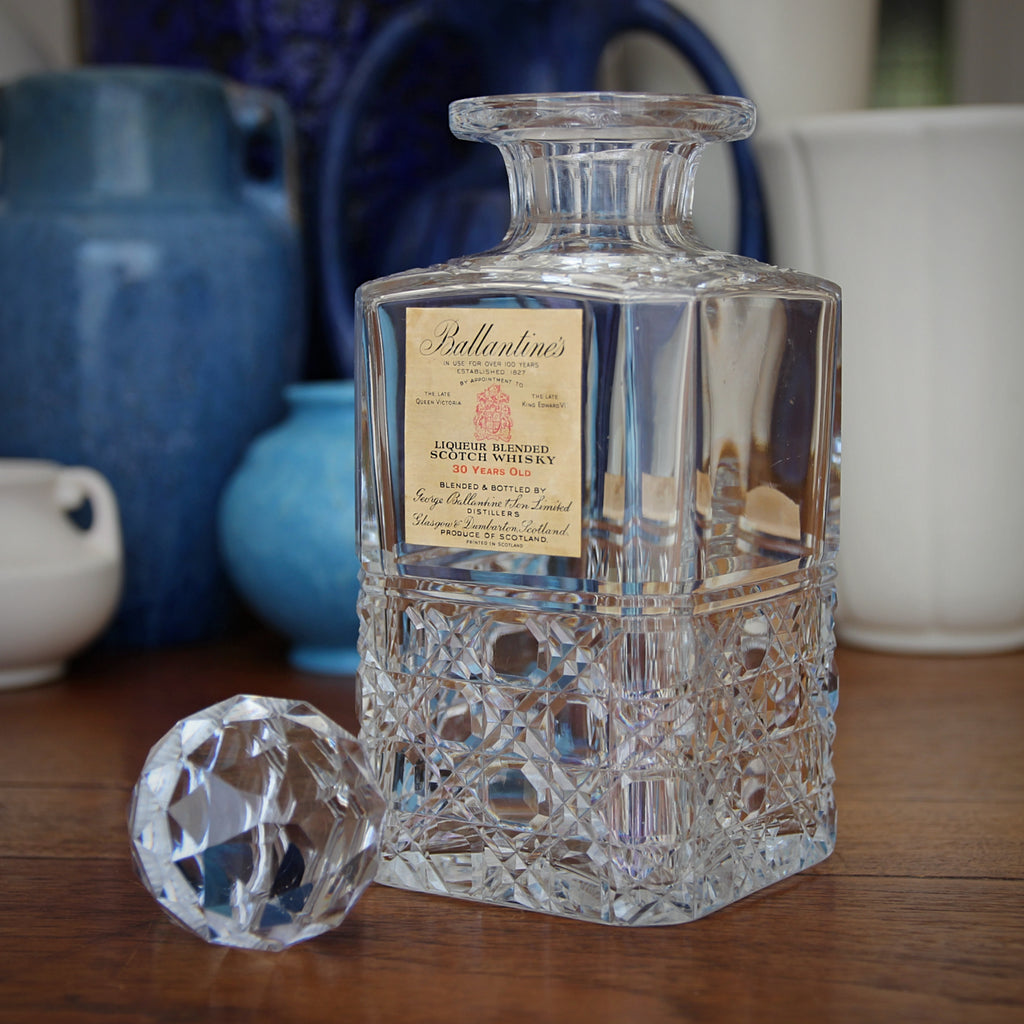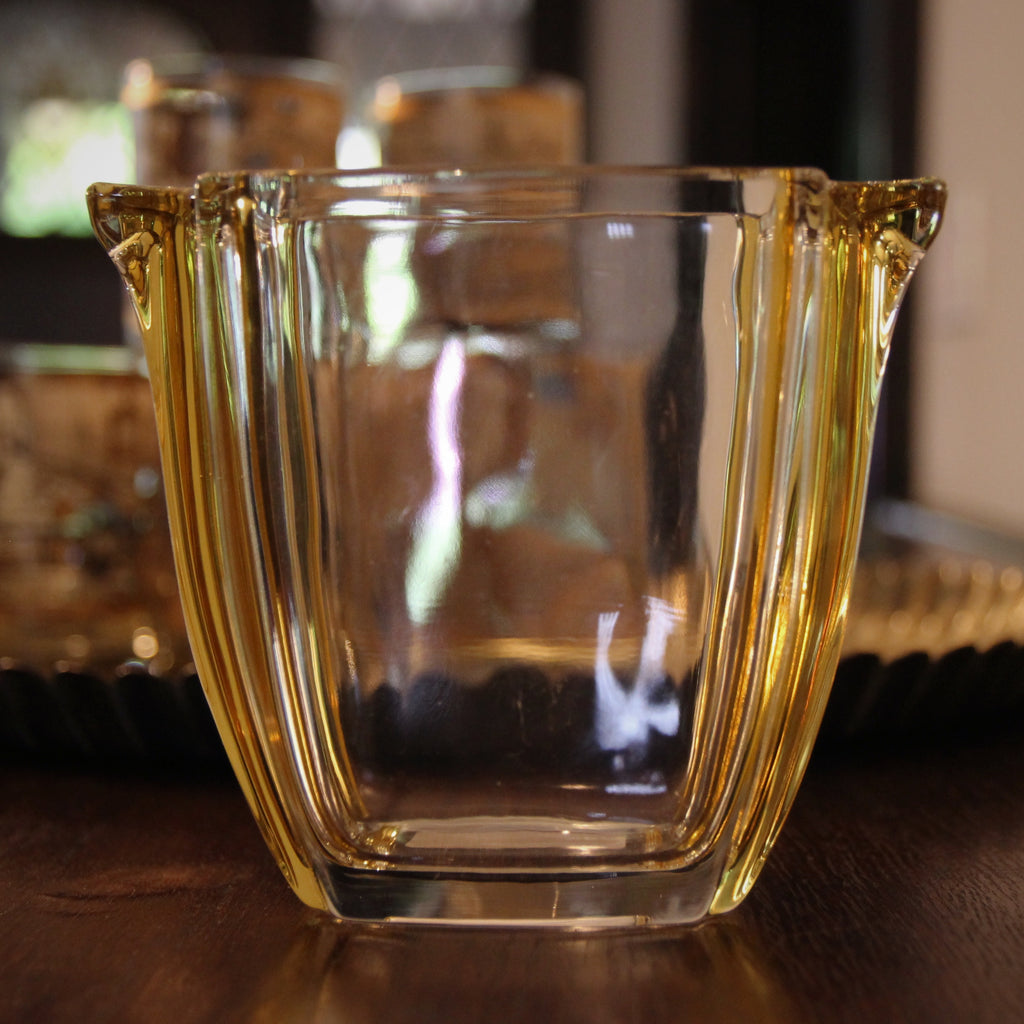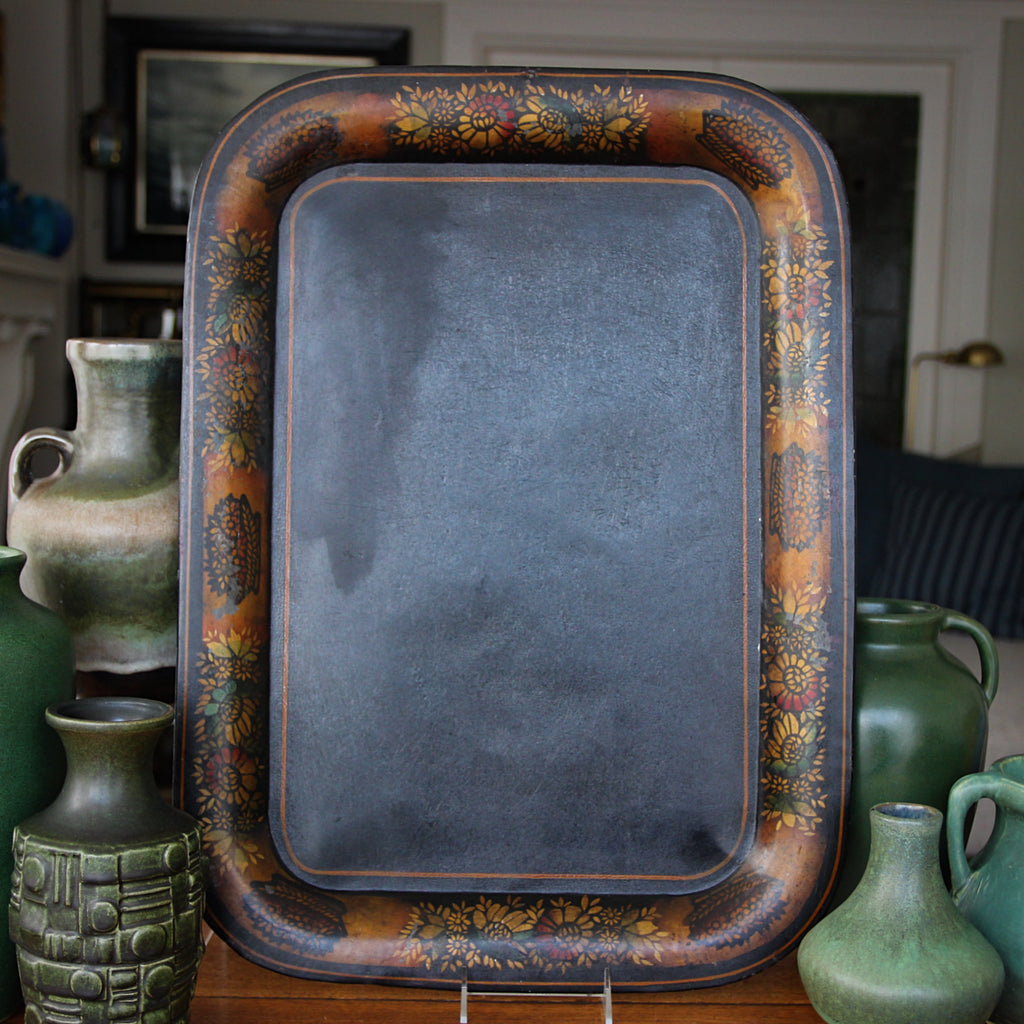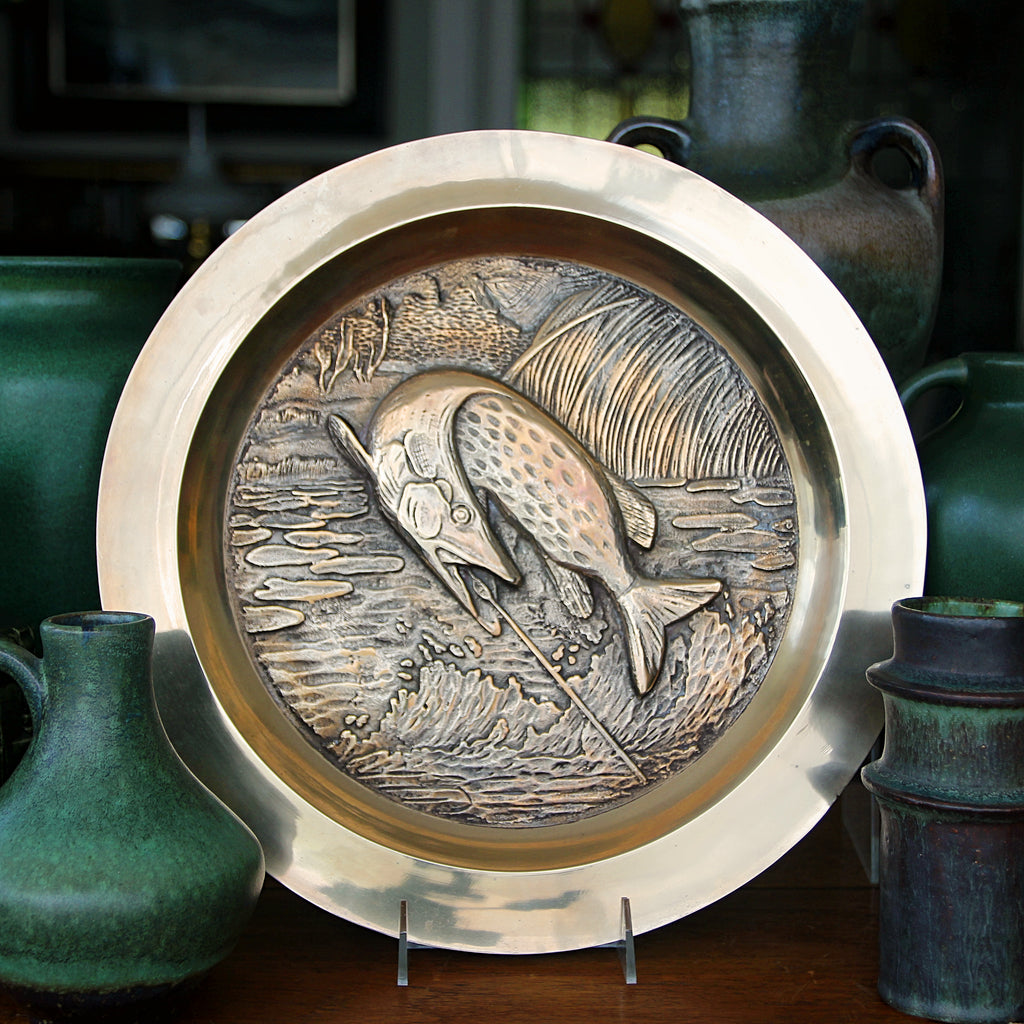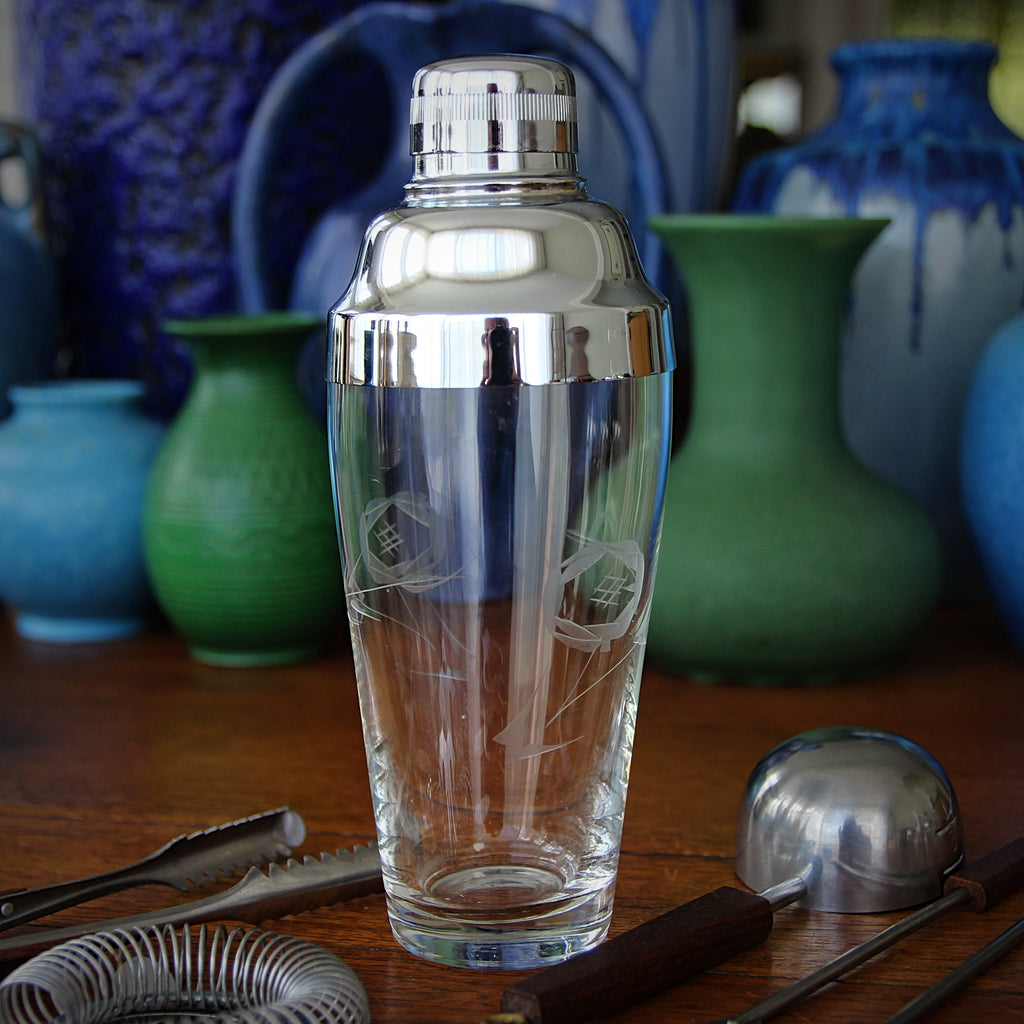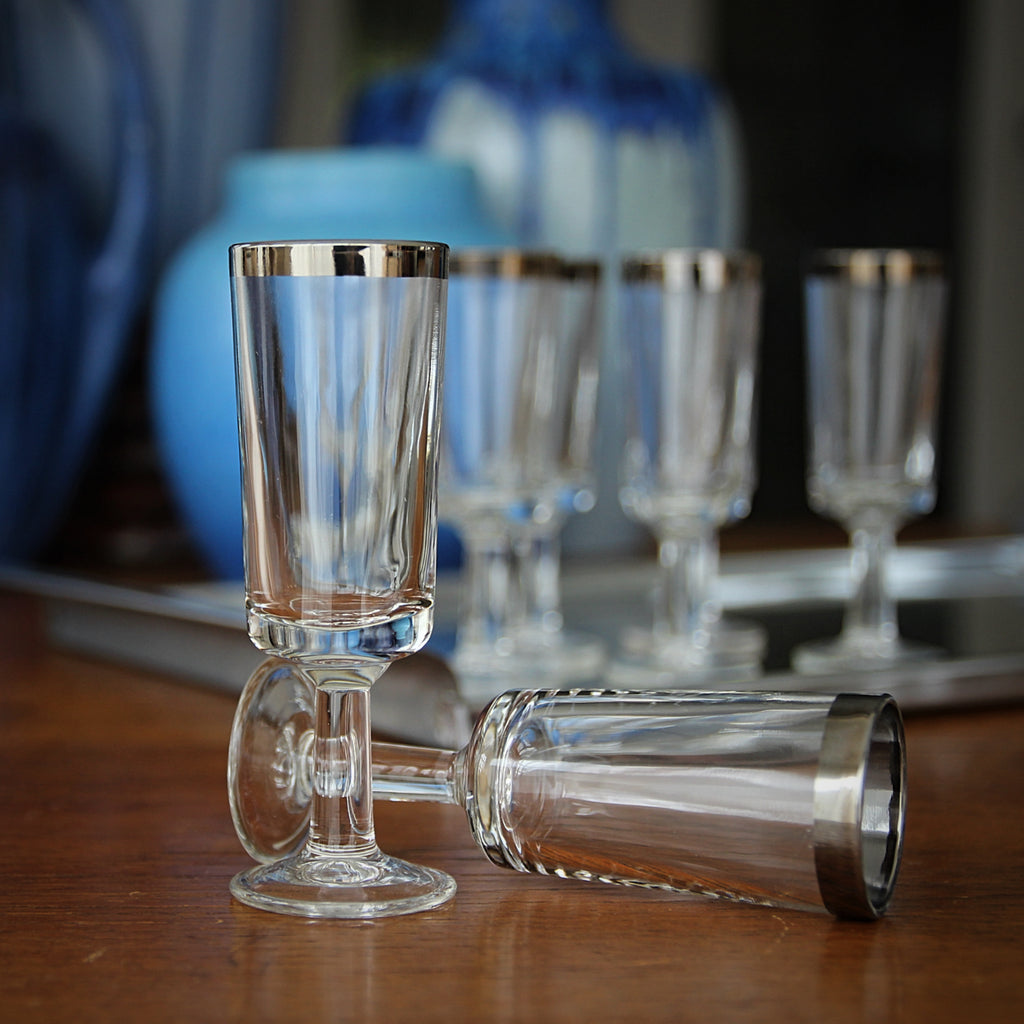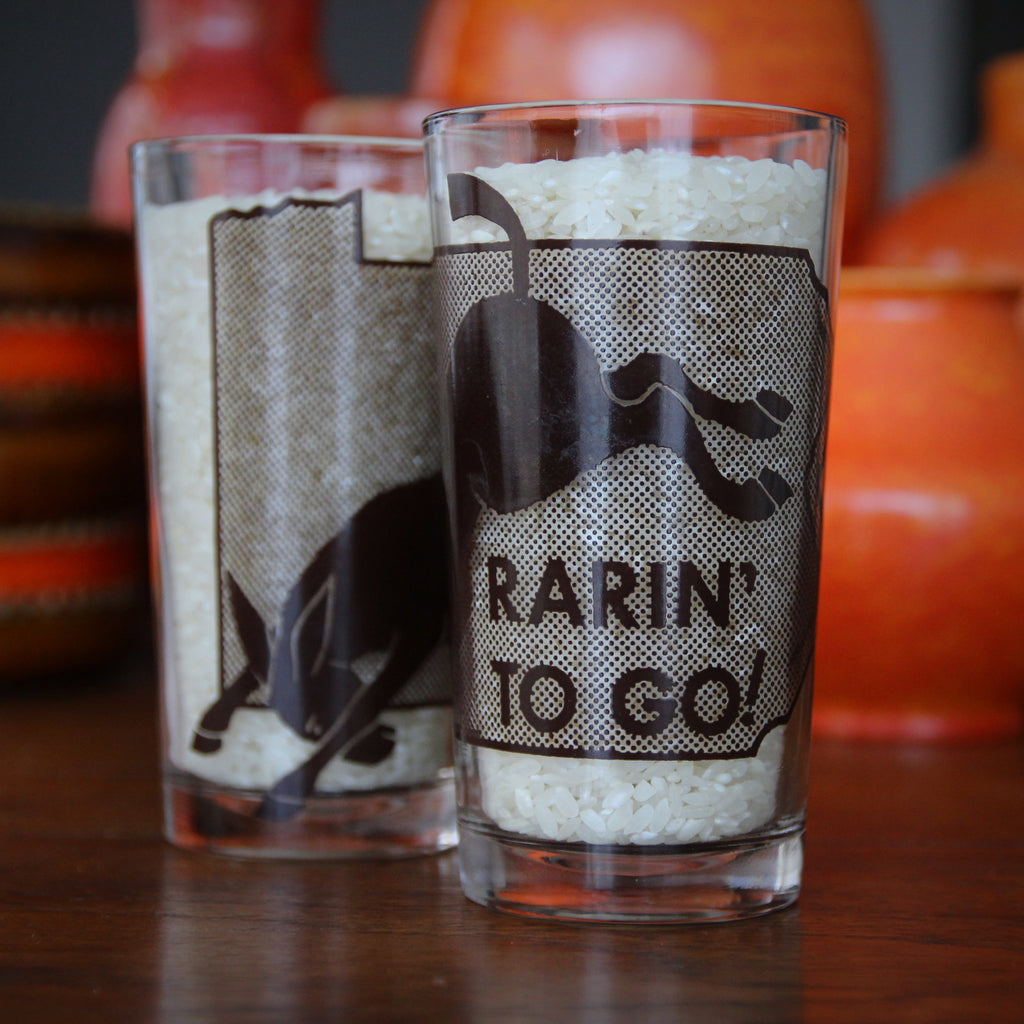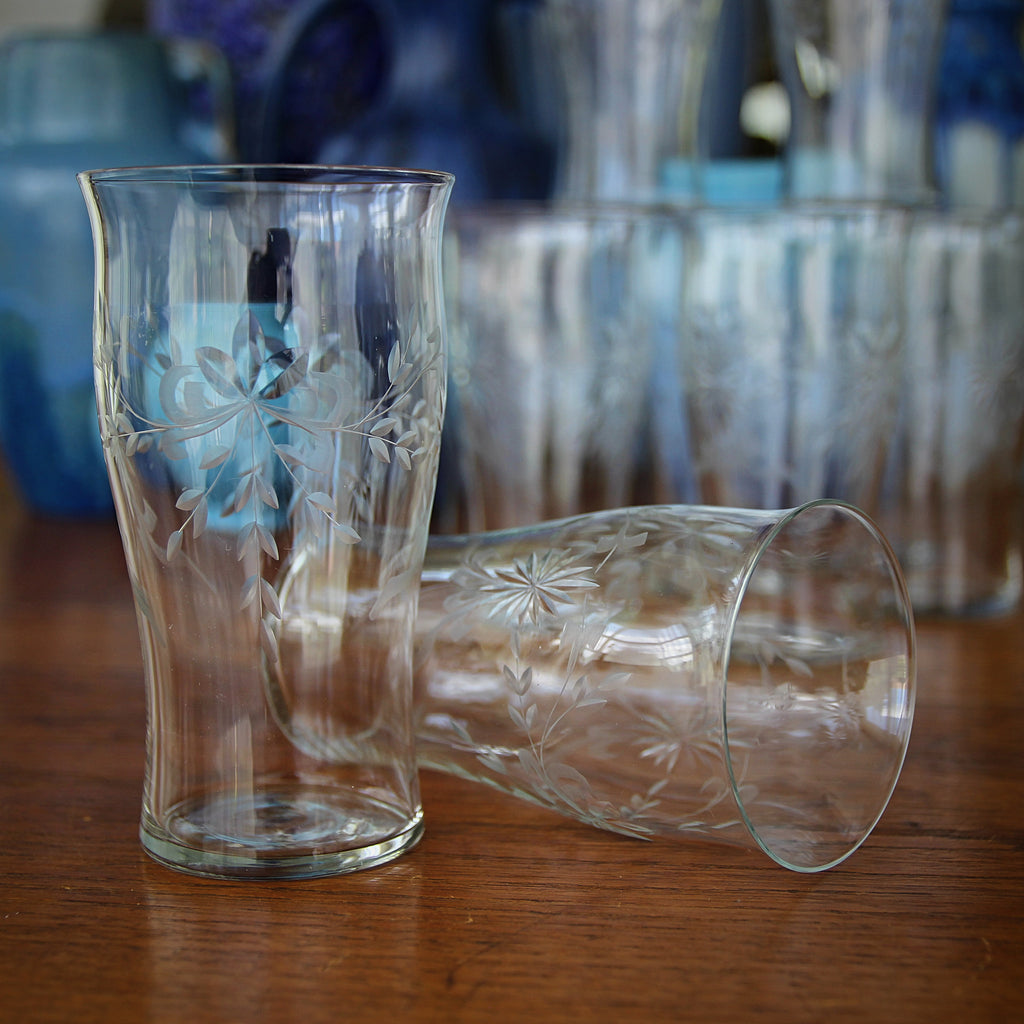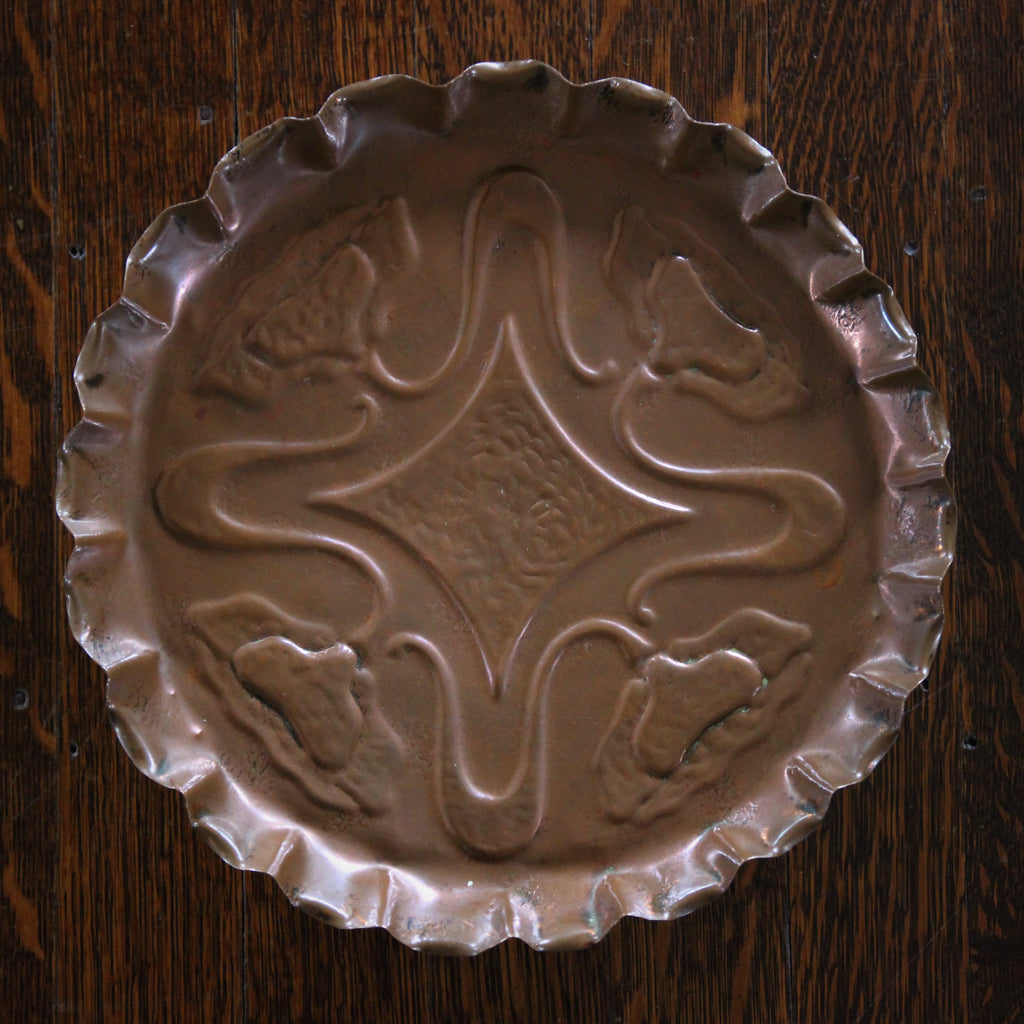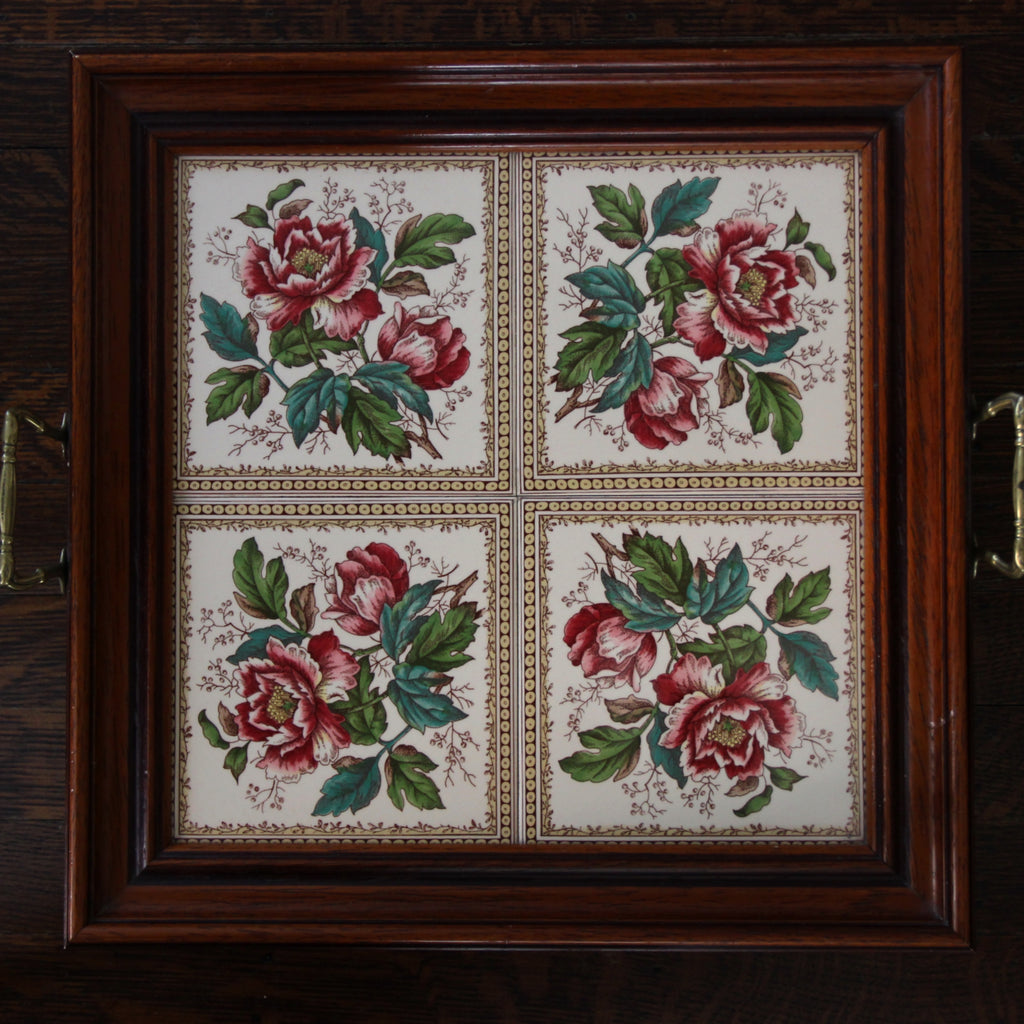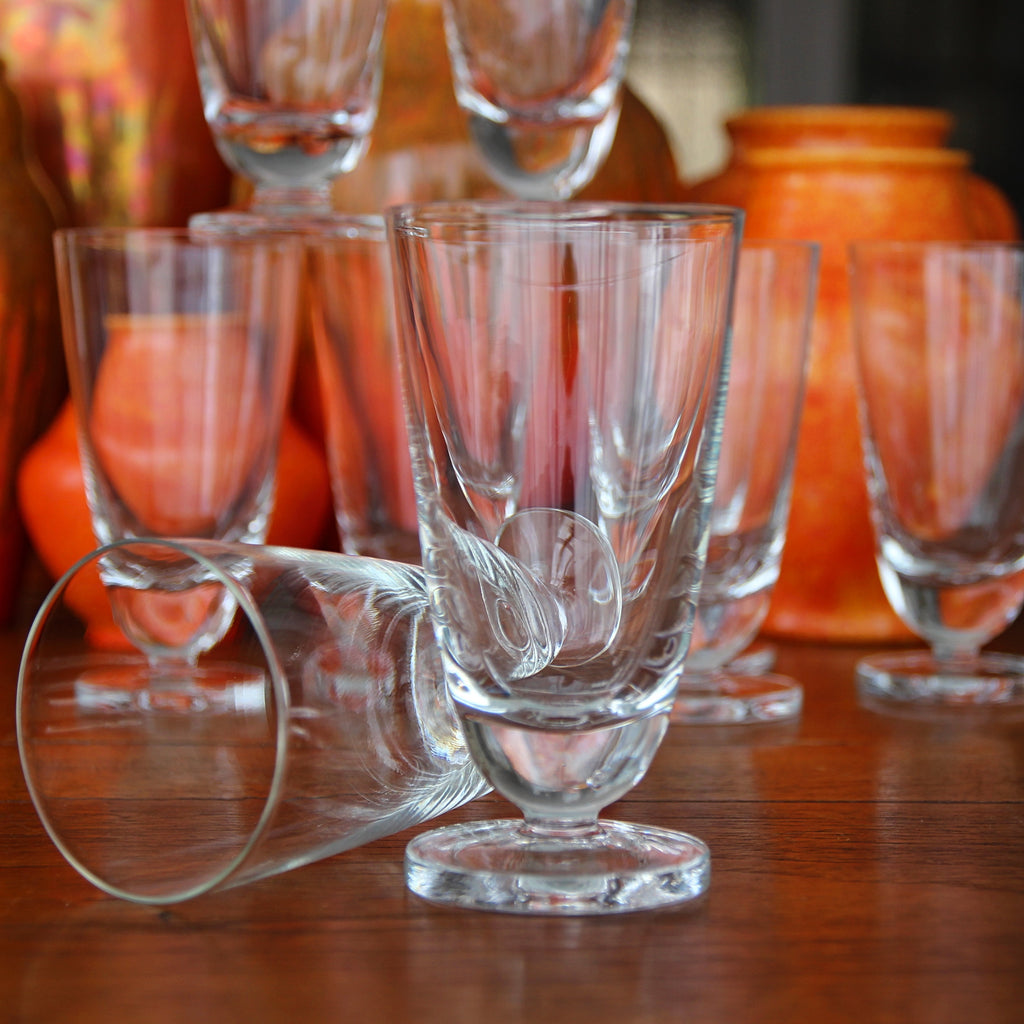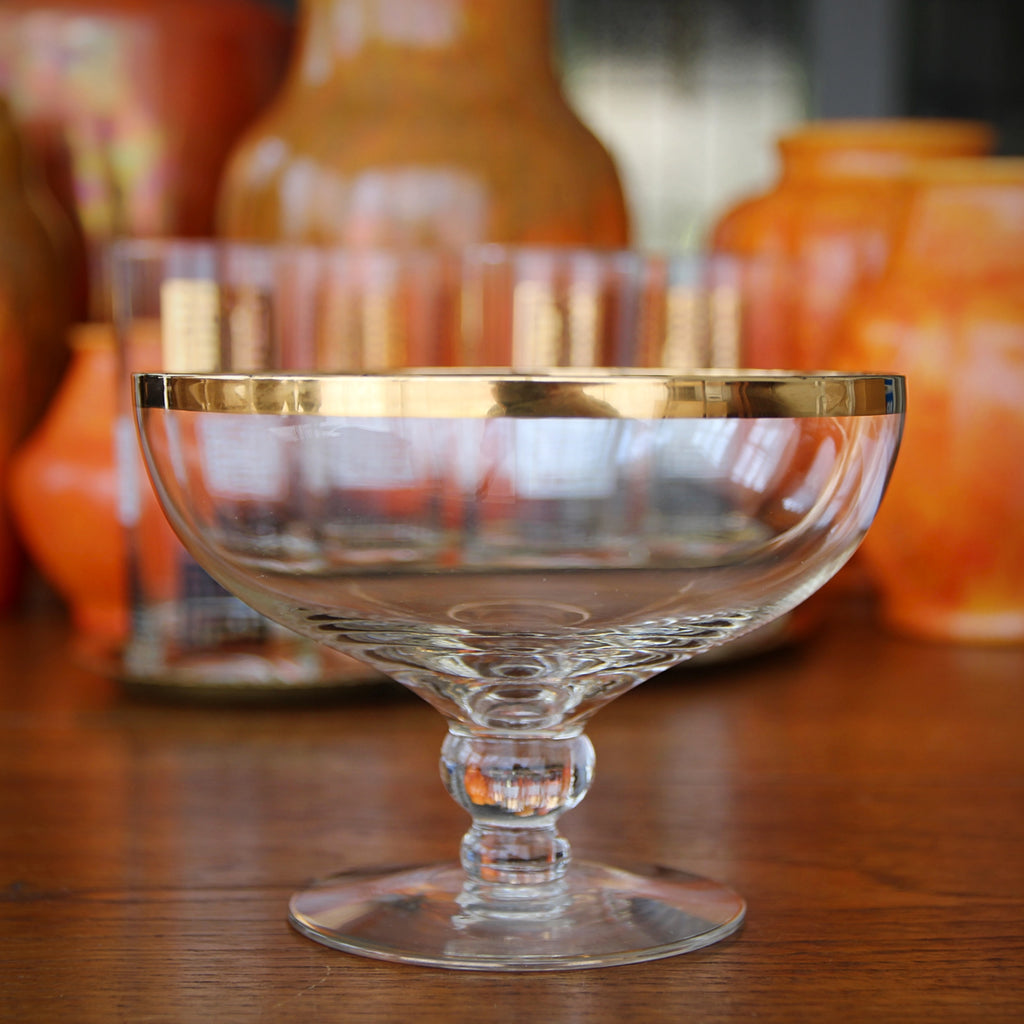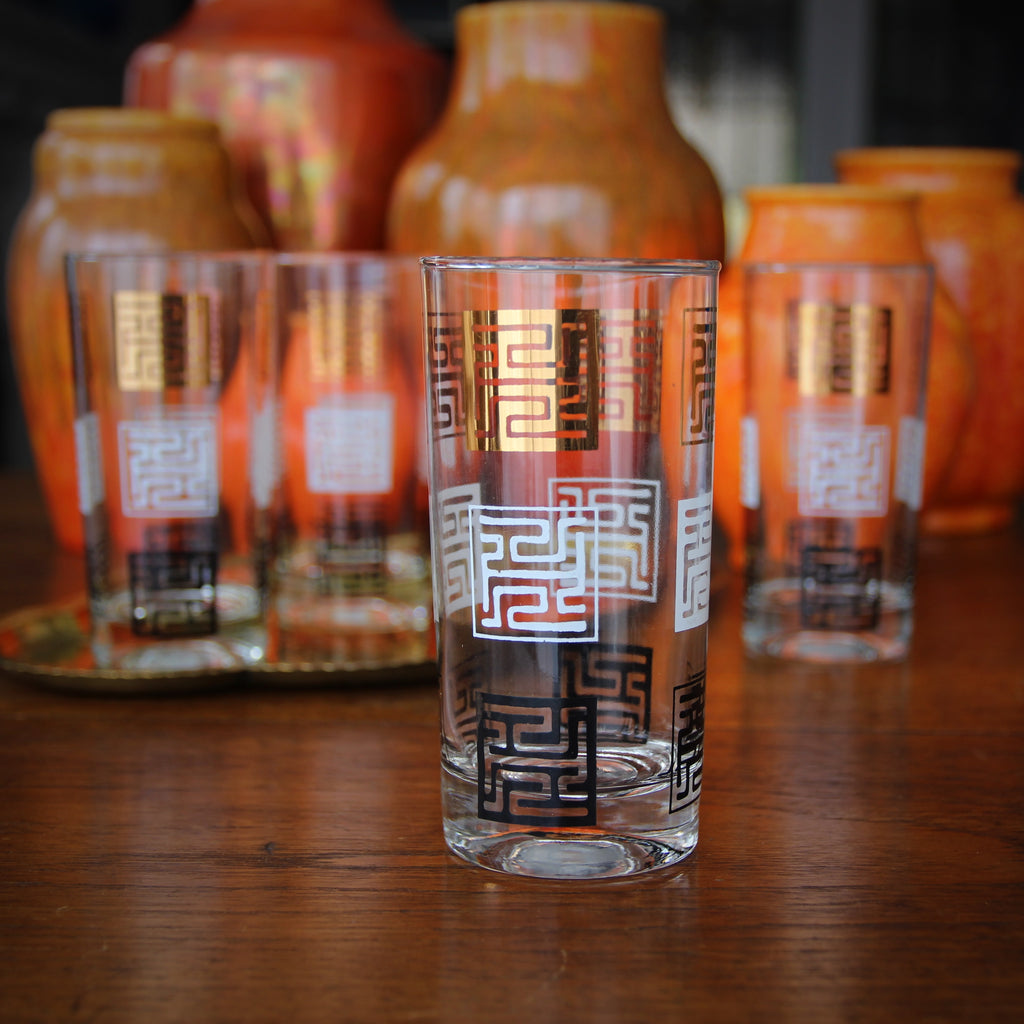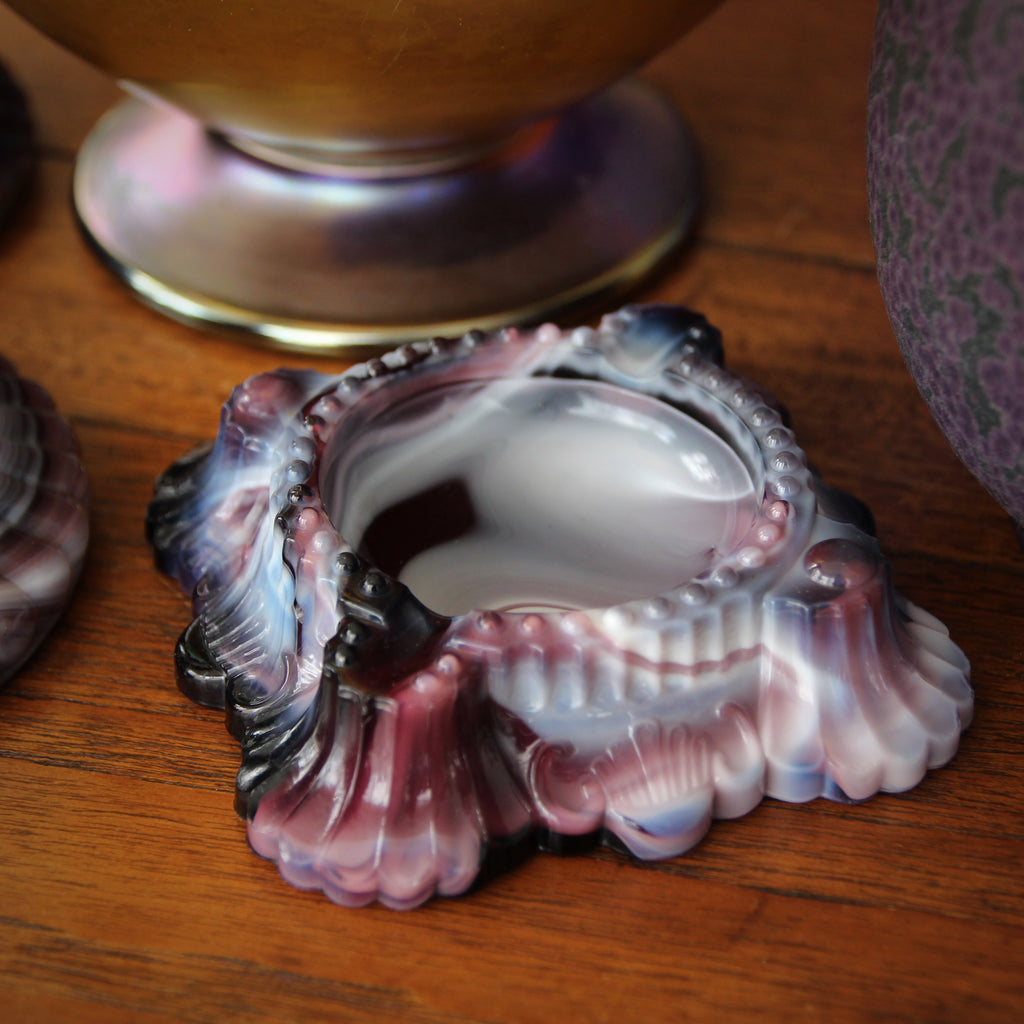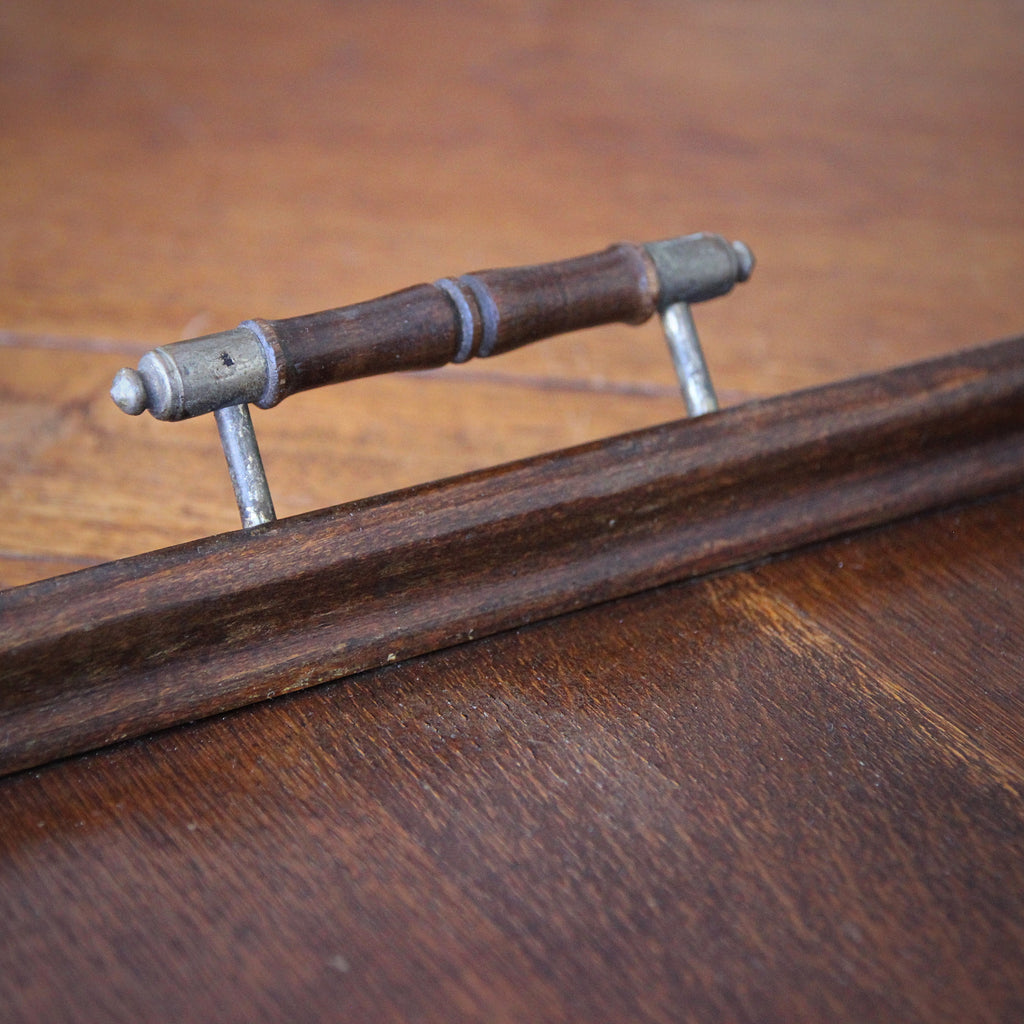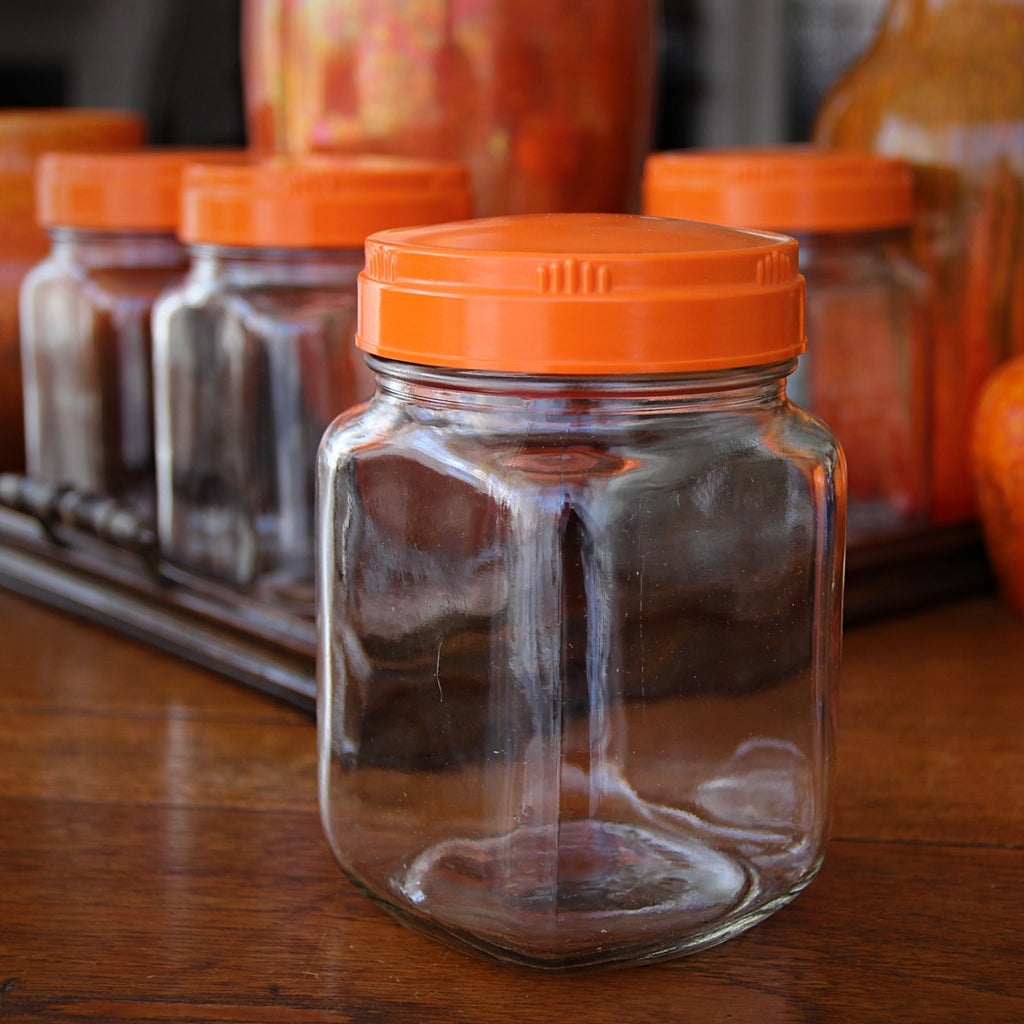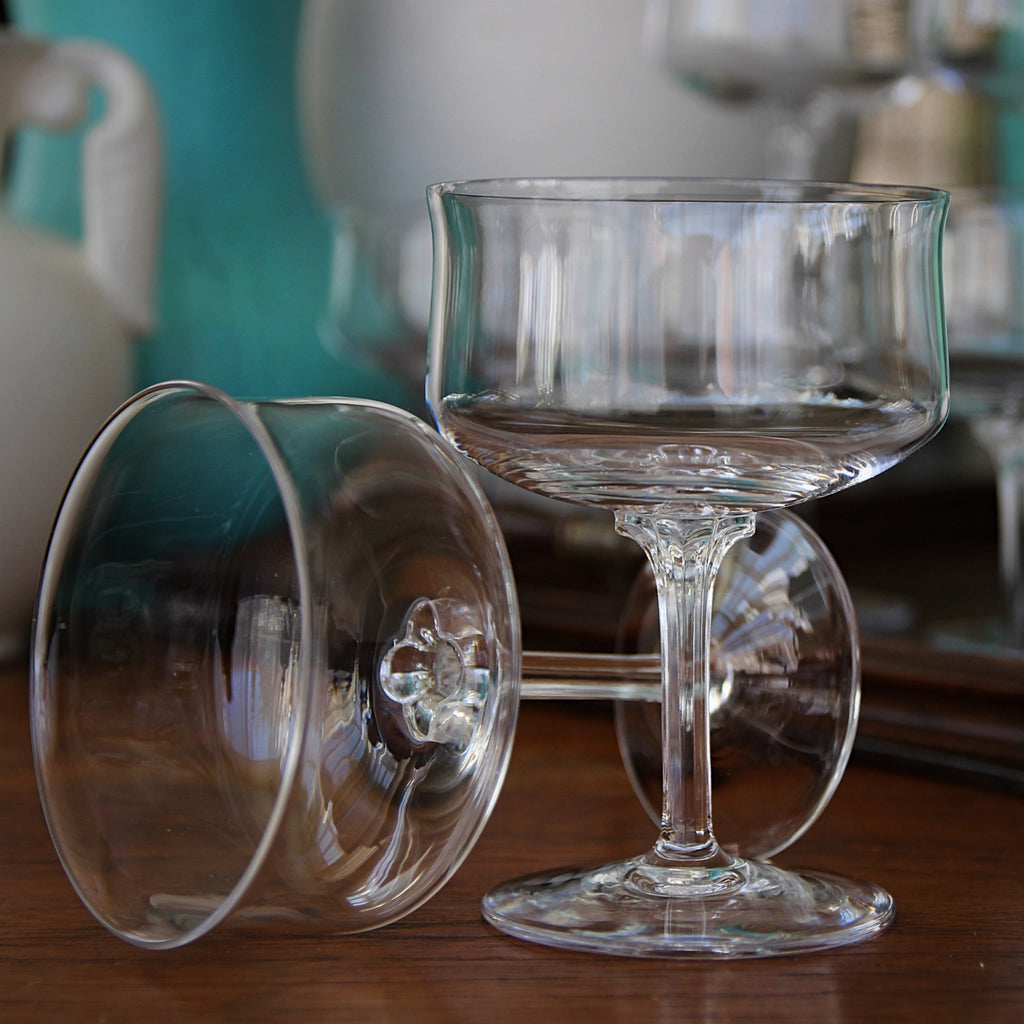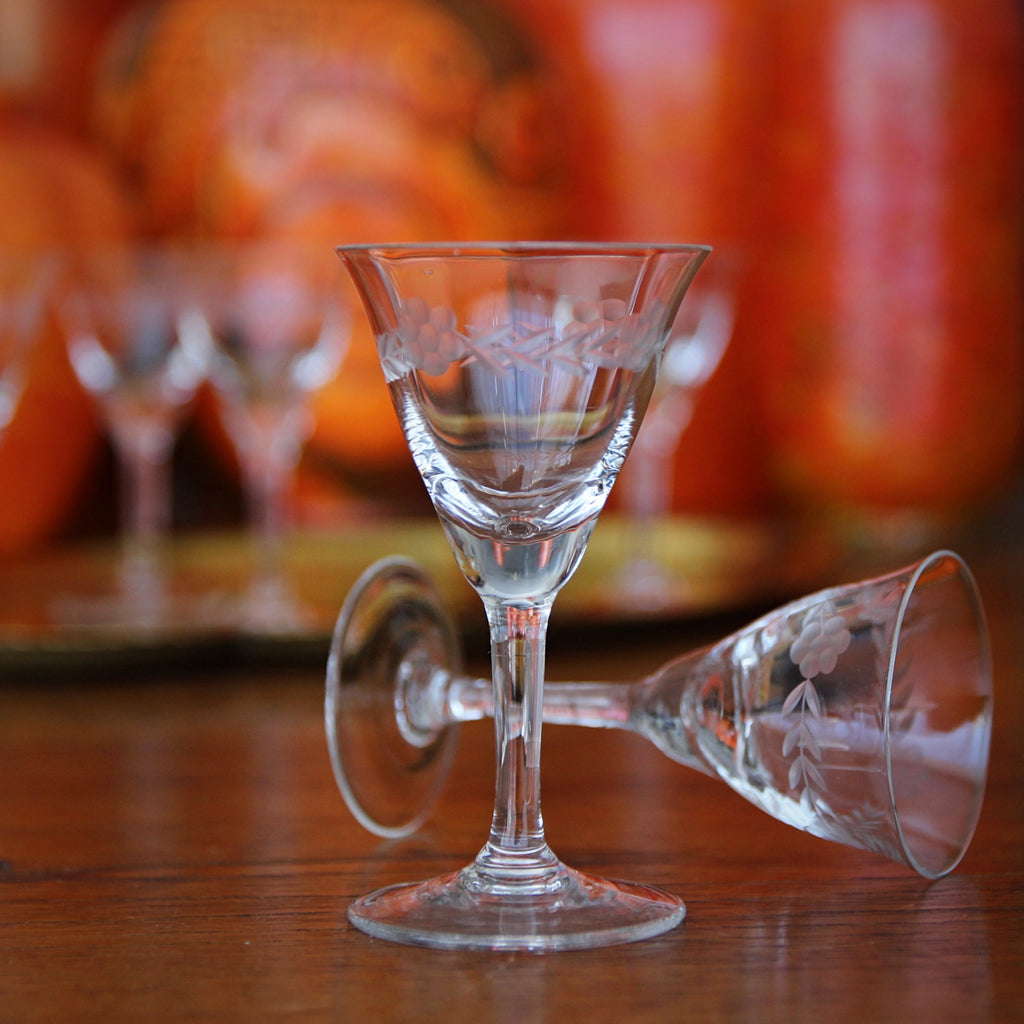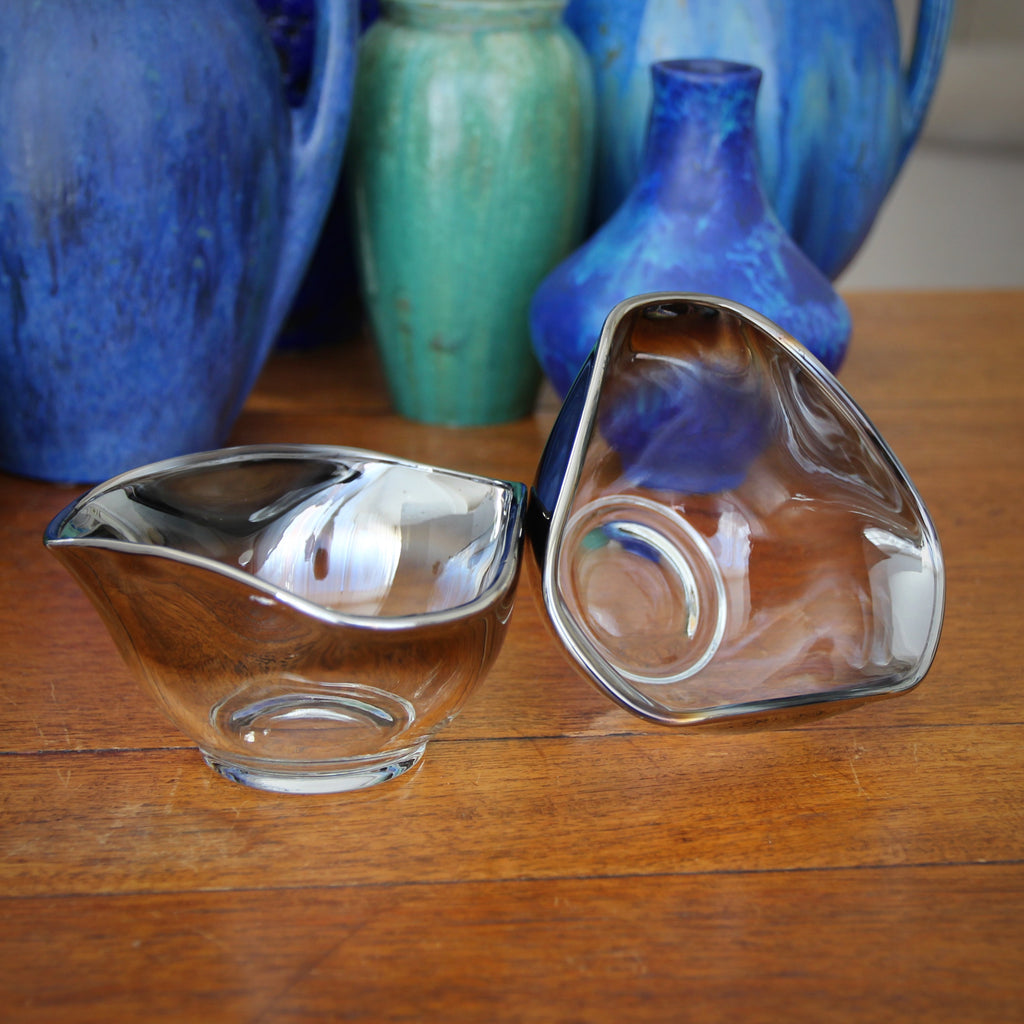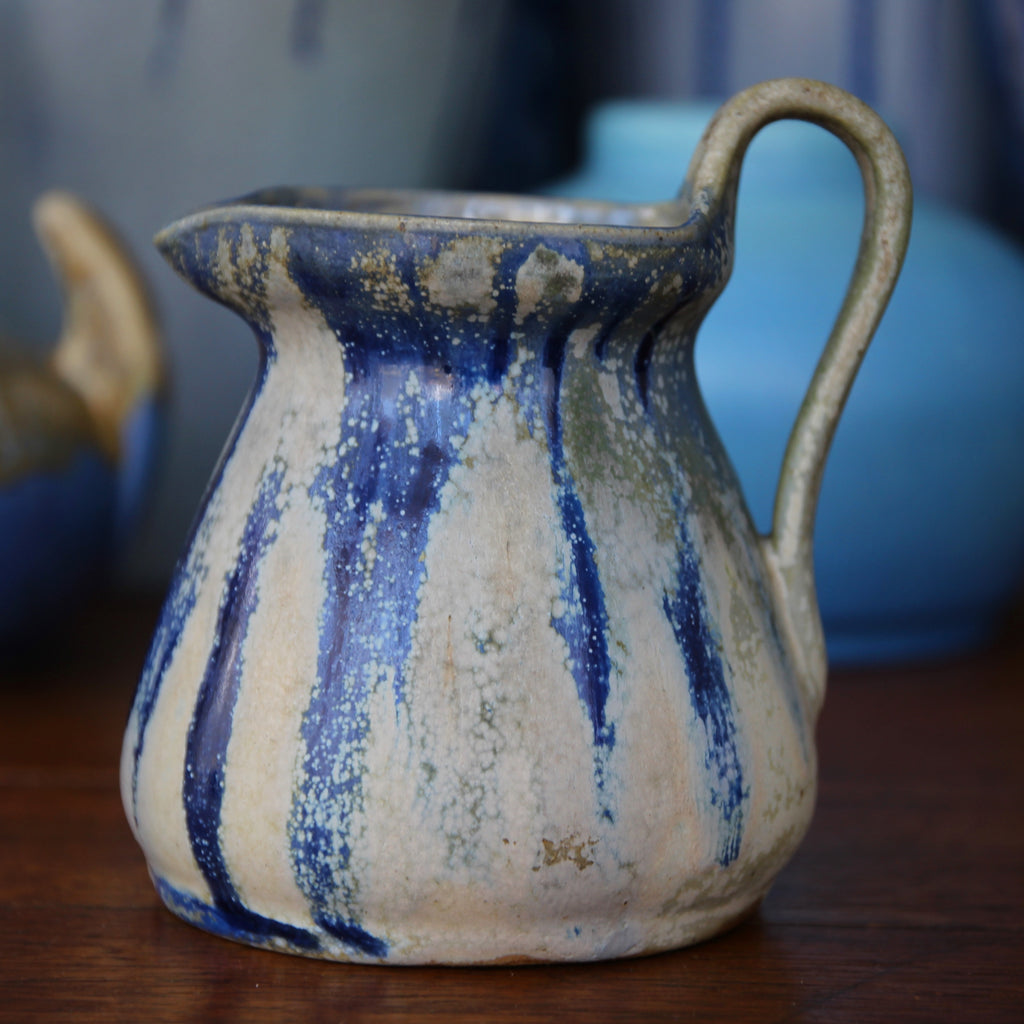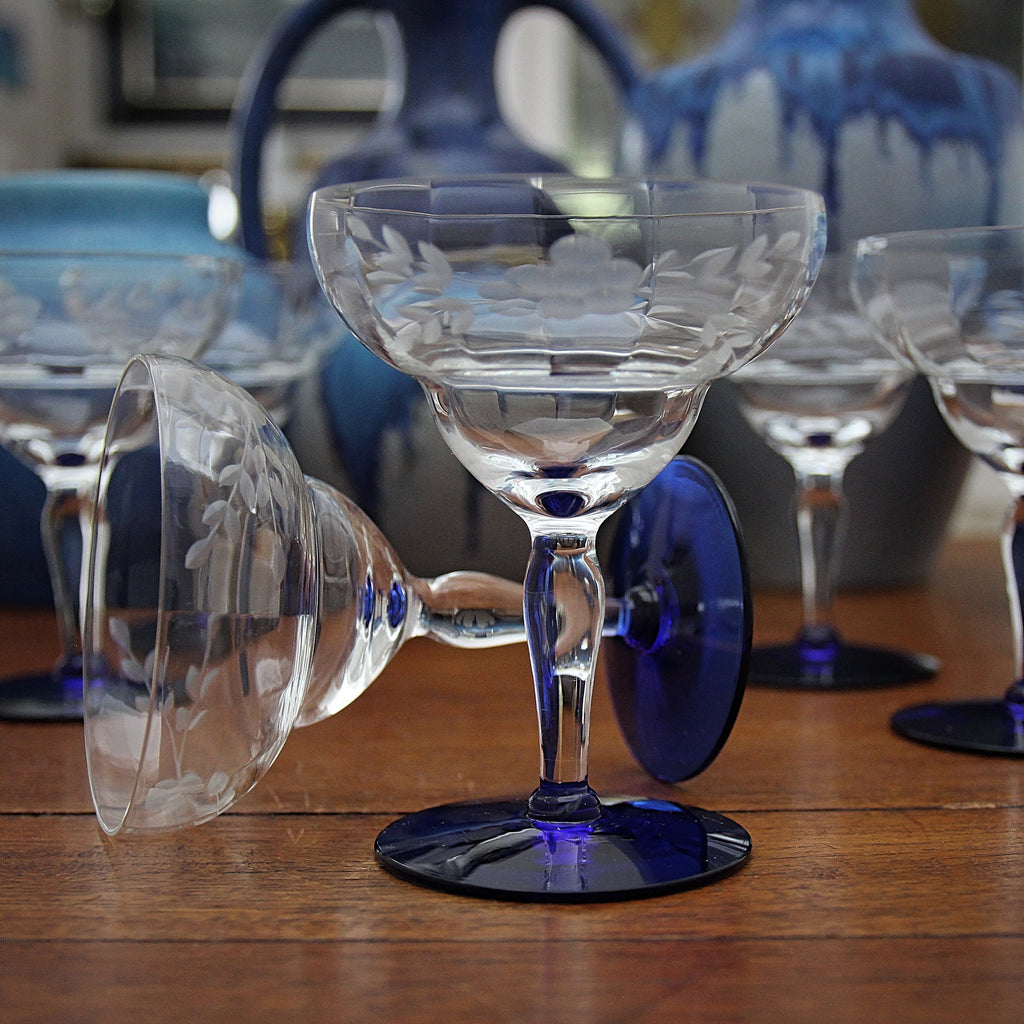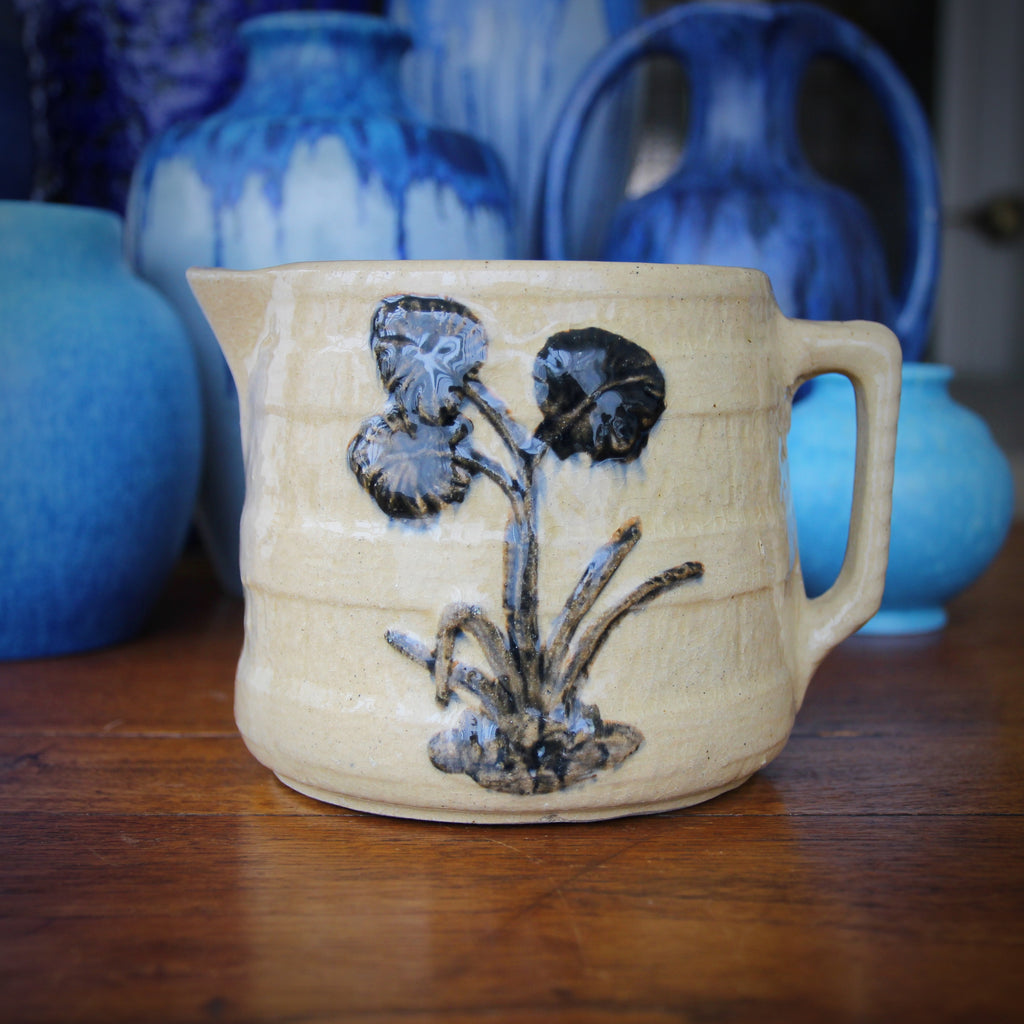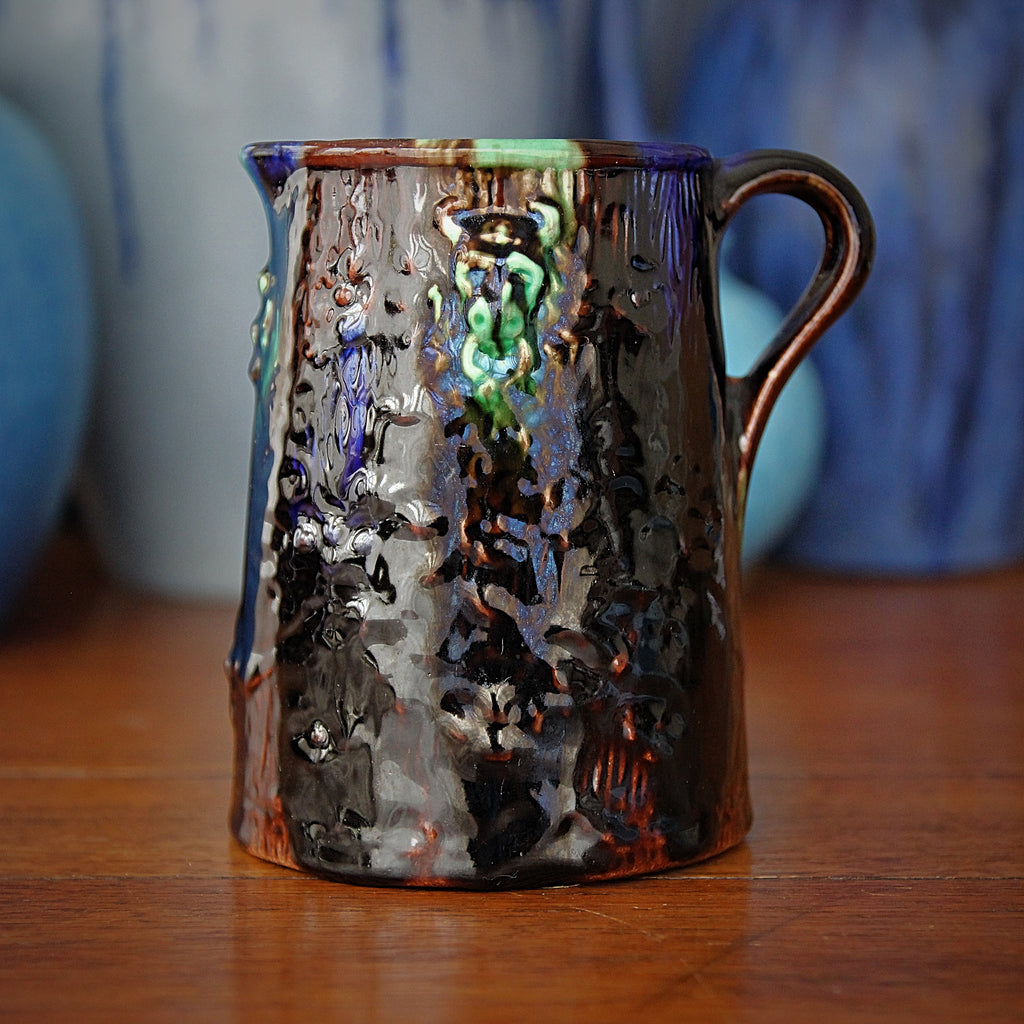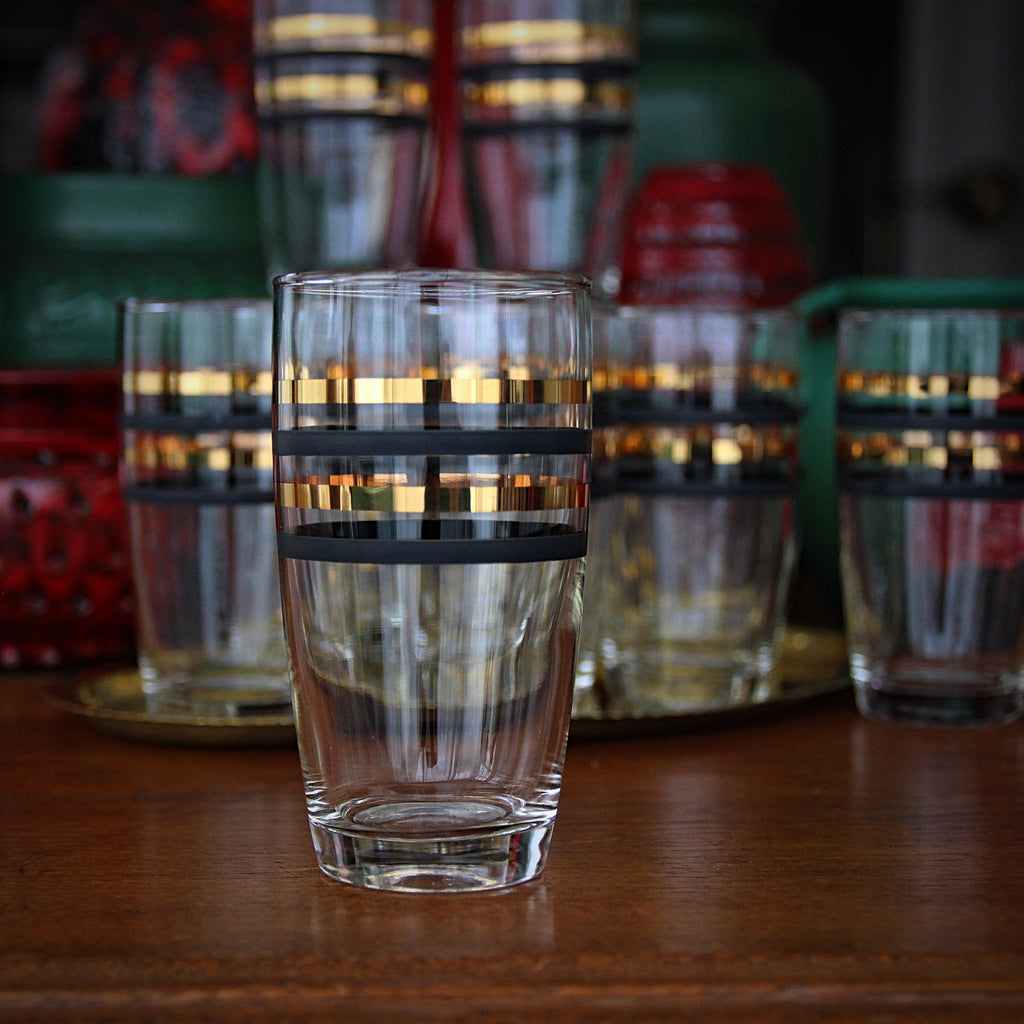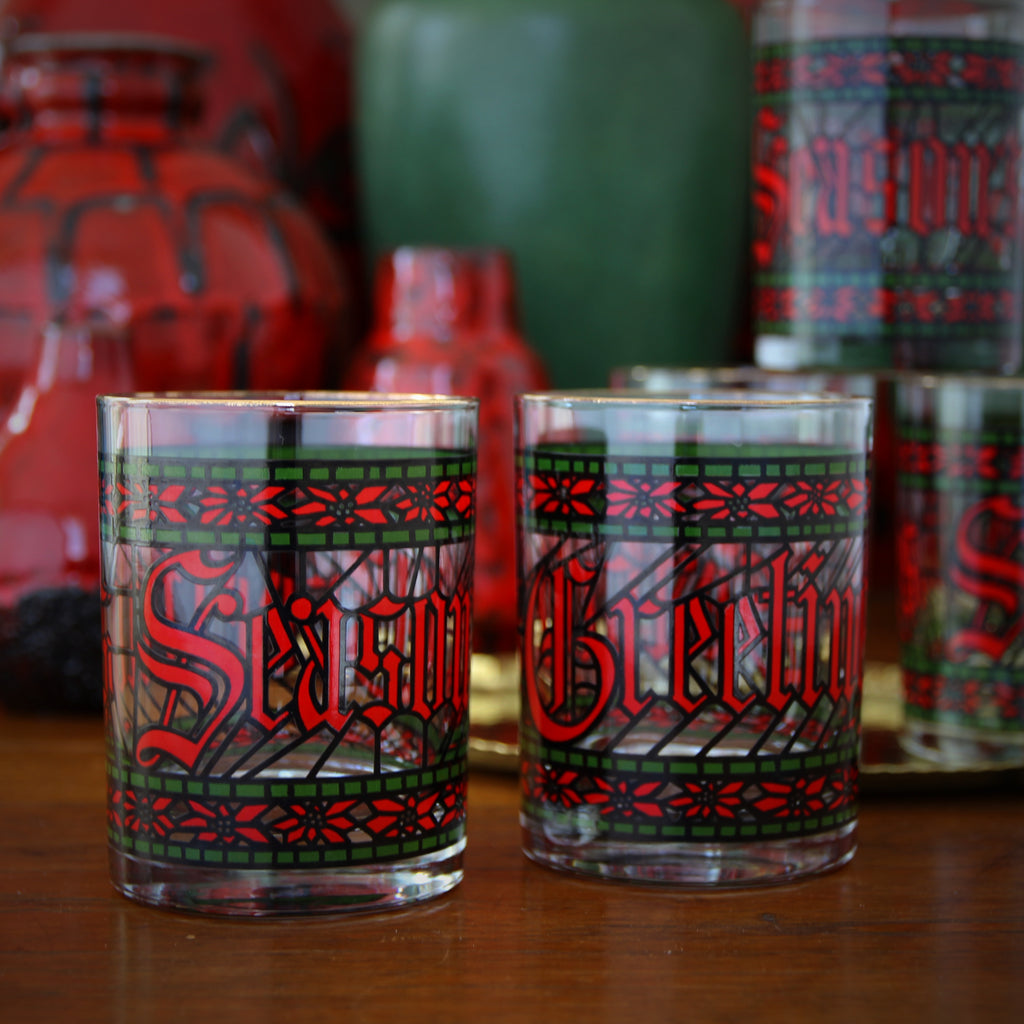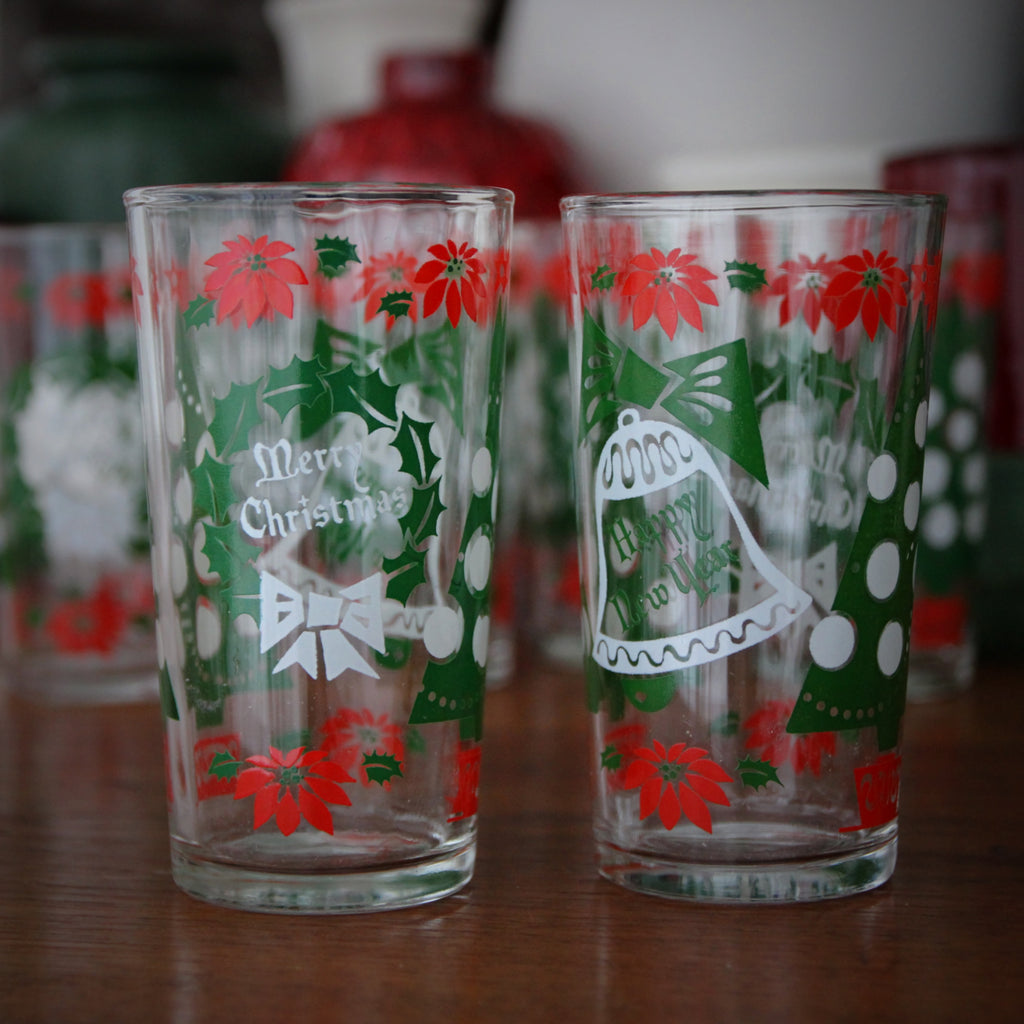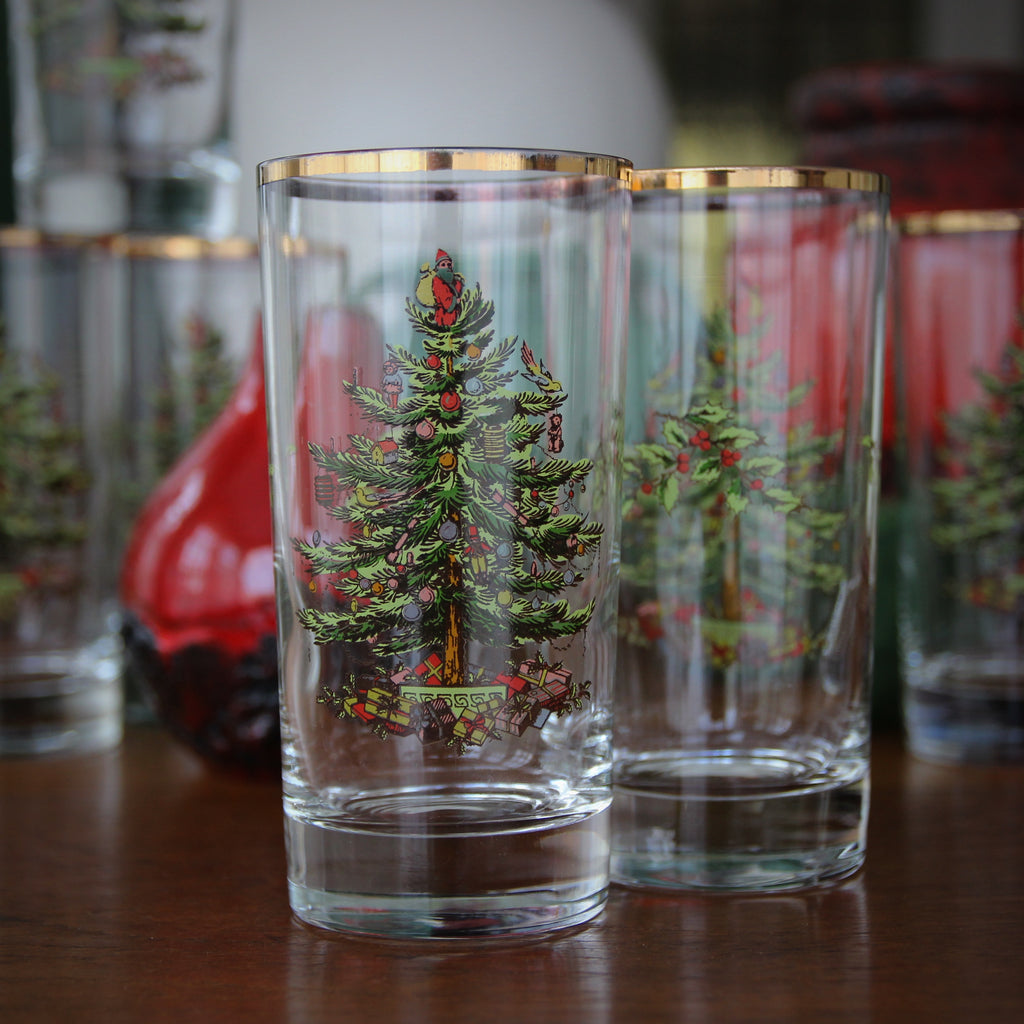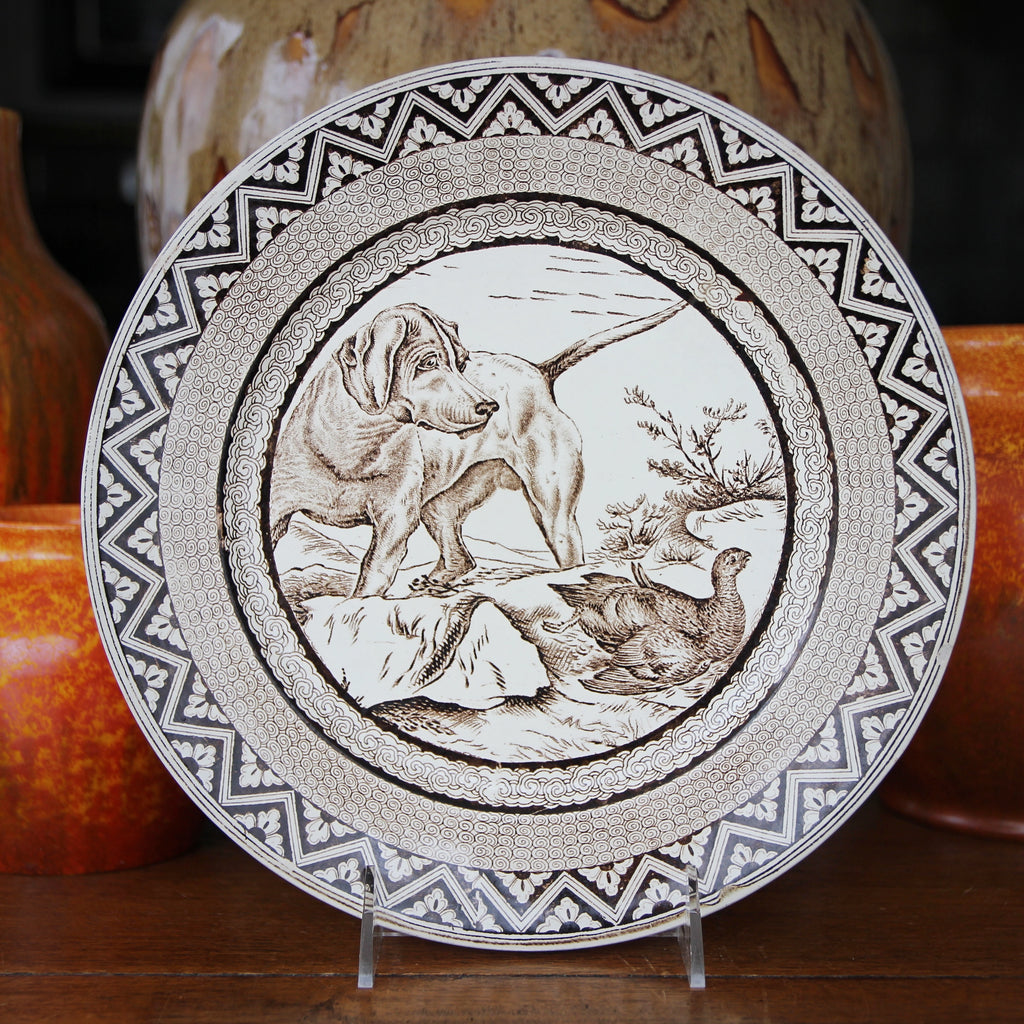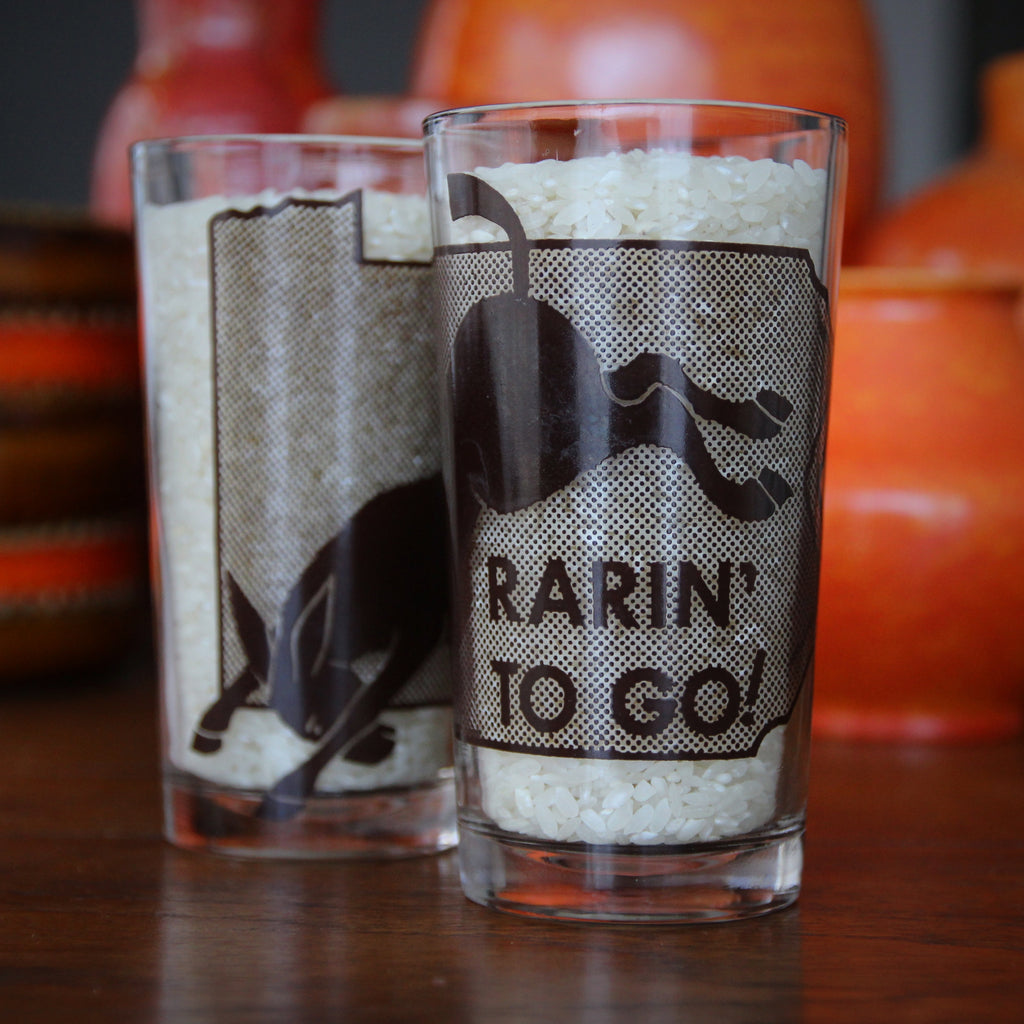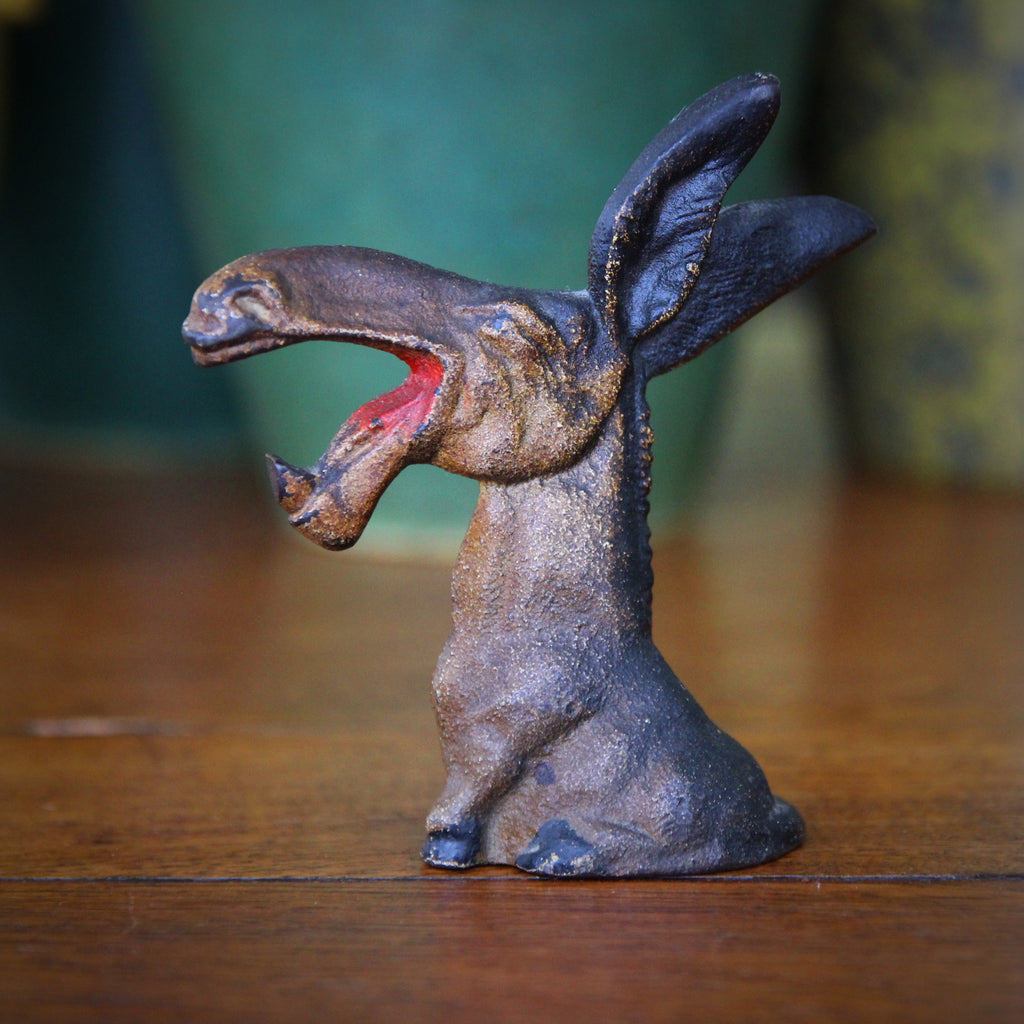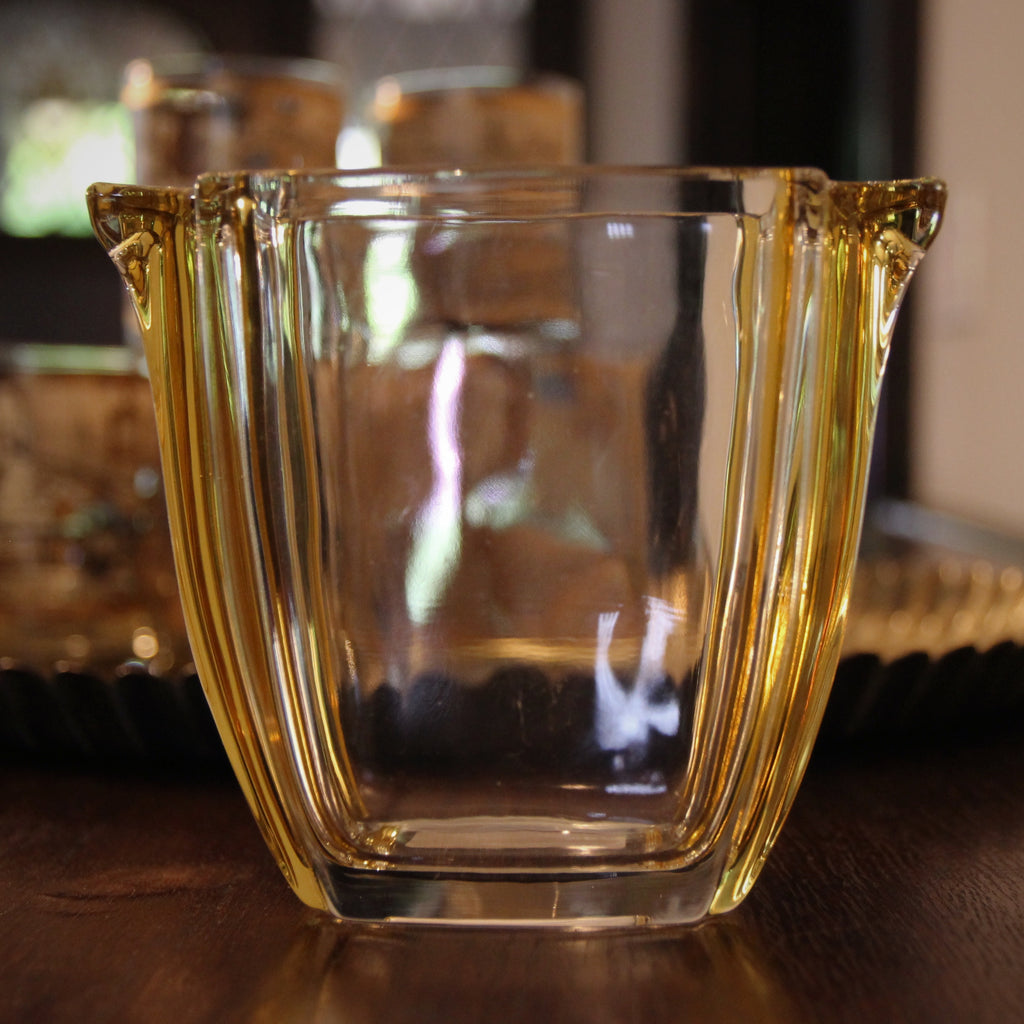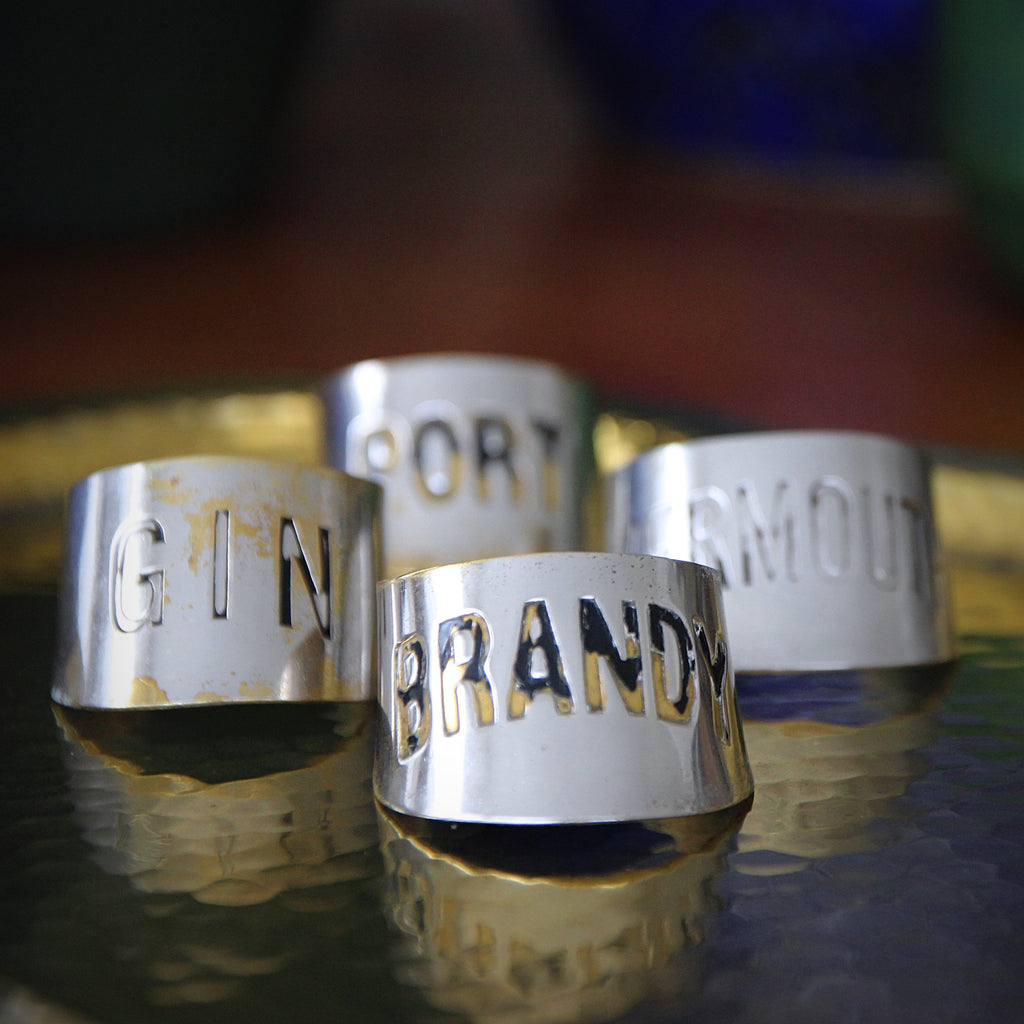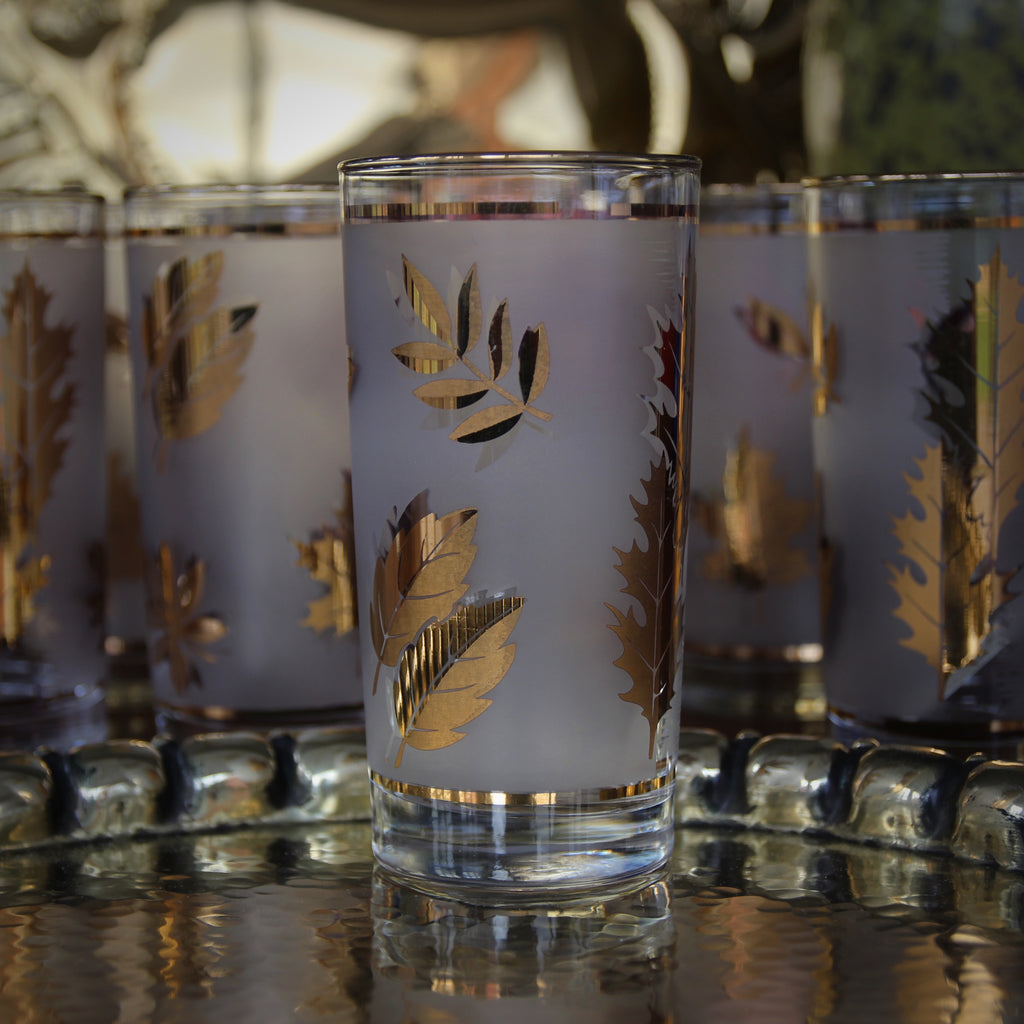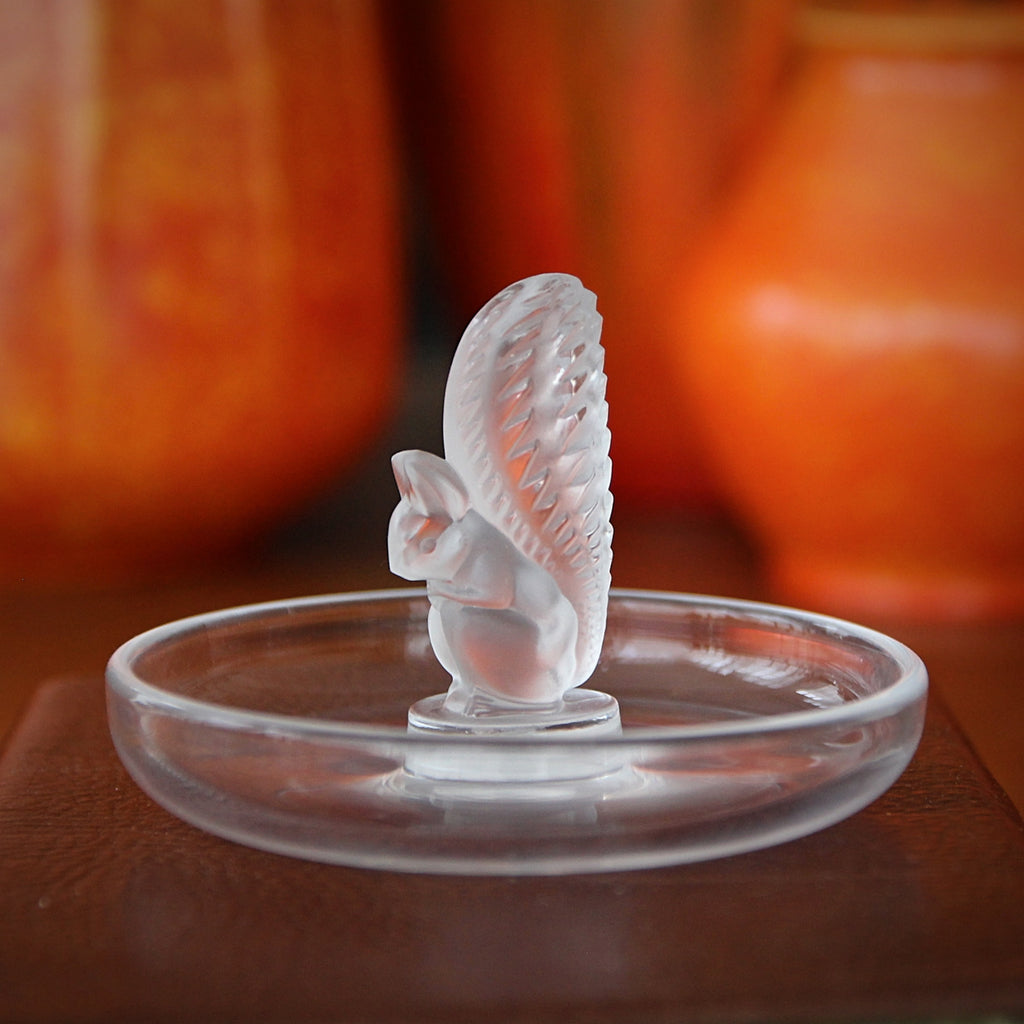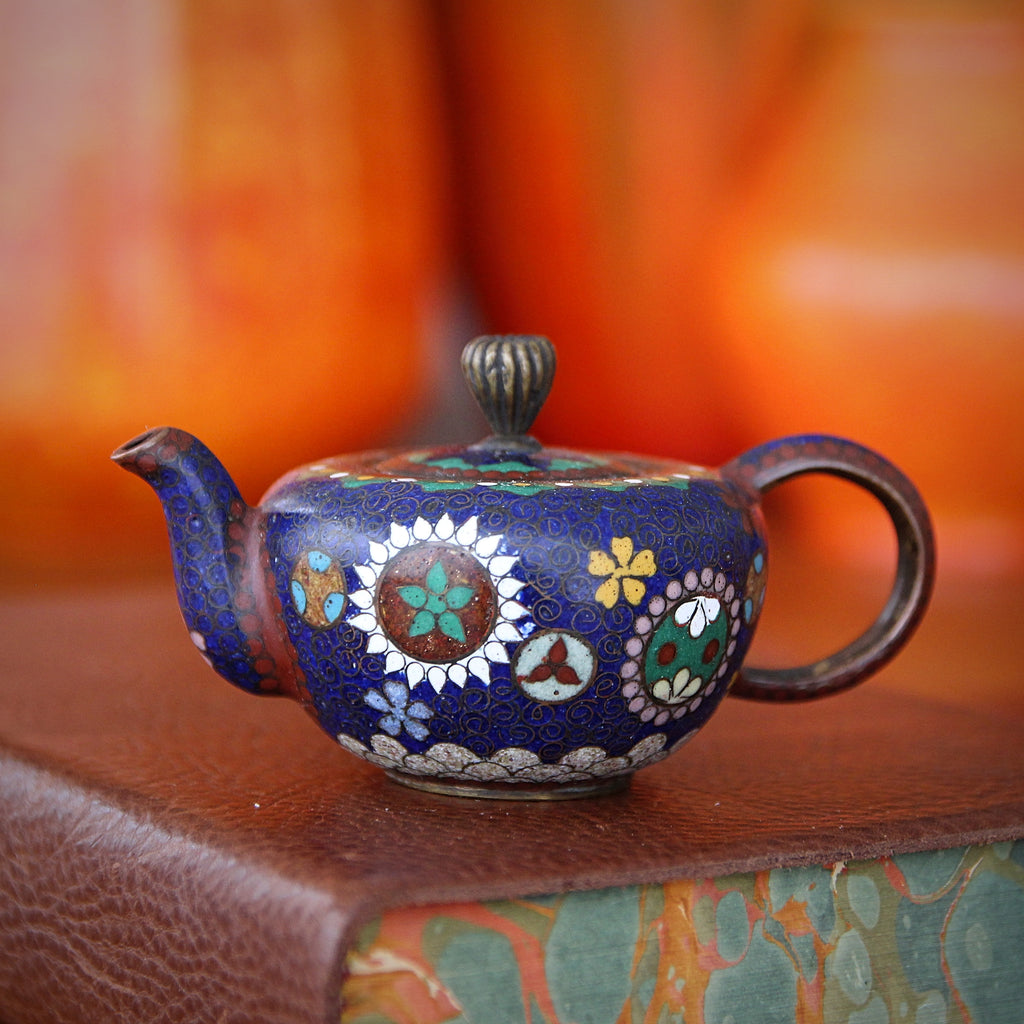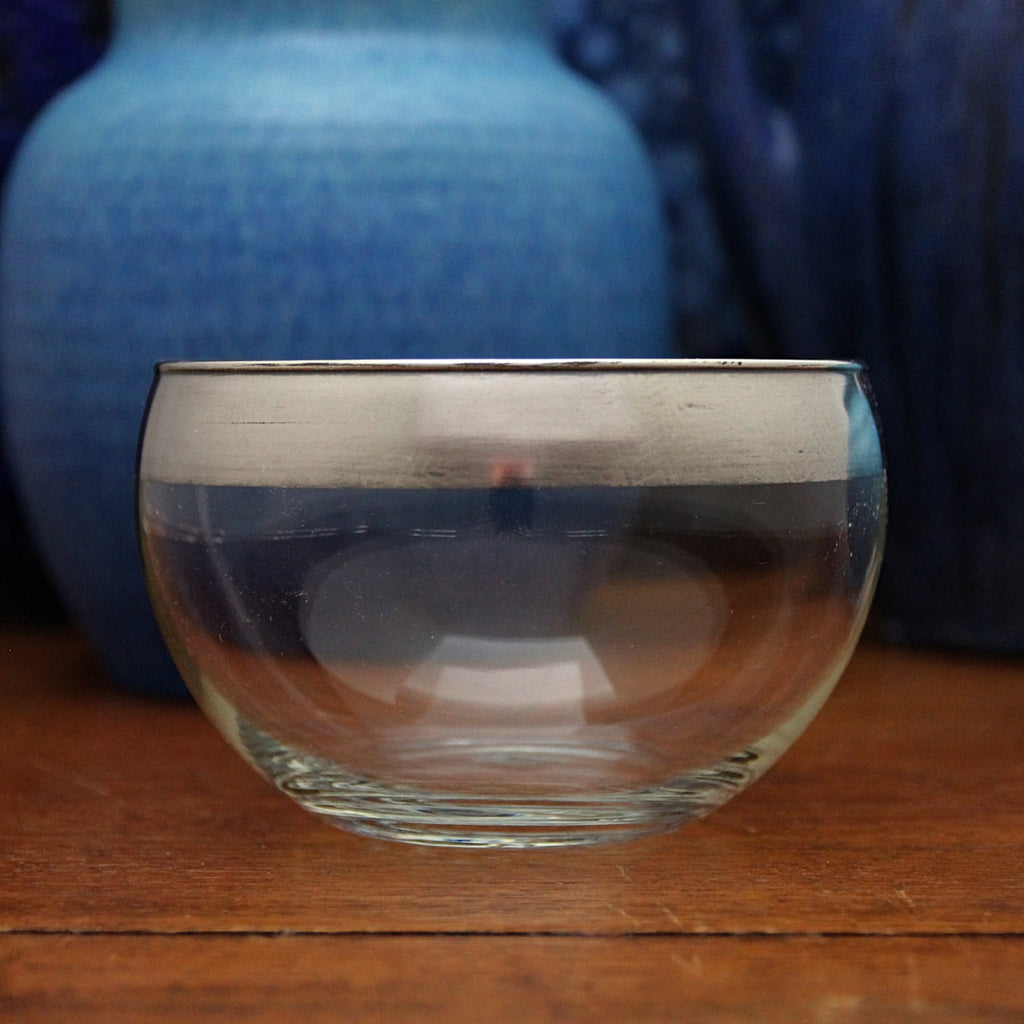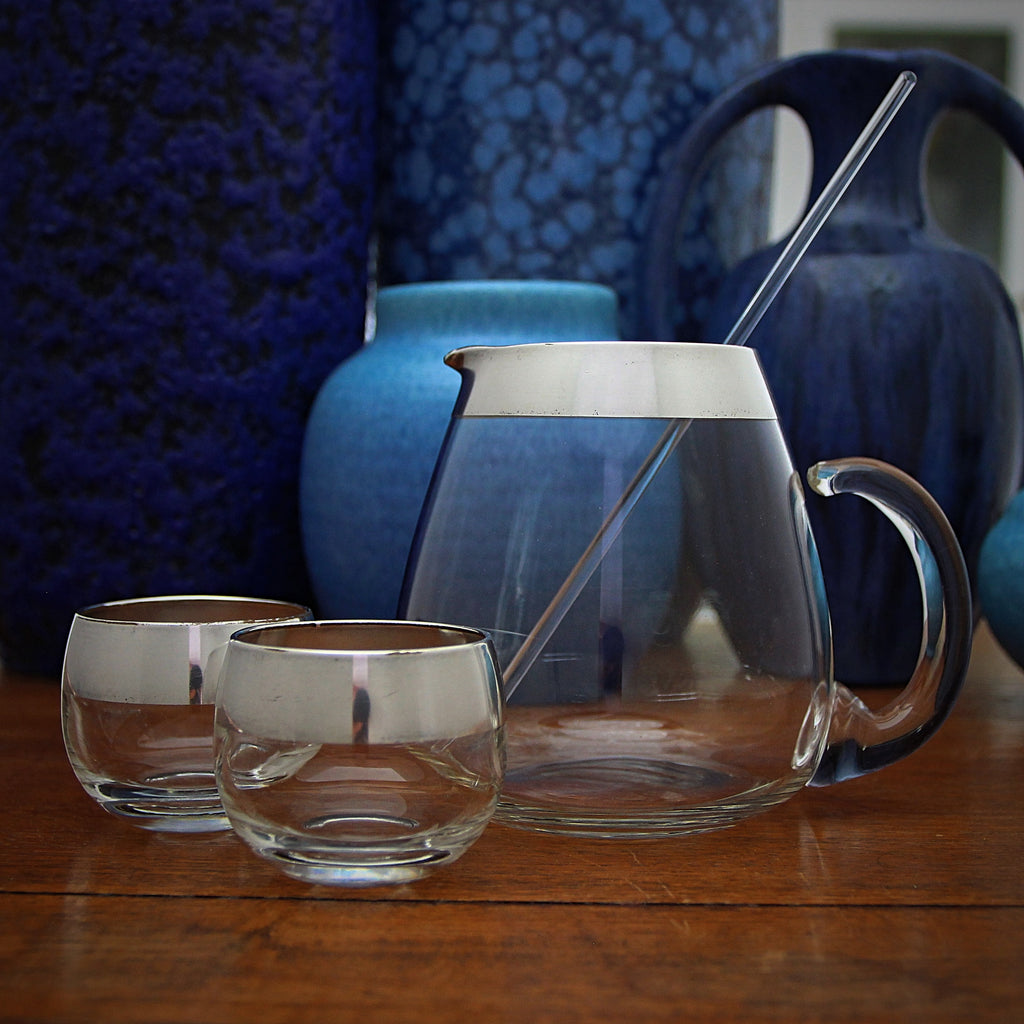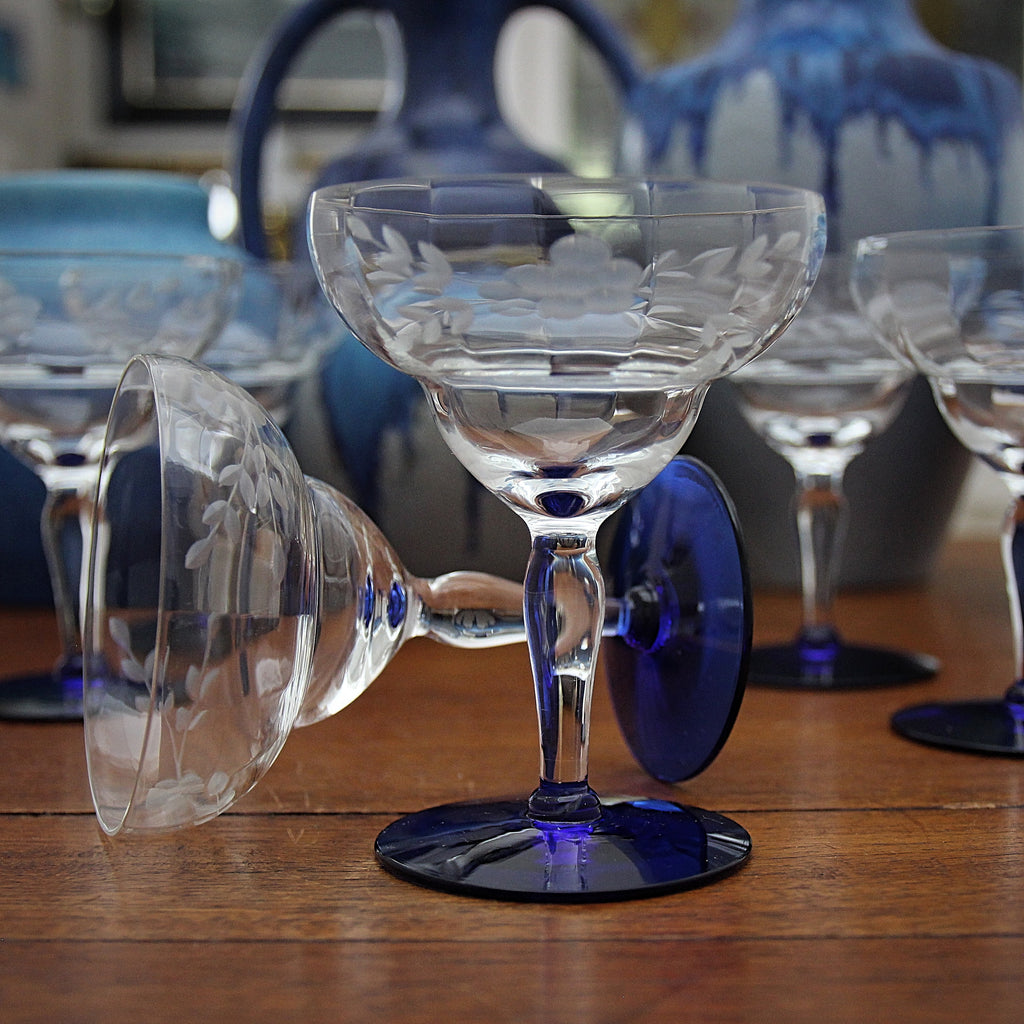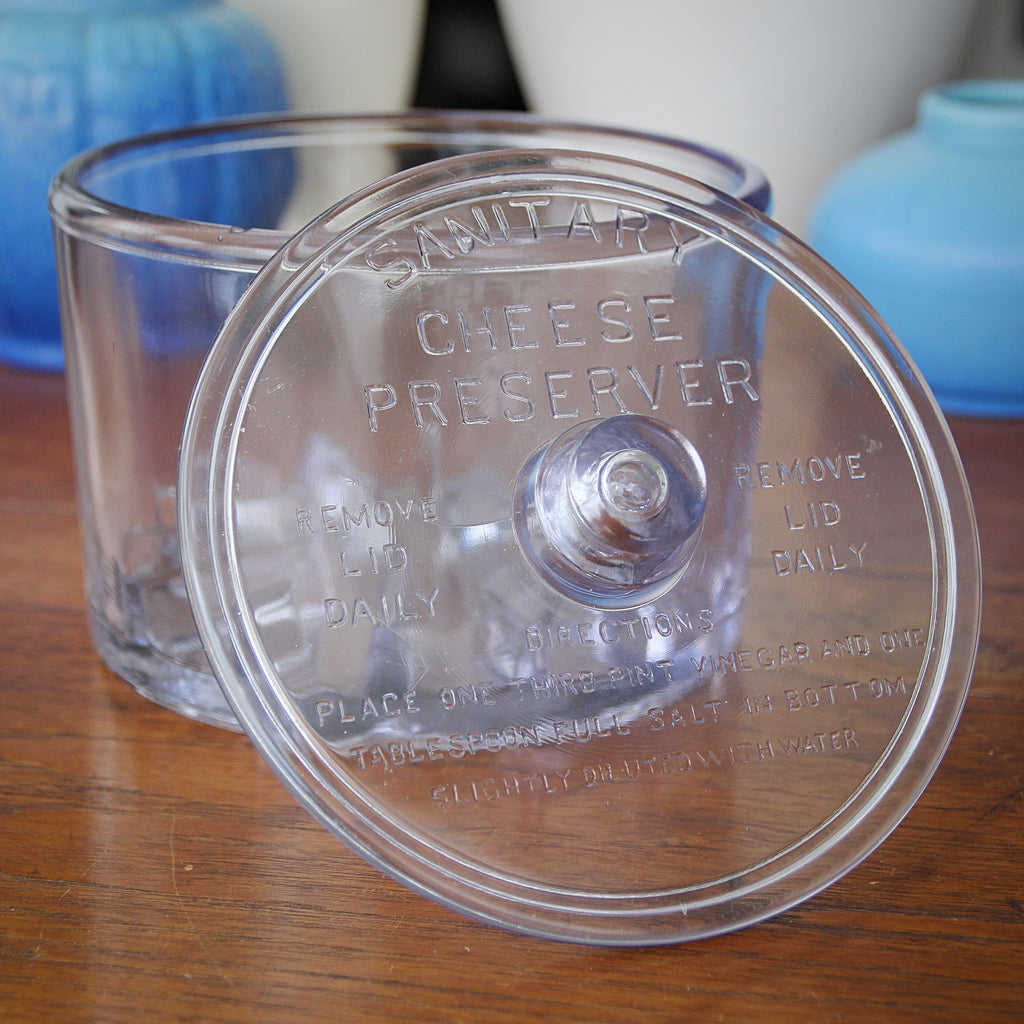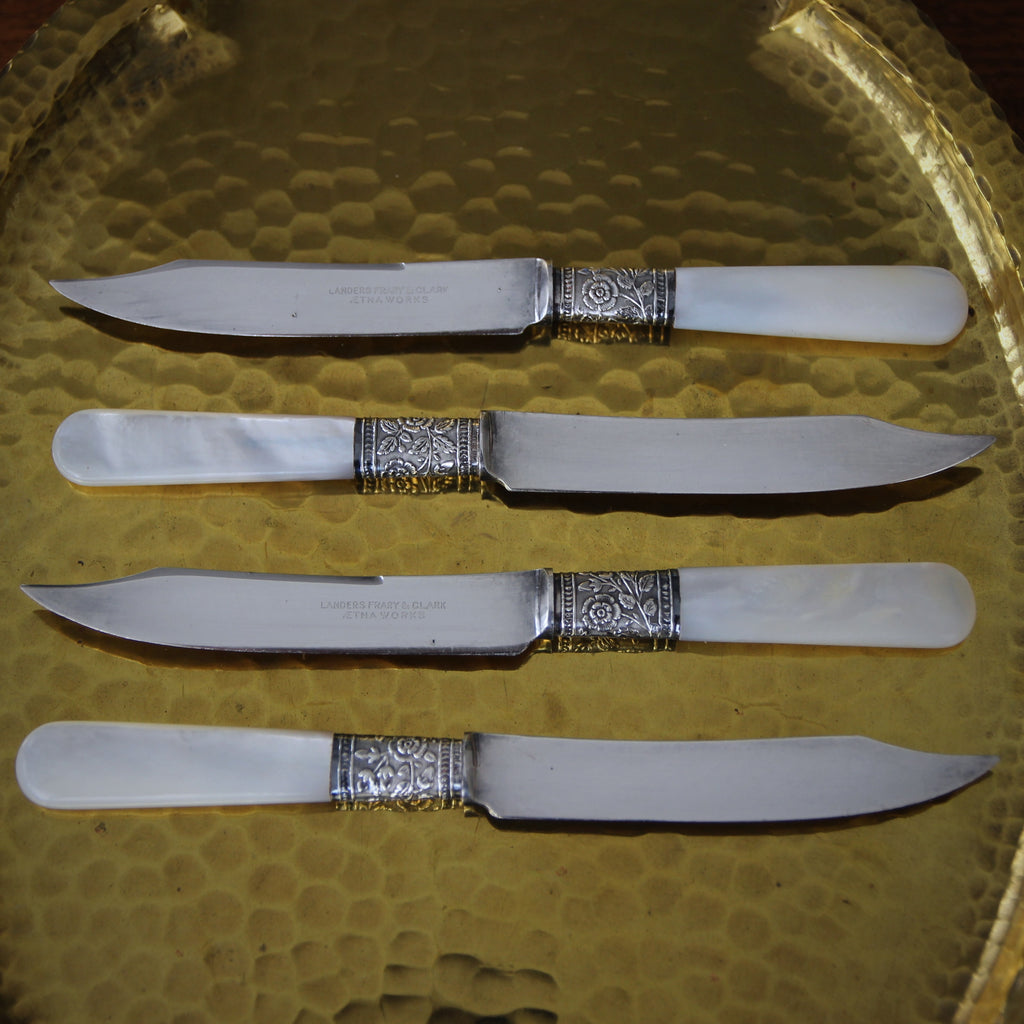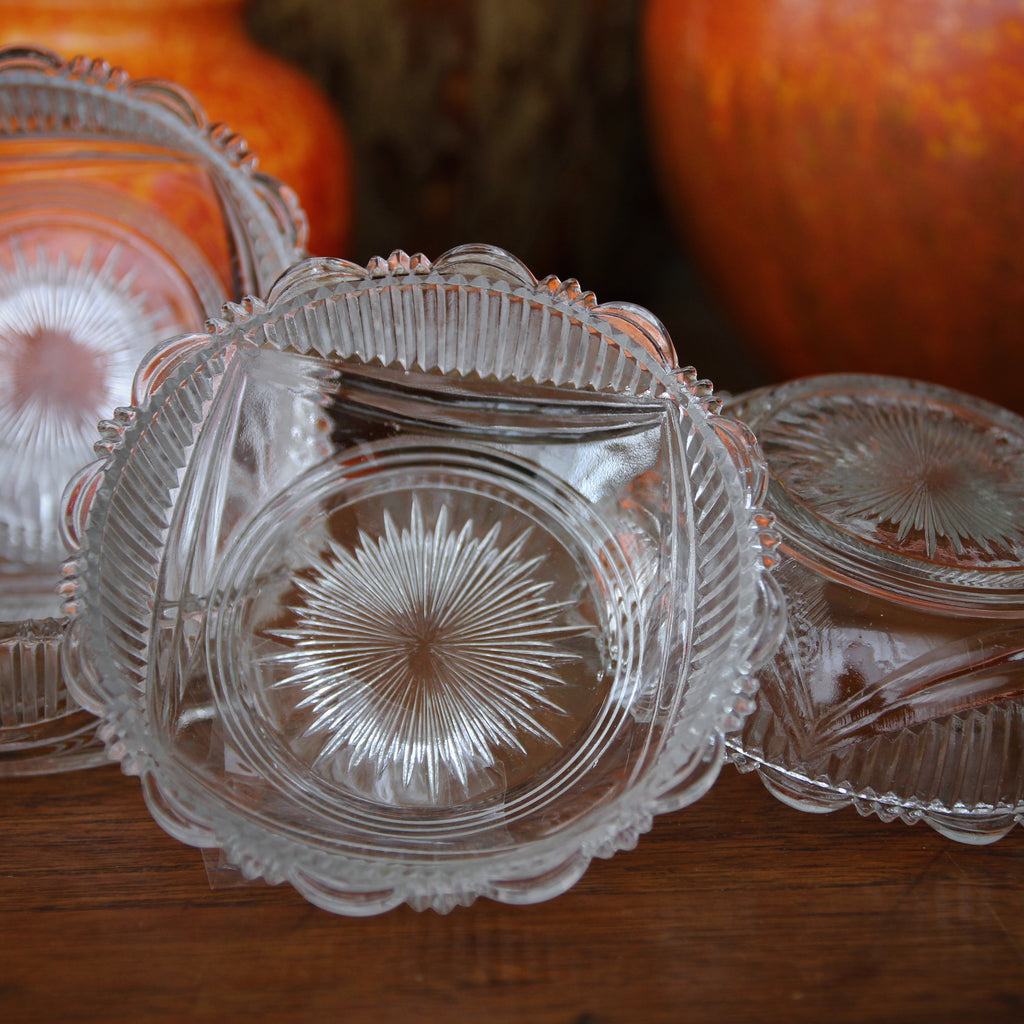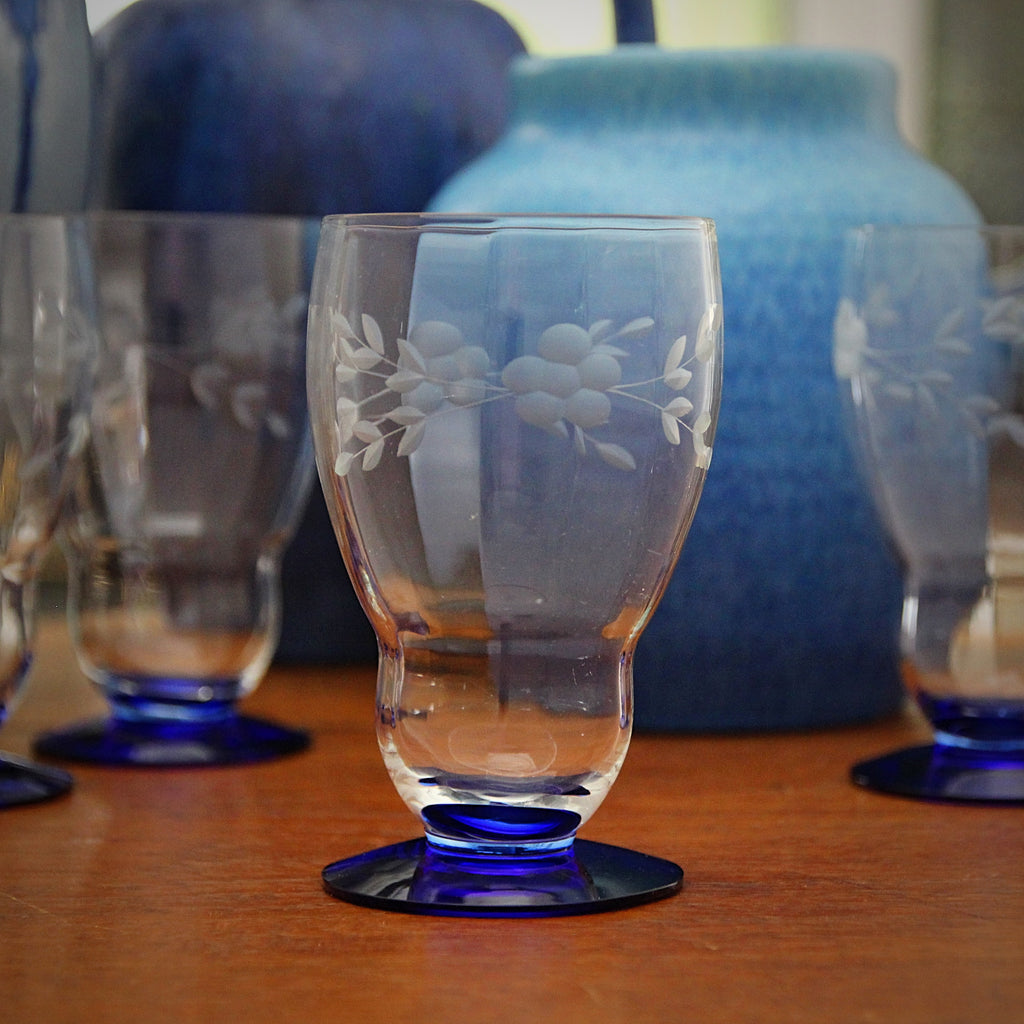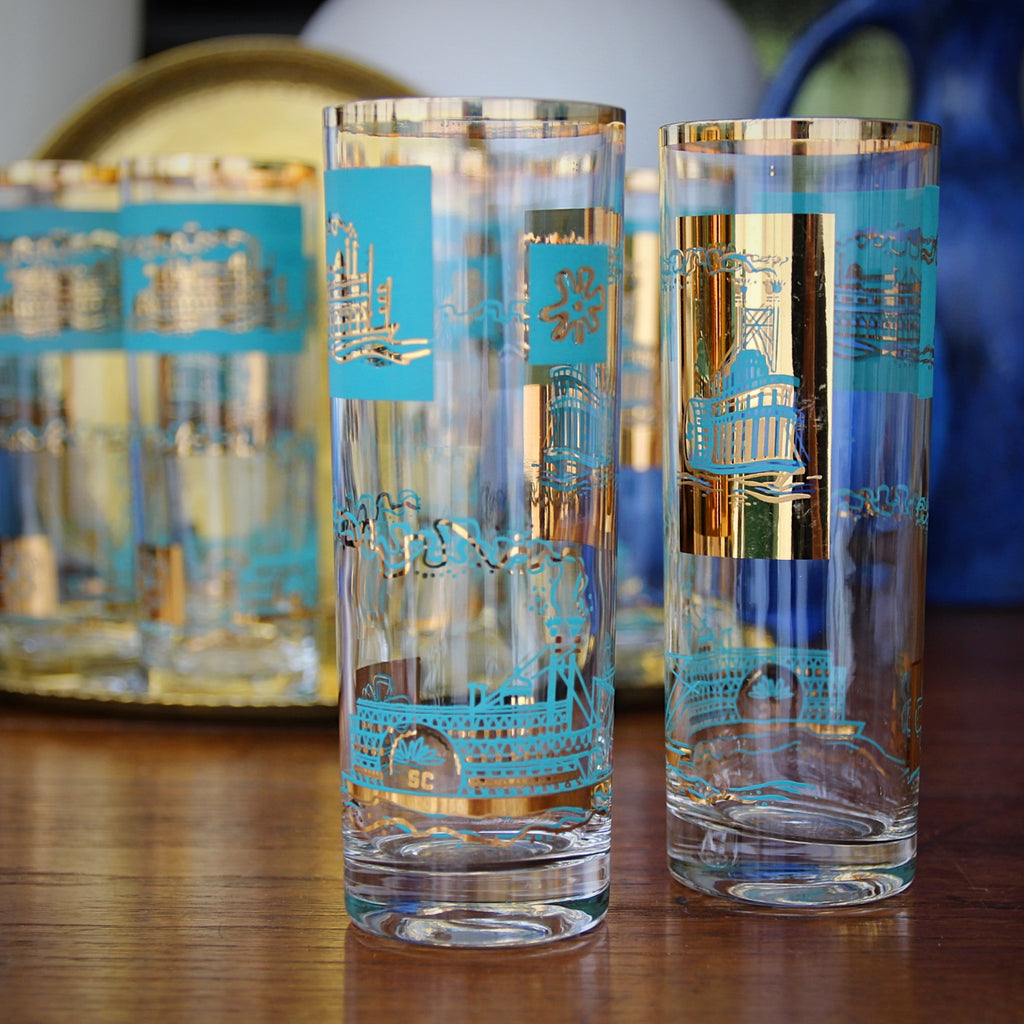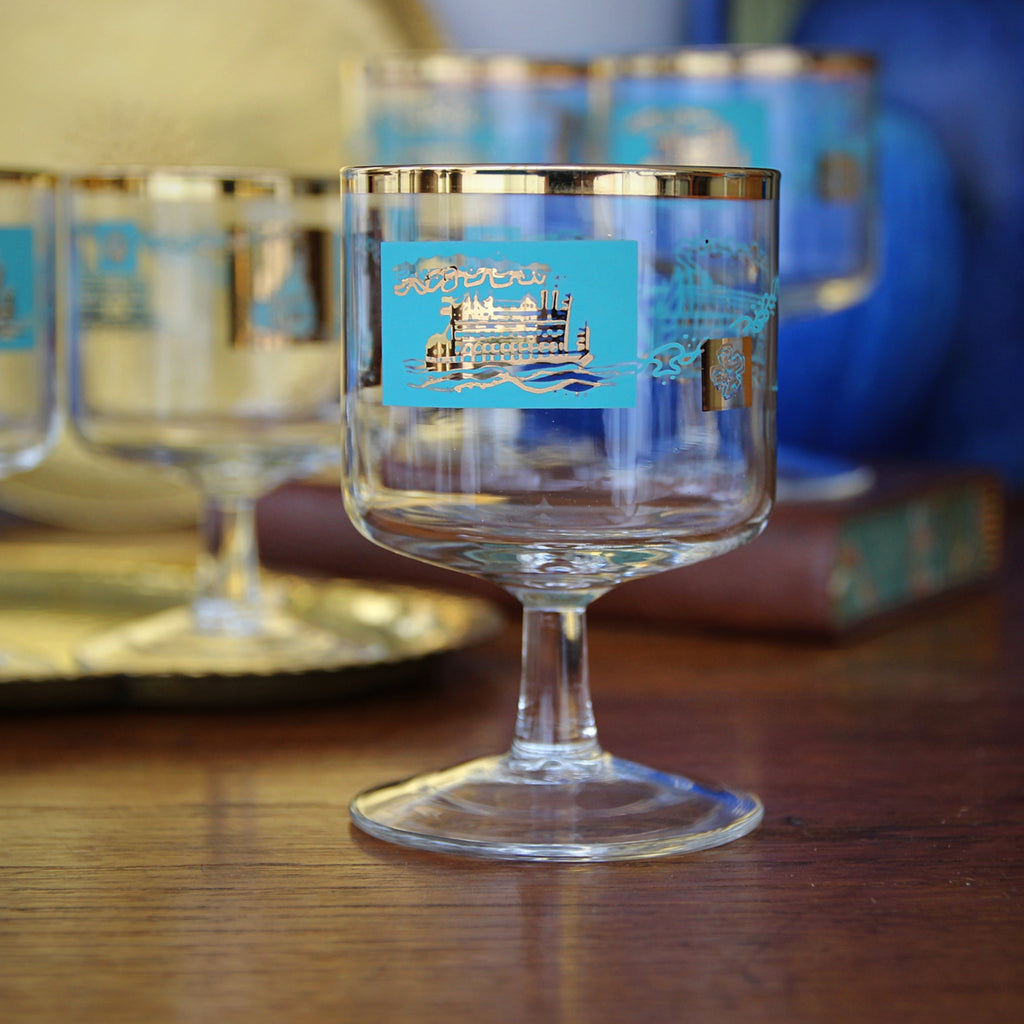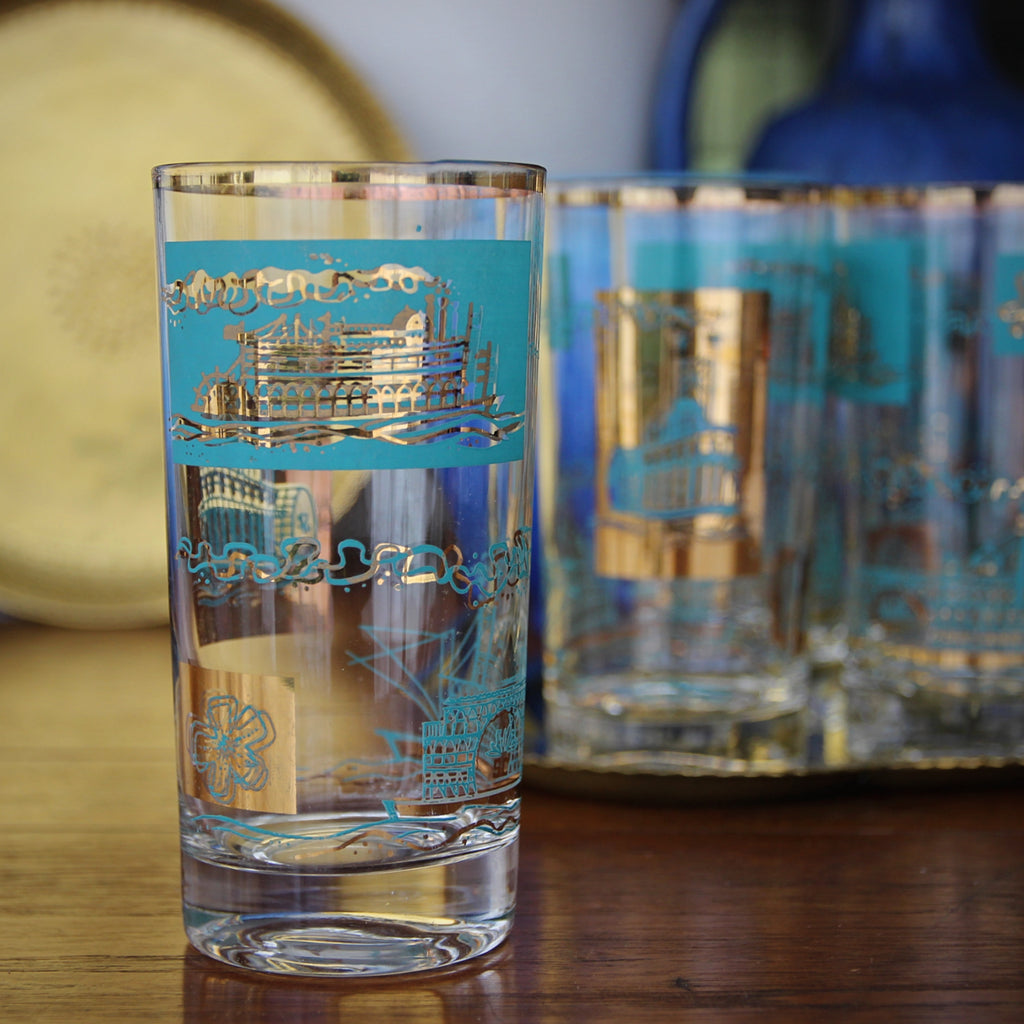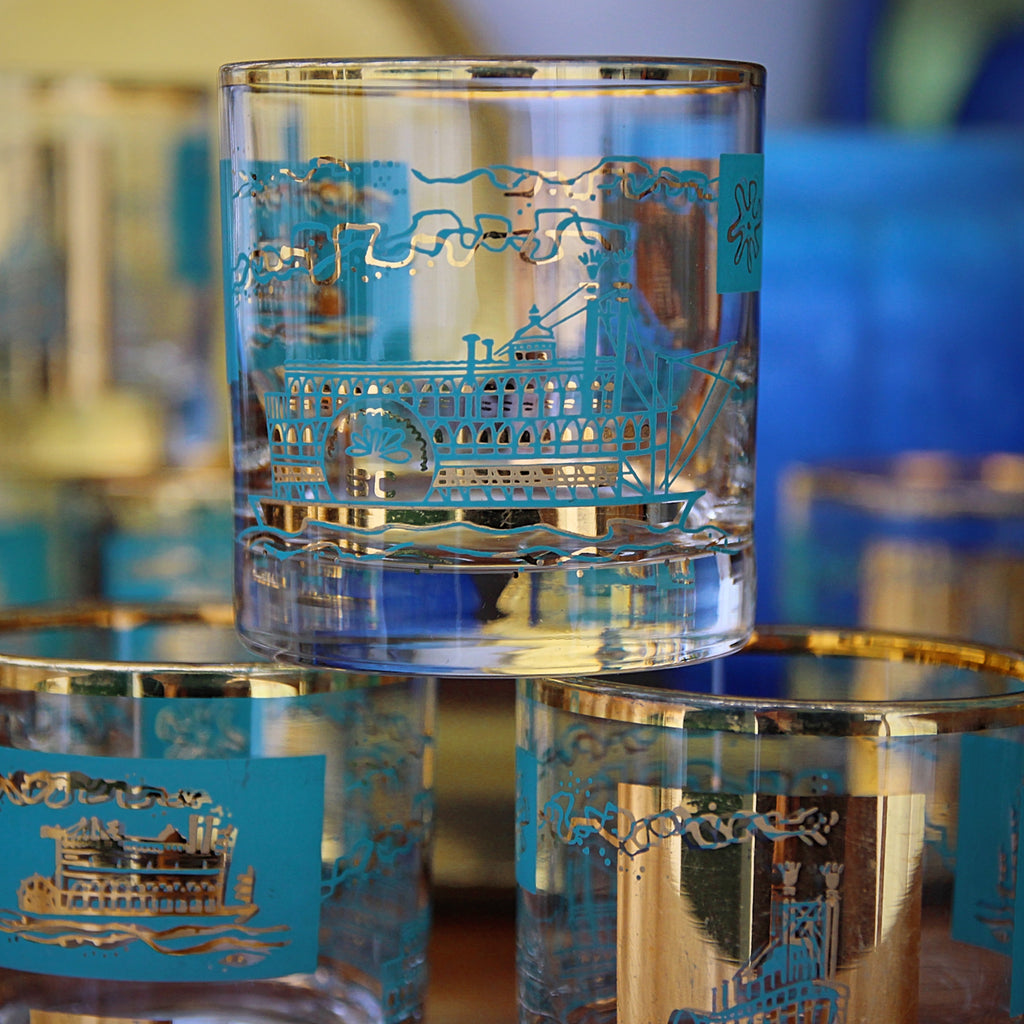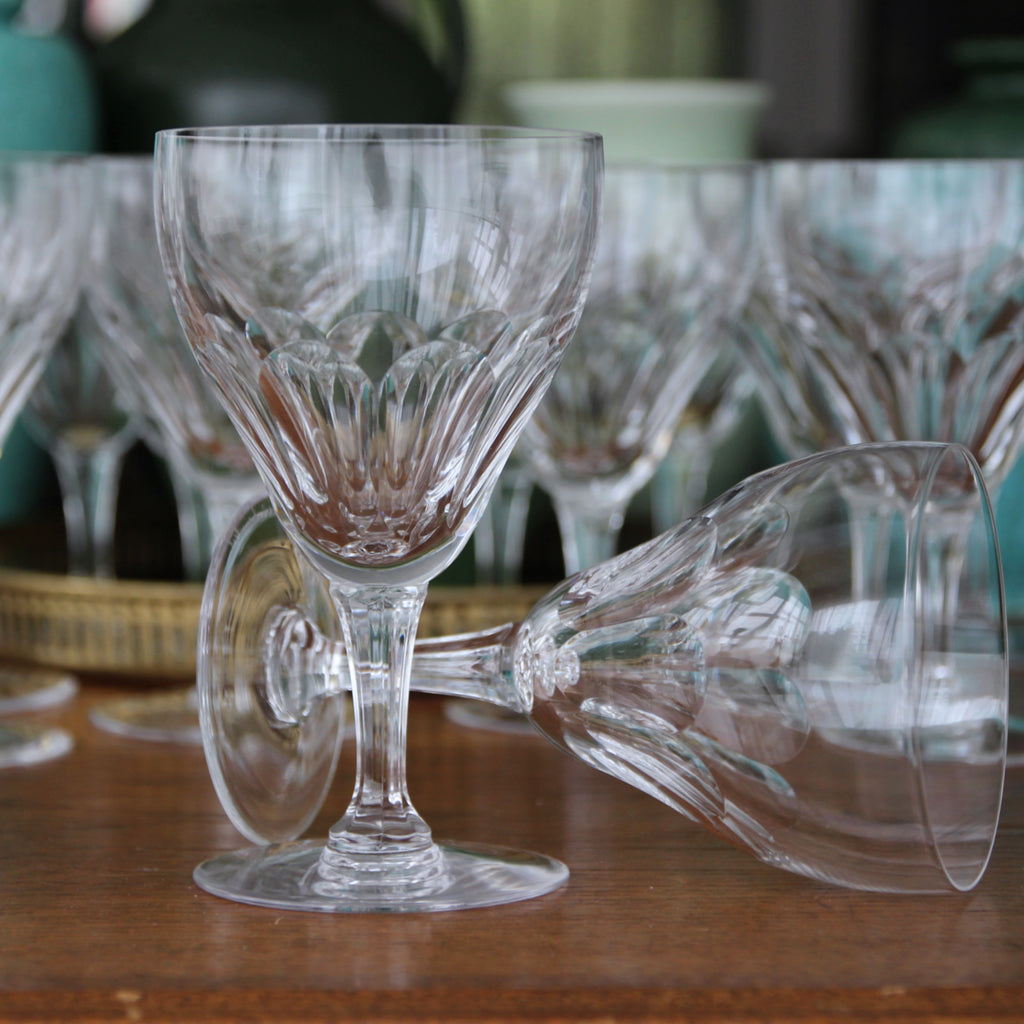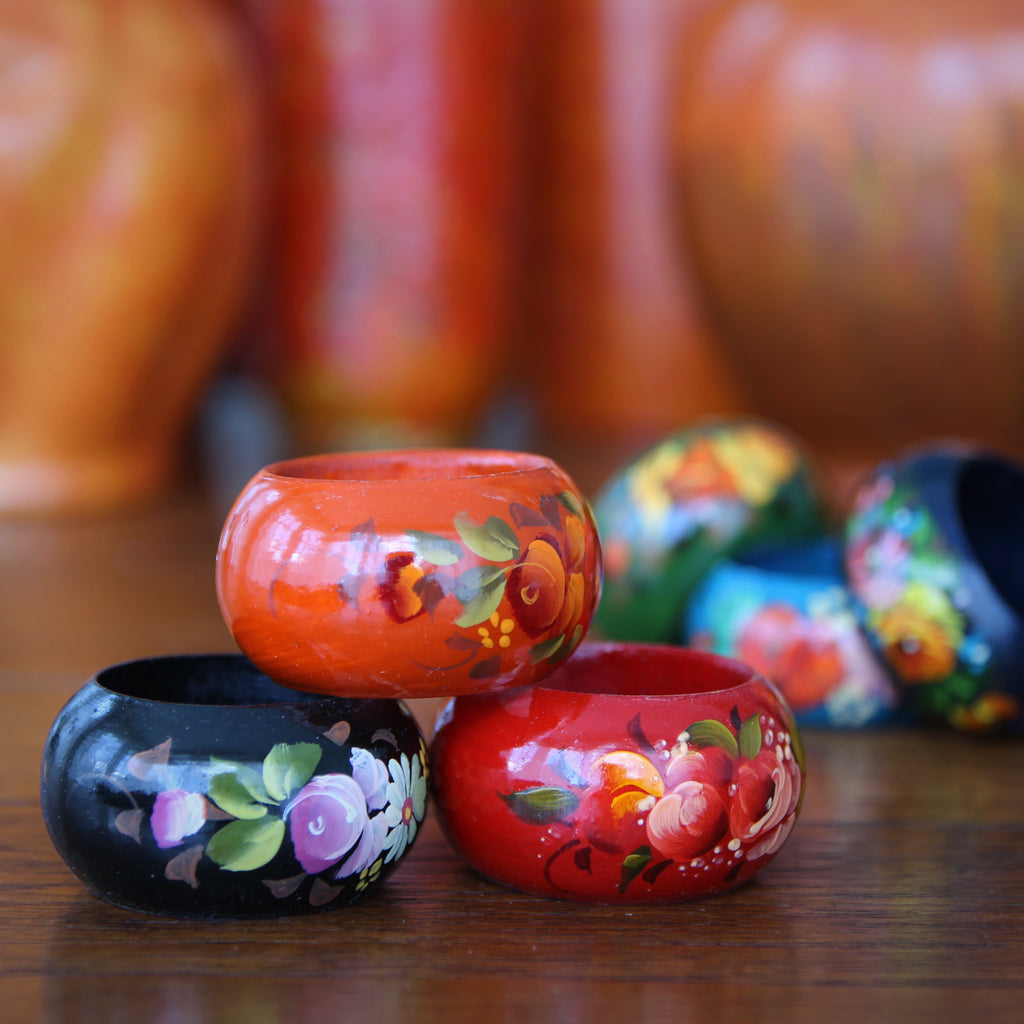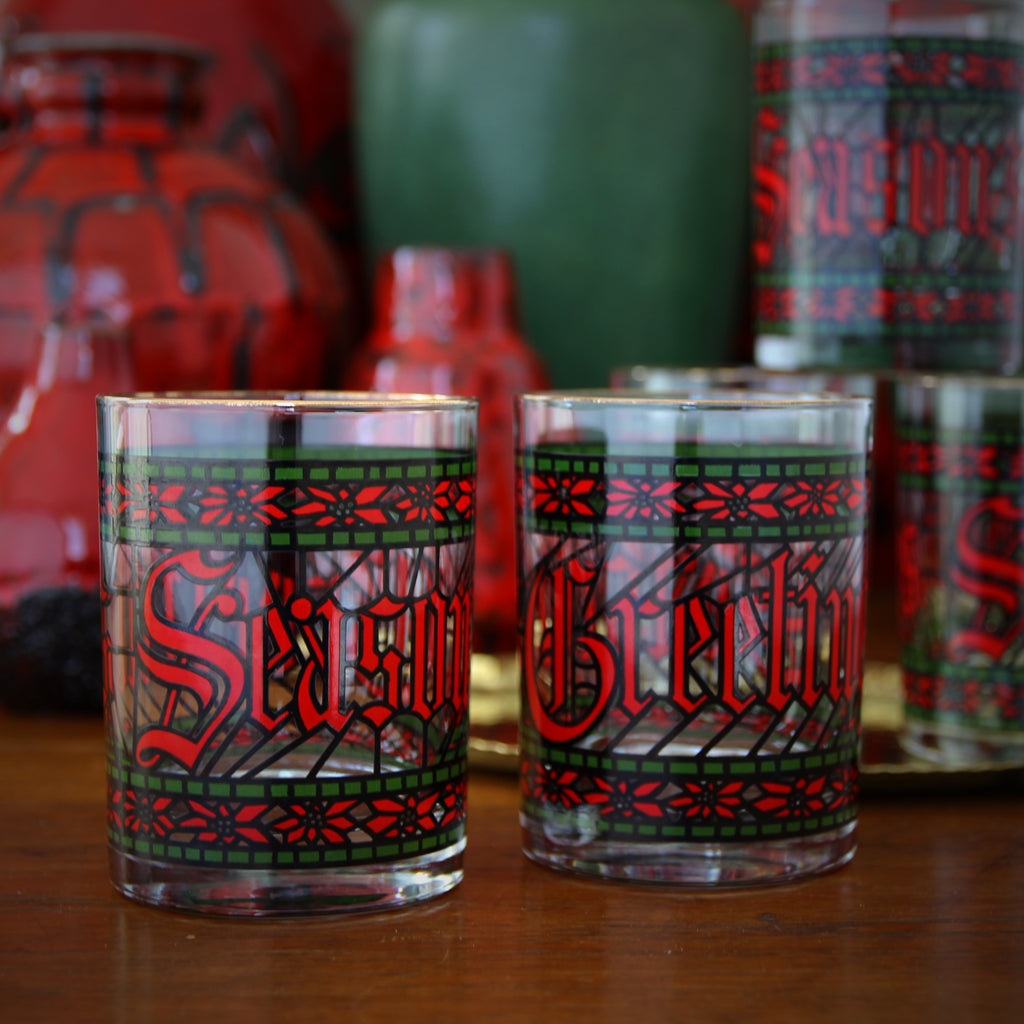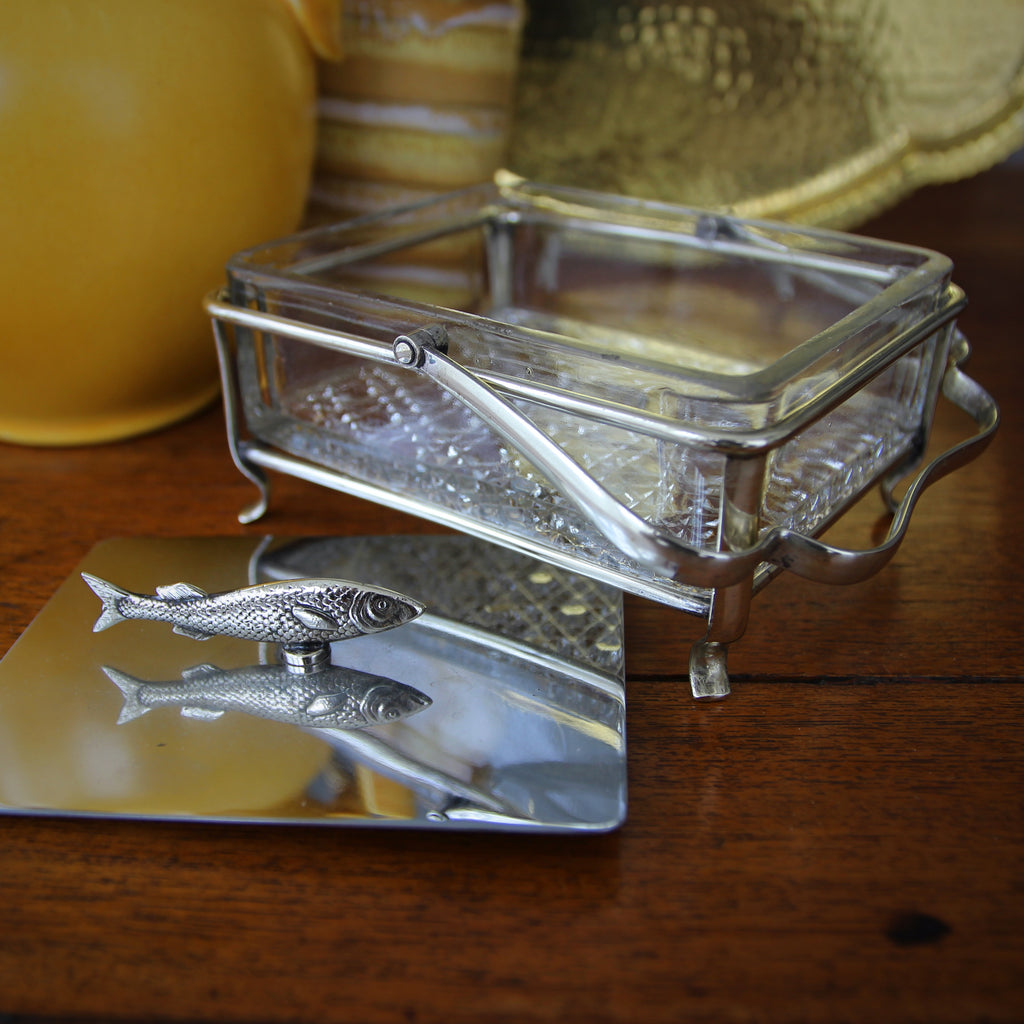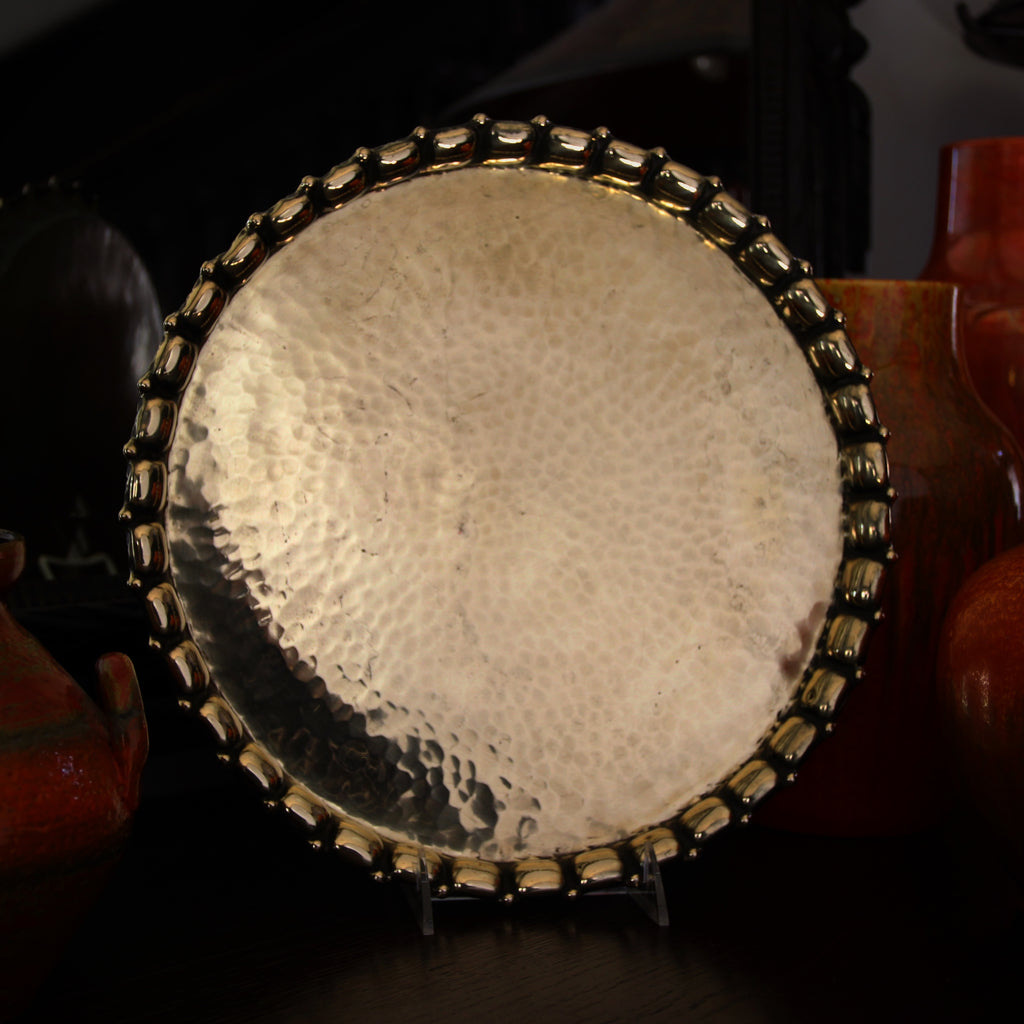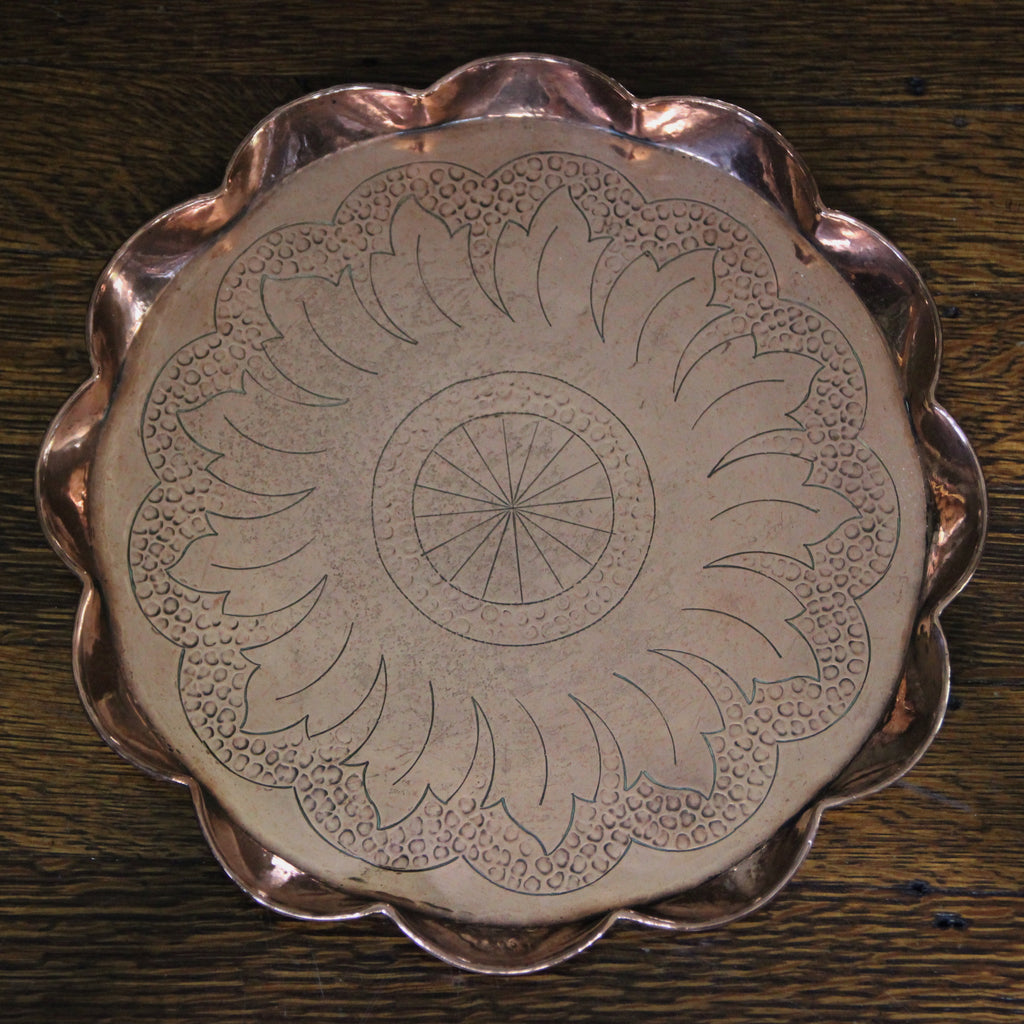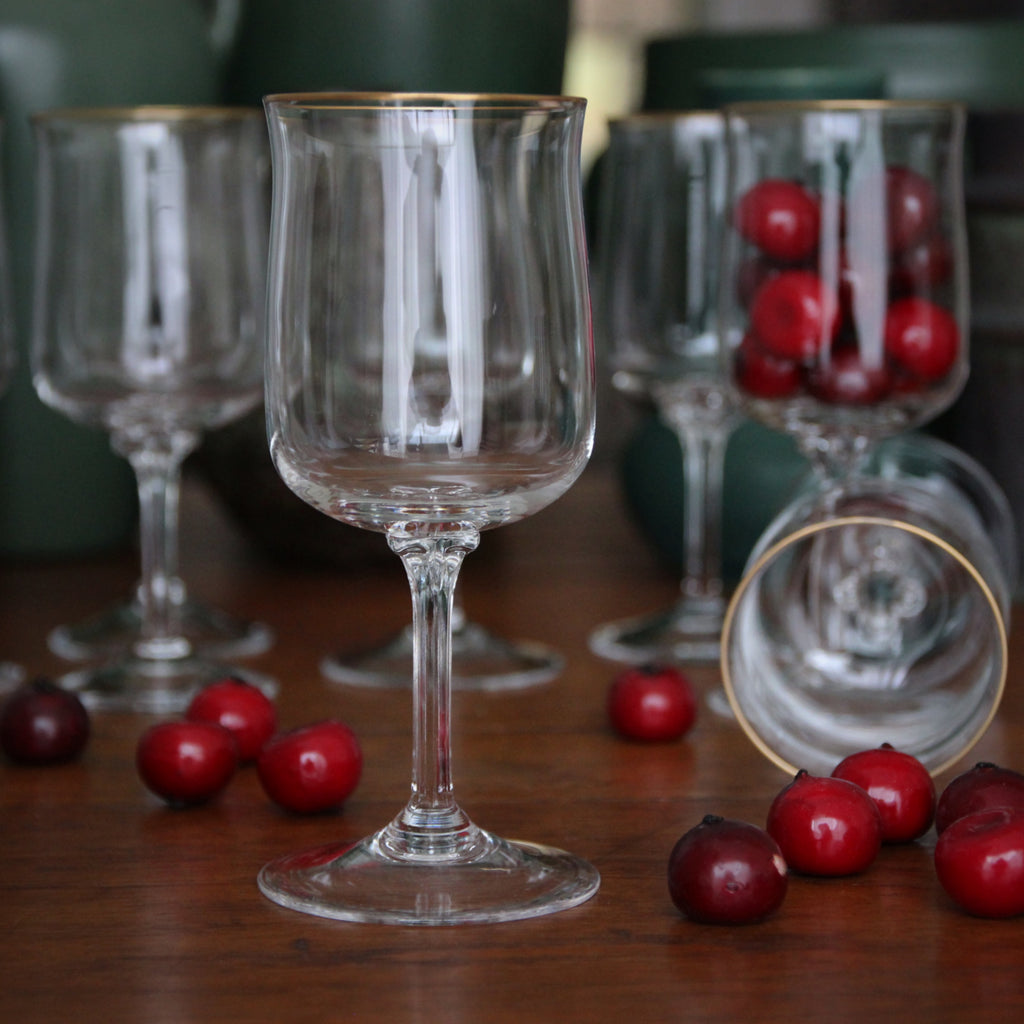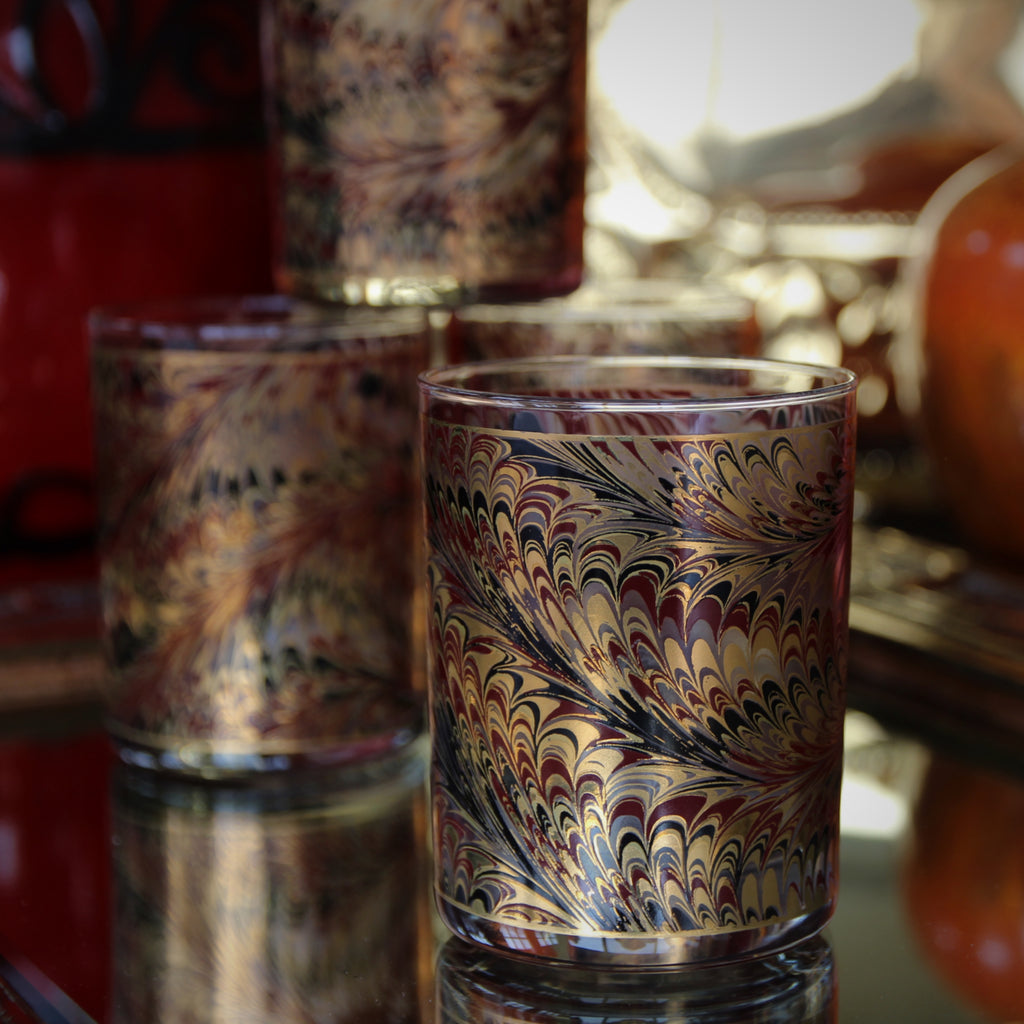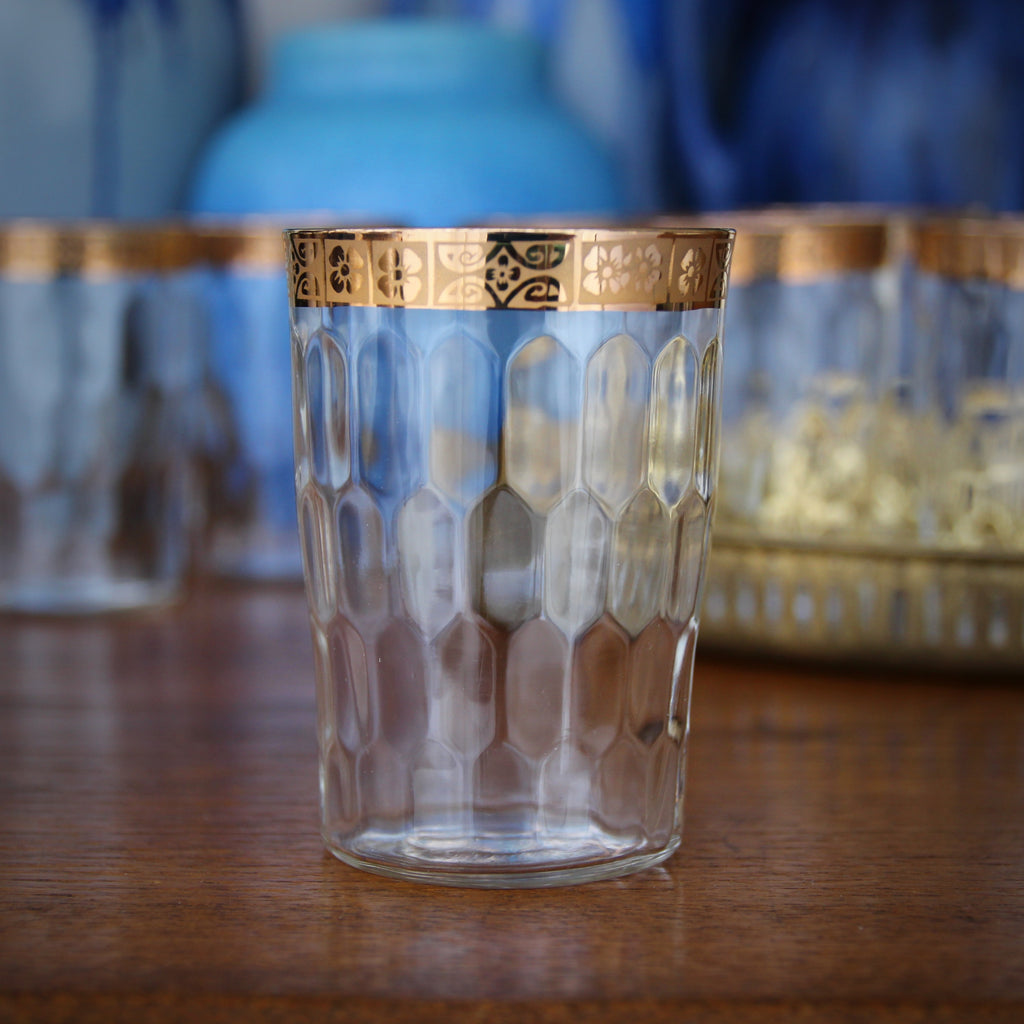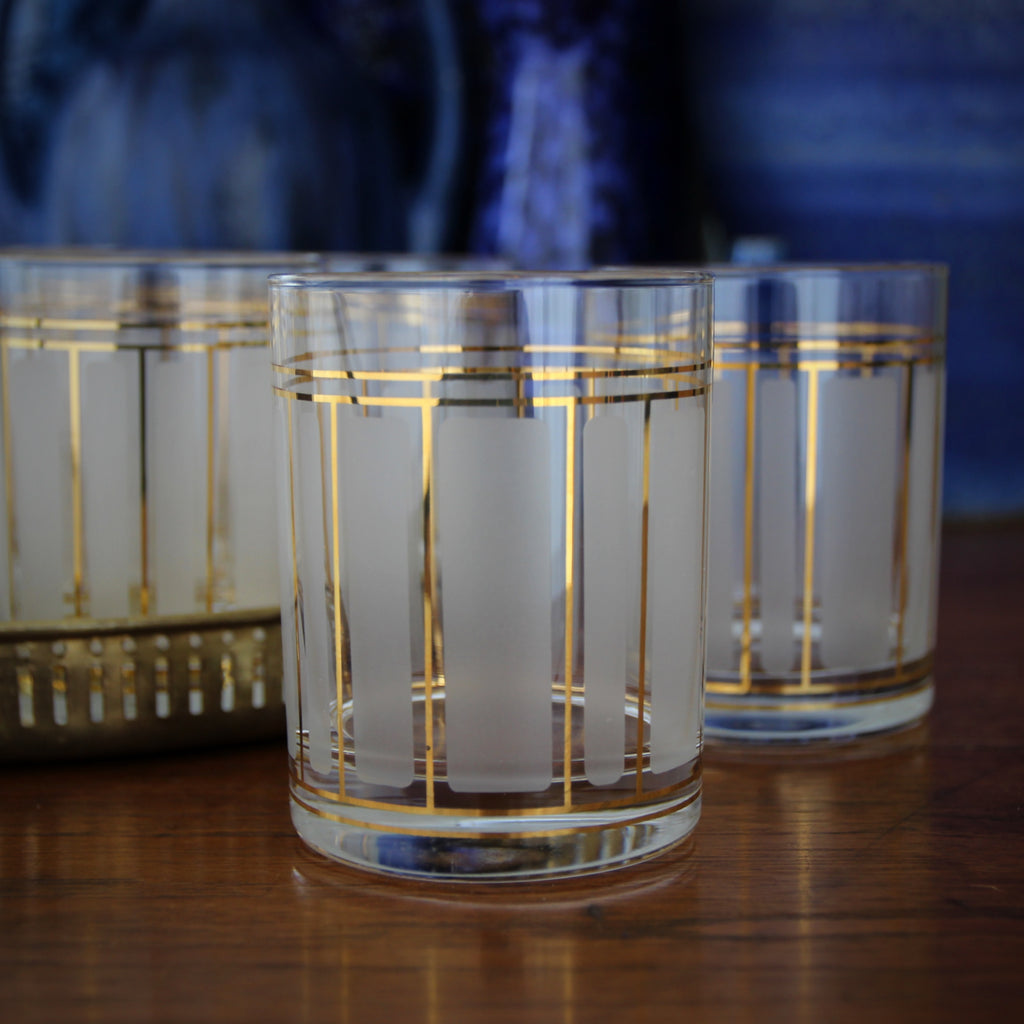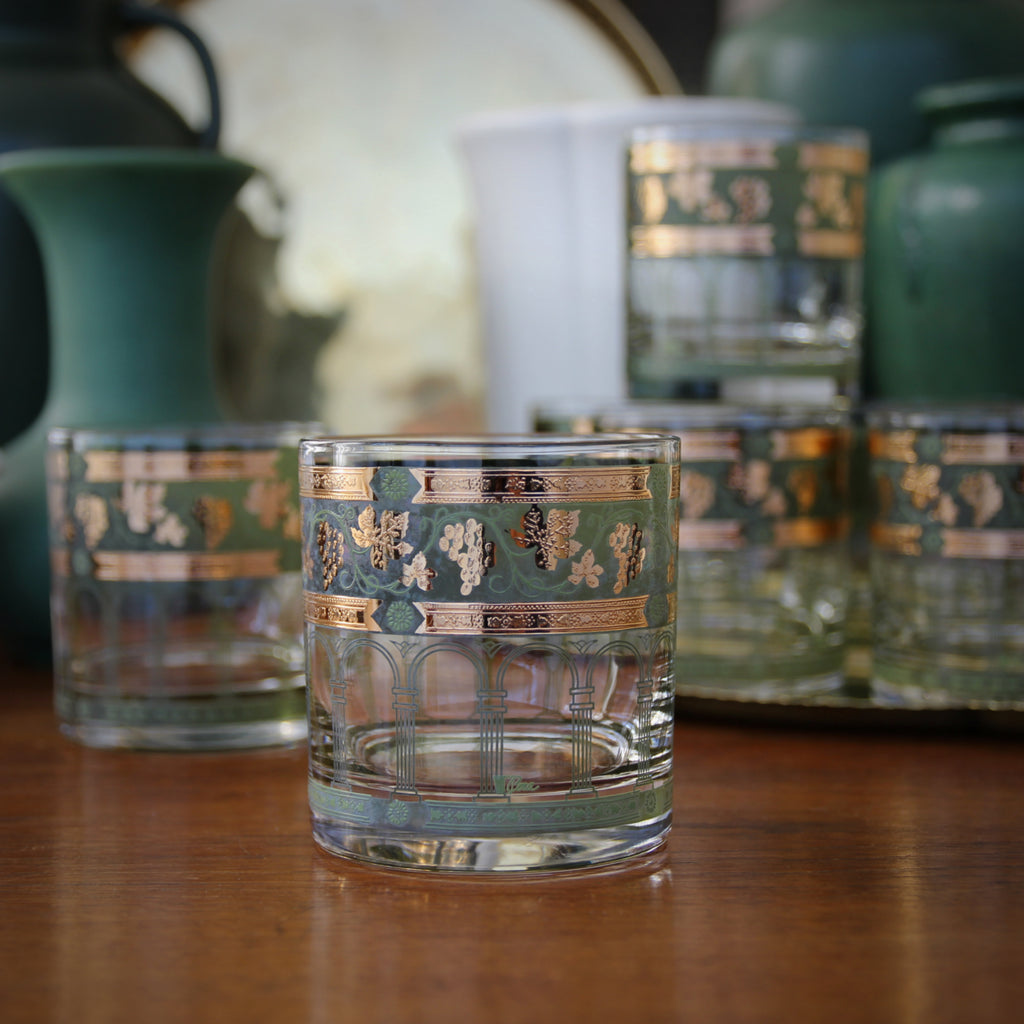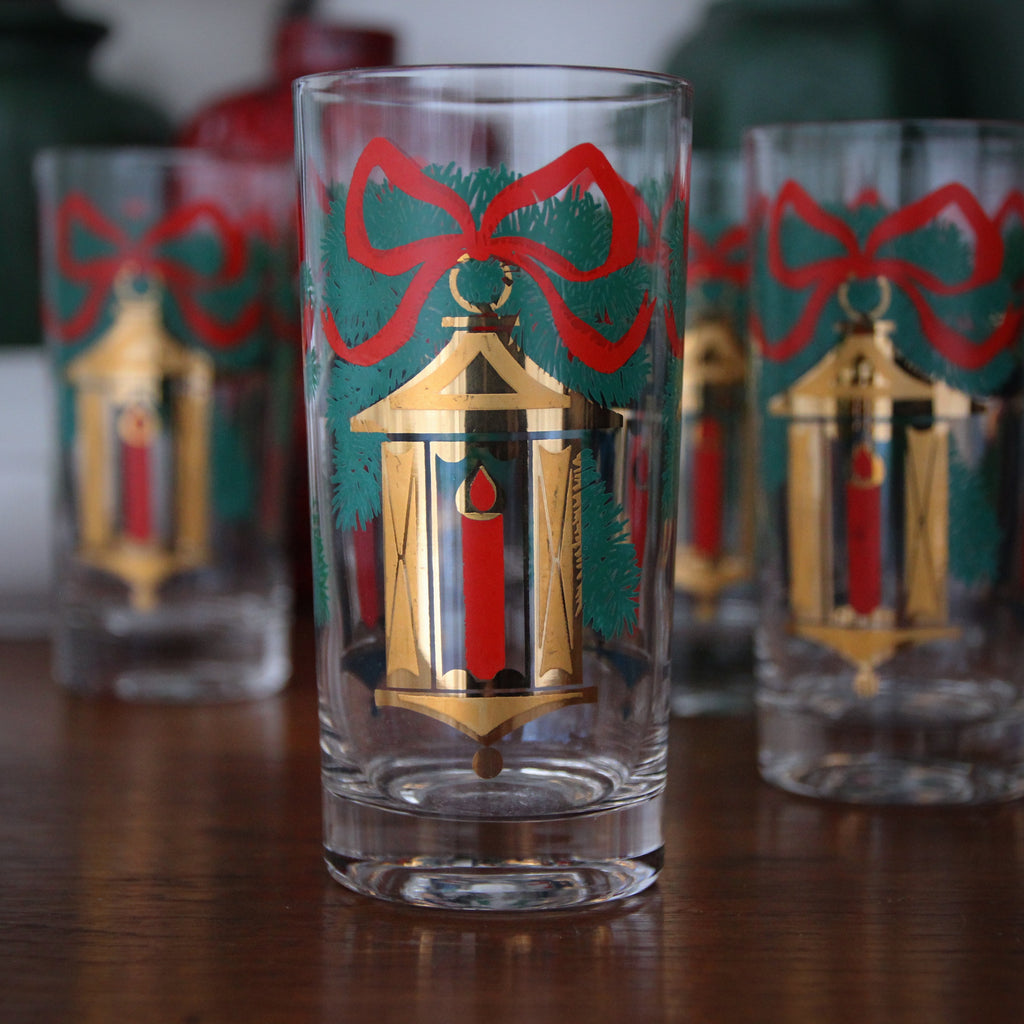JOURNAL — Glass & Serviceware RSS
Every year, just before New Year's Eve, we get a small rush of customers buying champagne and cocktail glasses for their last night gatherings. It seems they are resolved to up-their-game before the clock strikes twelve. Above, see a set of eight (plus one) handsome crystal champagne or cocktail stems. Made in the years just after World War Two, they have a corseted, "tulip form" bowl—which provides visual tension to the design and slows the release of the champagne's bubbles. The softly-curving lip makes the glass a pleasure (and a little easier) to drink from. And the faceted stem gives the glass a "crisp handfeel," making it easier to control the vessel. A stem, of course, prevents the transfer of...
Art vs. Utility
When is a tray not a tray? Perhaps when it's too beautiful to cover-up and use—like this Belgian Art Nouveau bronze tray. It was made by G. Huygens, a Belgian sculptor of Dutch ancestry. What this small tray does—superbly—is to provide a sculpted decorative accent upon a table top or low shelf. It would be useful for presenting business cards, offering small (wrapped) candies, or as a caddy for wallets and mobile phones (though I would avoid scratching it with coins or keys).
While the works of G. Huygens can be found at the occasional auction, there is a surprising lack of biography to be found about him.
Extra Help for the Holidays
Trays are amongst the simplest—yet most useful—of household accoutrements. Compared to carrying-by-hand, trays allow one to transport three (or four) times the amount of volume of that which must be carried. Trays can be fancy and decorative or they can be handsomely utilitarian (like the Edwardian English Oak Butler's Tray, shown above). I use trays when setting the table. In the kitchen, I pile-on all the plates, glasses, napkins, silverware, and serving pieces (pitchers and utensils). Using the tray allows me to make one trip to the dining room. I use trays when serving my guests (first drinks, then supper, then dessert). And the tray is useful for clearing-away the table at the end of the night. When I head...
Autumn in New York - Part Five
The Greeks (and then the Romans) made more than just handsome, masculine sculptures. They decorated their homes (and themselves) with beautifully-crafted works of art. Today, we'll share some of these items which we encountered in the Greco-Roman galleries of the Metropolitan Museum of Art. The Greek influence (called "Hellenization") was widespread. It spread in three distinct ways. First, the Greeks conquered many areas, physically moved-in, and asserted their culture through the subsequent colonization. Second, Greek artworks were sold, imported or traded to far-flung lands—even those which the Greeks did not colonize. These artworks had a strong influence on the aesthetics of the importing lands. And third, people like the Romans fueled "Greek Revivals" of Hellenistic art, culture, philosophy and social...
Tea Time!
Tea has been consumed by the Chinese—at least medicinally—since the Shang Dynasty (1600 - 1046 BC). In 1516, Portuguese traders arrived in China where they "discovered" the exhilarating brew. Then, in the 1550's, Italian traveler Giovanni Battista Ramusio published his two volume Navagationi et Viaggi ("Navigations and Travels")—fascinating accounts of the travels of the era's greatest explorers. It was here that Europe first learned about the marvelous, caffeinated brew. In 1610, Dutch Traders from the Dutch East India Company began shipping tea to Europe. It was introduced to France in 1635 and England and Germany in 1650. In those early days, tea was a wildly expensive luxury. It was purchased only by wealthy aristocrats and kept safe—under lock and key—in...
Party Animal
The Donkey long has been the mascot of the Democratic Party. It began during the U. S. presidential campaign on 1828. Democrat Andrew Jackson—called a "Jackass" by his opponents—decided to lean-in to the sobriquet. He embraced the Donkey as part of his brand: stubborn, steadfast, determined and willful. But it wasn't until the 1870's when the Donkey really took-off as the symbol of the P-O-D, The Party of Democracy. Artist Thomas Nast (1840-1902), a German-born immigrant to New York City, became the country's first great political cartoonist. His long career with Harper's Weekly (1859-1886) gave him a platform to skewer and satirize political performers. And he took a special joy in going after bullies. While Nast did not create the...
More Sapphire - III
We're looking at sapphires this week—or, at least, items which have a sapphire appearance. Shown here, a set of six Modernist stems blown in smoky-sapphire crystal. It's a sophisticated color, sure to make an impact on any dining table. And, atop each glass, we find a rim of platinum. This metallic band looks sharp and it helps to protect the delicate edge from chipping.
"It Must Be Jelly . . . "
Fruit preserves are made all over the world. They contain endless combinations of ingredients—sweet fruits, savory fruits, sweeteners, spices—and go by many different names. In America, we tend to think of "jam" as a sweet fruit preserve, which still contains chunky bits of fruits (sometimes a little fruit, sometimes a lot of fruit). Jelly, on the other hand, usually refers to a clear (strained) fruit concoction which has been gelled. Good jellies "quiver" when shaken, while maintaining their form and they can be cut cleanly with a knife (and still hold their shape). More than one song from the Thirties and Forties included the phrase, "It must be jelly 'cause jam don't shake like that!"
Sheffield Plate
Henry Wilkinson was born in 1788 in Norton Hammer, a village in Southern Yorkshire, some three miles south of Sheffield. Sheffield was already playing an outsized role in England's Industrial Revolution: specifically steel manufacturing, cutlery-making and the production of other metalwares.
At the time Wilkinson was born, silver-plating was only a few decades old. The process of bonding a thin layer of sliver to a copper ingot—and then rolling-it-out into a workable sheet—had been developed and improved in Sheffield. These sheets could then be stamped (in metal forms) to produce cutlery, trays, and all manner of silver-plated wares—commonly called "Sheffield Plate."
Picky, Picky, Picky
Scotland is a leading source of agate (from the family Chalcedony, a type of quartz). The stone is translucent, comes in many colors, and has distinctive banding including white and clear portions. Agate was formed within the crevices of ancient volcanic lava flows, though the loose "nodules" can be found along Scotland's eastern beaches, in plowed fields, or within cliffside crevices. Agate comes in many natural colors and also sometimes is dyed artificially. The Scots have been using agate decoratively and as a "talisman" since prehistoric times. They are thought to provide stability, balance, good luck and protection. Their use reached the peak of fashionable popularity in Victorian jewelry. But agates have always been prized as a cultural icon amongst the...
Countdown to Father's Day - 2
We're sharing some Handsome Gifts ideas for Father's Day. Perhaps you know a much-deserving dad?
For fathers who like to fish, this Korean bronze charger is likely to tick several boxes. The bas relief modeling is superb in its detail, precision, and energy. Grasses at the water's edge, bushes upon the shoreline, even ripples in the water are all portrayed with meticulous detail. And then there's the pike: arched in combat as he struggles to escape. This sculpted bronzework is beautifully rendered and crisply cast—truly the work of a skilled artist.
Welcome, June
We welcome June, and her flower, the rose.
Roses may be the most popular of flowers. There are over 300 different species of natural roses and there are thousands of man-made variants (cultivars) that have been developed over the centuries—selectively-bred to accentuate desired traits like color, size, fragrance, form or hardiness. 50-million-year-old rose fossils from the Eocene Period (which means, roughly, "The New Dawn") have been uncovered by archaeologists in Colorado. Roses are depicted in Minoan art (circa 1400 BC) and in Egyptian tomb paintings shortly thereafter. And ornamental roses are known to have been cultivated by the Chinese, Persians and Mediterraneans from about 500 BC.
Feeling Blue - II
Colored glass has always been popular—at least since the time that glass artists learned how to impart such hues into their molten material. In the Modernist era, after World War II, colored glassware (for drinking or serving) enjoyed a boost in popular demand. This set of six Modernist crystal stems are shaded with a smoky blue and topped with a platinum rim. A metal rim, like this, is not only aesthetically pleasing, but it also helps (a bit) to protect the delicate glass rim (where it is most likely to be chipped). Use glasses like this for water, wine, or a fancy cocktail.
Snowfall
The snow has been falling, fluffy and deep, in my neighborhood. Having grown-up in Hawaii, I always thought that "the Mainland snow" was supposed to go-away at the end of Christmas. Shouldn't January—a new start, clean and fresh—"snap-back to normal"? One trick I've learned is to shovel the sidewalks as soon as possible. Fluffy snow can be "scooped" quickly and easily. Once it has been tamped-down (by marching feet), it is much harder to shovel. Snow that melts, just a little, and re-freezes is a nightmare. And it gets worse when new snowfall piles upon that sheet of ice. But snow can be so pretty. (At least initially.) As these French Modernist crystal paperweights are pretty. A delicate snowflake is "embossed"...
Countdown to New Years - One!
New Year's Eve calls for Champagne. And Champagne calls for coupes. (No flutes, please!) This set of eight good-quality crystal champagne (or cocktail) stems will help ring-in the New Year in perfect taste. The softly-corseted "tulip-form" bowl creates a lightly-rolled lip (for easy sipping). The faceted stems ensure an easy grip. And the clean "ring" of the crystal will make the Champagne taste all the better.
Countdown to New Years - Two!
This set of fourteen crystal wine (or water) glasses may be amongst the finest sets of glassware I have ever carried. Val St. Lambert was founded in 1826 in Seraing, Belgium. The crystal was produced to the highest standards in a Medieval Cistercian abbey—with devoted customers in Belgium, Netherlands, New York and Tsarist Russia.
This pattern, called "Riviera Clear," was made between 1961 and 1982. It is a handsome combination of classic wine goblet design and Modernist simplicity.
Countdown to New Years - Three!
This set of four needle-etched, gold-rimmed glasses is a very elegant way to present wine! I have always preferred serving wine in tumblers (rather than stems). It seems less pretentious. More casual. And it reminds me that wine should not be viewed as an elevated luxury but, rather, as an earthy part of every good meal. Wine in tumblers brings-to-mind a small Italian bar where old men—old friends—gather 'round a card table, smoking and drinking an inexpensive (and delicious) local variety.
These four glasses, made in the Teens or Twenties, have a gently-flared lip, rimmed with an embossed, warm gold band. Needle etching adds visual interest to the glass. And wouldn't a rich, red wine look fantastic in these glasses?
Countdown to New Years - Four!
We're in the final countdown to New Year's Eve. Over the next few days, we'd like to share some glass and serviceware items—handsome and useful—which might add a little extra sparkle to your holiday gathering.
Shown above, a Modernist cocktail service by Dorothy Thorpe: a mixing pitcher, stirring rod, and pair of roly poly cocktail tumblers. Made in the Sixties, the rims of the glasses and pitcher are topped with a thick platinum band. It's a single, bold stroke of decoration which perfectly captures the powerful simplicity of the period.
Almost Heaven
West Virginia (and Ohio and Western Pennsylvania) was a center of American glass-making from the Nineteenth Century. Blenko Glass, founded in 1922, is still operating in Milton, West Virginia. William Blenko, an English immigrant to the United States, founded his first American glass company in 1893. His workshop created window panes by blowing cylinders of molten glass, cutting them open, and flattening them (in an oven). He made clear glass and colored glass (to be used in stained glass windows). His first company (and two more, after that) failed. His fourth company, Blenko (as we know it today), succeeded. During the Great Depression, when many building projects (the source of his revenue) were sidelined, Blenko broadened his product line to include decorative...
Houze Wares
It's ten days 'til Christmas! Is your Holiday bar cart ready-to-go? Southwestern Pennsylvania (as well as Ohio and West Virginia) was the locus of much American glassmaking in the Nineteenth and Twentieth Centuries. The region had all the elements necessary for the manufacture of glass: silica (the raw material), heat (provided by coal or gas), labor (much of it from Eastern European glass-producing countries), and transport for the finished goods (that is, the rivers which lace the area). Another factor helped promote glassmaking in this area: the Allegheny mountains which made East-West transport difficult (especially when porting delicate glass merchandise). Western Pennsylvania was able to produce glass for (and deliver it to) the growing Midwest (without having to lug it...
Winter is Here
After a prolonged and warm Autumn (we used to call it "Indian Summer"), winter finally came—and it descended fast. I've already been (light) shoveling for a week. And we've had consecutive days well-below freezing. If that's not enough winter for you, perhaps these handsome pressed-glass pine trees will bring it home. Two sculpted glass trees—seemingly laden with snow—stand as a pair (one short, one tall). They are beautiful for the Holidays though they would look nice on a windowsill year 'round—catching and diffusing the light that hits them. Click on the photo above to learn more about them. Though our Greenwich Village store is now permanently closed, LEO Design is still alive and well! Please visit our on-line store...
Sophisticated Frivolity
Santa stands atop this English Christmas tree, illustrated in 1938. It is enamel-printed upon this set of six 12-ounce highball tumblers from the Eighties. The gold rim, at top, provides a bit of Holiday cheer—while also helping to protect the rims against chipping. Despite the jolly decoration, these glasses will provide a rather sophisticated addition to the Christmas dining table or bar cart.
A Little Holiday Bling
Add a little bling to your eggnog! This set of six 12-ounce highball glasses is decorated with 22 karat gold lanterns—suspended by pine garland and fancy red ribbons. A red candle burns within; "I'll be home for Christmas." They were made in the Sixties but will still give a lift to your Holiday gathering. Cheers!
Sixties Simplicity
These glasses take me back to my boyhood in the Sixties. I remember that the Christmas decorations were naive, simple and (frequently) two-dimensional. The annual "Magical Santa Winterland" at the shopping center was a maze of jig-cut, painted plywood: elves, trees, beribboned gift boxes. We kids wound our way through the line, anticipating our turn for a few moments on Santa's lap. The littlest kids might be crying in their parents' arms. We older kids were brave, informed by years of experience.
At some point, perhaps it was in the Eighties, "luxurious dimension" took-over. Suddenly, all those painted plywood creche characters—staked into the ground, lighted with a clamp-on work light—began to look a little dated.
We Need a Little Christmas . . .
As Auntie Mame (and Jerry Herman) reminds us, "We Need a Little Christmas!" I can't think of a better time for a small measure of cheer than "right this very minute!" Shown here, a set of eight Modernist high ball tumblers—perfect for iced tea, lemonade, or a Tom Collins—frosted and graced with leaping horses in white and 22 karat gold.
That Day Has Come!
Will it ever end? Yes! Today is that day! (Which does not preclude one of the candidates from dragging-us-into a nasty, protracted Phase Two.) But today is the day we've been awaiting!
This set of four highball tumblers, made in the Fifties, shows a feisty Pennsylvania Donkey kicking-up his heals—"Rarin' to Go!" Was the glassmaker even thinking—75 years ago—that Pennsylvania would be a continuing lynchpin in 21st Century national politics? (Make that "world politics.") Click on the photo above to learn more about this most-novel set of (timely) glasses.
I need not remind you, dear LEO Design customers, that every vote is important. Please vote!
Fine Scotch Whiskey
In 1827, George Ballentine—a Scottish farmer's son—opened a small shop in Edinburgh to sell fine scotch whiskeys to urban connoisseurs. In 1865, George placed his eldest son, Archibald, in charge of the Edinburgh shop. Meanwhile, George opened another (larger) store, in Glasgow, with his second son, George, Jr. In Glasgow, Ballentine began "blending" whiskey—sometimes using as many as 50 different single malt whiskeys.
In Scotland, any scotch whiskey must be aged for at least three years (or the "youngest" component of a blend must be at least three years old). The longer a whiskey is aged, the more expensive it will be.
Fall Back
Last night we (should have) turned-back our clocks.
Despite the popular contempt for changing-the-clocks, I kind of like the adjustment. Growing-up in Hawaii, we didn't have seasonal time changes—such was the benefit of living at a southern latitude. But, "on the mainland," I find that the earlier evenings are befitting of the Fall—and my innate desire to hibernate. I certainly don't mind the extra hour of sleep, on the night we "Fall Back." And, for those who complain that it now gets dark "so darned early," I remind them that this—Autumnal—time zone is the real, unadulterated, Standard clock setting. This is the time it is supposed to get dark!
Welcome, November!
Today we welcome November—and her birthstone, the Citrine.
The Citrine is a pale yellow variety of quartz. Its sunny color is thanks to the iron content within the chemical structure of the gemstone. And Citrine's sunniness was not lost on Greeks—who first used the stone around 300 BC—who believed that the gemstone could help alleviate depression. At the time, Citrine was very rare, thus expensive, opulent and luxurious. As larger deposits were later discovered and mined (notably in Brazil), the gemstone became more common and fell within reach of more and more admirers.
Tôle
When Europeans first started trading with the East—China, Japan, India, Southeast Asia—a whole new world of design and style was revealed to Westerners. Asian artisans created masterful works—ceramics, lacquerware, textile weaving, printmaking—which enchanted the Europeans. These items, when imported to the West, were very expensive. Asian decorative arts became a status symbol of the rich and worldly. Only the wealthiest Europeans and Americans could afford to collect the real thing. But the desire for "Oriental" design permeated more than just the upper reaches of Western society. Consumers in the growing Middle Class (especially in the Nineteenth Century) wanted "a taste of the exotic East" in their homes, too. This broad demand led Western designers and craftsmen to try to emulate...
Pike
Korea has a long history of artistic handcrafted bronze ware—both for decorative and for practical (food service) uses. Shown above, a decorative bronze charger made in South Korea in the Fifties. It was probably brought-back to the States by an American serviceman who had been stationed in Korea.
The wide-rimmed charger is decorated with a highly-detailed bas relief wildlife scene. A pike leaps vigorously from the waters. Lilly pads, river grasses and a riverbank landscape can be seen behind him. It is all captured in tremendous detail. And, yet, the dynamic fish is the clear focus of the composition.
Baccarat
Amongst the finest—and most prestigious—of glassmakers in the world stands Baccarat. The company was founded in 1764 in Baccarat, France (about 250 miles east of Paris). The Bishop of Metz sought a new business for the village—hopefully one which could use the large supply of firewood produced in the diocese. He appealed to King Louis XV who authorized the glassworks. The company's initial production was fairly pedestrian: window panes and tableware. But, in 1817, the company developed an improved crystal formula (using nickel oxide) and from this point Baccarat Crystal narrowed its focus to the finest, high-end merchandise. Maharajahs, Tsars, Napoleon III and The Japanese Imperial Court commissioned pieces. Other customers included Coco Chanel, Prince Rainier & Princess Grace of Monaco, Josephine...
Modern Japanese Style
In keeping with our Modernist barware theme (see yesterday's journal entry), here is another intriguing piece—from post-war Modernist Japan. A hand-cut glass shaker with chromed lid is joined by six barware implements—all smartly-arranged upon a wood and chrome caddy.
The utensils include a graduated "scoop-form" jigger, an olive pick, a mixing paddle, ice tongs, strainer and bottle/can opener. All the pieces have wooden handles or accents.
The entire set hangs (or sits) upon this handsome wood and chrome caddy—ready for smart service at a moment's notice.
War and Change
Sadly, wars have a way of changing everything. Families, economies, and socio-cultural practices all can be upended by the winds of war. These conflicts often provide demarcation between the era that came before and the era that follows. Even art and design, frivolous as they may seem, are subject to this cycle of revision, renewal and reinvention.
With the onset of World War One, the Victorian and Art Nouveau periods ground to an end. After The Great War, people were ready for something new, fresh and modern. Enter Art Deco—with its aerodynamic, forward-looking, and mechanized aesthetic.
Keep Going!
Tonight is the final night of the 2024 Democratic National Convention in Chicago. We are marking the event by showing some of our favorite donkeys, now in-stock at LEO Design.
Shown here, a set of four tumblers from the Fifties. A feisty Pennsylvania donkey, bucking and kicking, is "Rarin' to Go!" Every year, it seems, Pennsylvania Dems are called upon to (try to) push Pennsylvania over the line. Sometimes we get the job done, sometimes we don't. Could glasses like these help your favorite Pennsylvania Dem "buck-up" and rally?
More Glasses
Yesterday we shared some newly-acquired glasses. Here is a sister set—every bit as beautiful, though in a different way. In truth, I prefer this smaller, flared shape (perfect for wine). This little sister, however, only has six glasses (compared to her sibling with ten + one). But the hand-cutting is superb and the finishing terrific. And the all-important "handfeel" is really nice.
Glasses
I cannot keep myself from buying nice drinking glasses whenever I come across a handsome set. But there are several varying (and competing) factors which must be weighed and compared during my purchase decision. The most important criteria: the shape of the glass (tumblers, please), the quality of the glass (nicely finished), and the "handfeel" (which is hard to define in words). Of secondary importance is the cutting or applied decoration, if any (not too frilly, please; Greek key fretwork is ideal; no applied decoration is fine). Another important factor: how many glasses comprise the set? Two or three glasses? Never. Four glasses? Everything else needs to be perfect. Six glasses? Acceptable. Eight glasses? Now we're talking! Ten...
Tiny Bubbles . . .
Hawaiian musical legend, Don Ho, was born on this day in 1930. He is best known for his signature song, Tiny Bubbles, written by Leon Pober in 1966. The song was originally written for Lawrence Welk who turned it down. Ho recorded it and it spent a bit of time on the 1967 pop charts: #54 on the Billboard Pop roster and #14 on the Easy Listening charts. After it became a hit, other artists covered it—and even Lawrence Welk performed it on his television show several times. Don Ho was born in Honolulu (as I was), though his family moved to Kaneohe—on the Windward side of the island of Oahu (as my family did). After a period of service...
August's Birth Flower
Yesterday we presented August's birthstone, the Peridot. Today, let's talk about August's birth flower, the Poppy.
Poppies are thought to have originated in the Eastern Mediterranean and have been cultivated by Western and Central Europeans from about 6,000 BC. Early on, people recognized the analgesic properties of the plant. Ancient Egyptian doctors had their patients chew a mouthful of poppy seeds to relieve pain. Even today, poppies are cultivated as a source of opium, morphine and codeine—powerful narcotics. Recent and reckless use of Oxycodone, which is synthesized from poppies, has caused grave problems for so many. And the illicit drug trade has profited from the poppy—through the sale of heroin, another derivation of the flower's seeds.
Crisp and Clean
We're one-third of the way through Summer—two more months to go. Is it too soon to start planning for Fall? Actually, the Platinum Leaves tumblers, shown above, are crisp and clean—perfect for Summer (or Winter, too). Imagine an icy G & T bubbling within these streamlined glasses. Made in the Fifties, this set of eight footed tumblers are decorated with frosted sides and platinum leaves. The top rim of each glass is decorated with platinum—an elegant touch which also helps protect the glass edge. Each glass holds 12 ounces (if filled to the brim).
The Dog Days of Summer - III
I've always loved the Aesthetic Movement. The crisp, handsome graphics—sometimes with a touch of Asian influence—is the elegant predecessor of both the Art Nouveau and the Art Deco movements. Shown here, a Wedgwood English Aesthetic Movement ceramic plate. The plate "blank" was decorated with a sepia-toned "transfer" pattern—a common manner of applying detailed decoration to ceramics in the Nineteenth Century. It allowed the manufacturer to print the patterns (on paper or film) rather than require each plate to be hand-painted. I have not seen other plates like this one, but I am guessing that the original set of plates may have sported a variety of different dog- (or hunting-) inspired scenes.
Welcome, June
June is here—with her flower, the Rose.
Roses have grown in the wild for tens of millions of years. 50-million-year-old rose fossils from the Eocene Period (which means, roughly, "The New Dawn") have been uncovered by archaeologists in Colorado. Roses are depicted in Minoan art (circa 1400 BC) and in Egyptian tomb paintings shortly thereafter. And ornamental roses are known to have been cultivated by the Chinese, Persians and Mediterraneans from about 500 BC. There are over 300 different species of natural roses and tens-of-thousands of man-made "cultivars" (that is, special varieties of roses purposely bred to accentuate selected traits like color, size, fragrance, form or hardiness).
First Class
In the 1990's the City of Pittsburgh built a shiny-new airport for its homegrown airline, US Airways. The city spent $1 billion dollars, satisfying US Airways's wishlist of cutting-edge requests. Completed in 1992, the New York Times called the new Pittsburgh Airport "The Airport of the Future." US Airways was founded, as "All-American Aviation" in Pittsburgh, in 1937 as a mail delivery service. Before long, the airline began carrying regional passengers and, in 1953, it renamed itself Allegheny Airlines. The airline changed its name again, to USAir, in 1979. After acquiring a handful of other regional airlines, it operated an extensive national and international network of routes. In 1997, they changed their name, once again, to US Airways. The carrier flew...
Lemon-Twist
This is a French lemonade pitcher with a twist. The porcelain form—jug, spout, handle—was made in Limoges, France, fired with the classic, smoothly-finished porcelain surface. Then it was shipped to Chicago, USA, as a "blank," to be hand-decorated by American artisans. The piece was made by Tressemanes & Vogt (in Limoges) and hand-painted by the Jacob Stouffer Company (in Chicago). This arrangement was sometimes orchestrated by ceramics makers in order to create variety of the end product—to create products which would appeal best to the end consumer. It also allowed a company like Stouffer (which specialized in excellent ceramic painters) to avoid having to manufacture their own blanks (a whole separate area of expertise). Stouffer could purchase (more economically) higher-quality...
Three Little Bowls
Here is a trio of bowls to give your next dinner party a lift! These three bowls, "squeezed" into their triangular shapes while the glass was still hot and pliable, are finished with a heavy "mirror fade" silver rim. They were made by Dorothy Thorpe in the Sixties—who would purchase quality glass "blanks" from other manufacturers and decorate them with her signature silver trim. These three bowls are great for nuts, candy, or assorted trimmings on a sundae bar.
Crystal Glasses
These Eighties Modernist slab-footed glasses are not very old, more vintage than antique, but they are good quality crystal and have a nice handfeel. The gently-curved vessels sit atop a chunky, foot.
For the Modernist Bar Cart
Perfect for a bowl of ice—on a Fifties Modernist bar cart—this footed glass bowl is simple, elegant and just the right size. It also could be used to serve nuts or candies. The 22 karat gold band around the top rim adds a confident measure of glamour. It measures six inches across and holds 24 fluid ounces. Click on the photo above to learn more about it. Though our Greenwich Village store is now permanently closed, LEO Design is still alive and well! Please visit our on-line store where we continue to sell Handsome Gifts (www.LEOdesignNYC.com). We also can be found in Canonsburg, Pennsylvania, at The Antique Center of Strabane (www.antiquecenterofstrabane.com). Or call to arrange to visit our Pittsburgh showroom (by...
Tribal Chic
Though the Modernist graphics on these glasses are somewhat ambiguous—are they Greek Key Labyrinths? Tribal shields? Chinese chop marks?—they do add Mid-Century punch to this set of four Sixties highball tumblers. One row of graphics are applied in 22 karat gold. The other two rows are executed in white and black enameling. Each glass holds 12 fluid ounces.
Imperial Glass
In the Nineteenth Century, Western Pennsylvania, West Virginia and the Ohio River Valley emerged as the preeminent glassmaking region of the United States. The region had all the necessary ingredients for glassmaking: raw materials (silica-sand and limestone), cheap heat (natural gas and coal), cheap labor (and much of it from glass-making Eastern European countries) and rivers and railways (to ship-out the finished product). Riverboat captain, Edward Muhleman, had made a tidy sum plying the waters of the Ohio River during America's Industrial boom. As he got older, he found himself ready to wrap-up his "seafaring" career—but he wasn't quite ready to retire completely. He set the goal of building the country's largest glass manufacturer in the Ohio River Valley. He...
Très Convenient
The older I get, the more I appreciate just how convenient a good tray can be. Of course, I have always used a tray when serving my guests at table. But I now find myself pulling-out the tray when I set or clear the table (carrying far more plates, cutlery, napkins or glassware than I could handle without it). The tray makes carrying safer and easier—and it cuts-in-half the number of back-and-forth trips I have to make. I also use a tray when moving merchandise around my home or showroom—and appreciate the reduced number of trips I have to make up or down a flight of stairs. The tray makes it easier to organize LEO Design's collection of cufflinks (which...
A Great Leap Forward
Food canisters are nearly as old as society itself. The successful storage of food marked an important turning-point in mankind's development. Once food could be stored for future consumption, people could settle-down and form communities with some measure of stability. Prior to this, people wandered—hunting and gathering—and were compelled to consume that food (or waste it) before moving-on. The earliest methods of food storage were drying it in the sun or cooling it in a cold spot (a hole in the ground, a cave, or a cool body of water). In time, food storage vessels were made out of ceramic or wood followed by glass and plastic. Food storage techniques gave families a measure of confidence that they would eat—even...
Classic and Modern
Here's a nice set of eight (plus one) fine crystal cocktail or champagne glasses, made in the Forties or Fifties. The glasses have a sensuous "tulip-form" bowl and a faceted stem for an easy grip and nice handfeel. A lovely "ring" sings-out the glass's fine quality.
Cheers!
When "just a nip" is enough, these one-ounce cordial glasses are perfect for the job. Cordials—liqueurs which are fairly strong and often sweet—are usually served after dessert. They are most commonly made of rum, brandy or some other spirit, strongly-enhanced with fruit, cream or herbs & spices. In a glass like this, they are served "neat"—that is, plain (without other ingredients), at room temperature. But liqueurs and cordials can also be included, as an ingredient, in other, mixed cocktails. The first liqueurs were made in the abbeys of Medieval France, where monks blended curative potions including herbs and other botanical medicaments. Early liqueurs were an evolution of herbal medicine. But before long, the monks were enjoying this postprandial tip—whether...
Mirror, Mirror
Dorothy Thorpe (1901-1989) was a Mid-Century Modernist glassware decorator. She never manufactured any items herself; instead, she purchased "blanks" from established glassware (and ceramics dinnerware) makers to which she added her own decorative spin. One of her signature styles was glassware with metallic "mirrored" banding at the rim. This banding could be produced with a crisp edge or a softer "mirror fade" edge. It seems that Dorothy Thorpe was rather inconsistent when it came to marking her wares. Perhaps this was the result of sourcing products (the "blanks") from so many disparate manufacturers. Or it could be the result of her using so many different decorating processes to create so many differing styles. Sometimes she sand-blasted her initials onto...
Winter's Chill - II
In France, where wine has been a traditional part of lunches and dinners, it was not unusual to serve table wine casually, decanted into a ceramic wine pitcher. French table wine, though delicious, is a bit lighter, of lower alcohol content, and not expensive (making it perfect for lunchtime or afternoon consumption). The size of the jug might be large or small—depending on the number of guests at table. Such wine pitchers might be found in either private homes or in taverns. Shown above, a small wine pitcher which might hold a couple of modest servings (or if planning ahead, provide a couple of top-offs). Using a pitcher not only allowed the wine to "breathe," it also added a touch...
What Are You Doing New Year's Eve?
Maybe it's much too early in the game. Ah, but I thought I'd ask you just the same. What are you doing New Year's, New Year's Eve? - Ah, but in case I stand a little chance, here comes the jackpot question in advance, what are you doing New Year's, New Year's Eve? - Frank Loesser, 1947
More Milk, Please
Here's another handsome milk pitcher, this one made by the Robinson-Ransbottom Pottery Company in the Teens or Twenties. It is called "yelloware"—a country kitchen staple material for plates, bowls, crocks, and other utilitarian objets. Bas relief flowers and strapping add a bit of decoration to the otherwise simple vessel. The company was founded in 1900, in Roseville, Ohio, by Frank Ransbottom and his brothers, Ed, Johnie and Mort. The town of Roseville was a center of ceramics production and Frank had experience working with other ceramics manufacturers in the region. When a pottery factory became available for sale, Frank and his brothers purchased it. By World War II, the Ransbottoms were the largest producers of stoneware crocks and jars in the...
Cream of the Crop
It's the week between Christmas and the New Year. Time for relaxing at home; perhaps nice family breakfasts are in order? If so, consider this little pitcher. It holds up to 16 ounces of milk, or cream, and is decorated with the heads of a cow (on one side) and a bull (on the other side). It also would be terrific for serving warm maple syrup for pancakes or waffles. The jug has a "country primitive" look. And the dripping, organic glazes—blue, brown and green—is reminiscent of majolica (although true majolica is always uses a tin glaze, which I am not sure this glaze is). This piece is similar to ceramics from Bennington, Vermont, though I have not been able...
Hah-Baht Dem Stillers?
Pittsburgh is sports-mad. Football, hockey, baseball. Never have I seen a greater percentage of a populace regularly wearing their teams' logo-wear. Even the college upon whose fringes I reside—The University of Pittsburgh—is crawling with students wearing their school's sports logo. The elegant, elderly postal clerk at my local post office wears a delicate, gold Pittsburgh Steelers logo necklace—studded with one small but shiny diamond. While I have no intention of falling-in with the logo crowd, I do thank Heavens that black is the overwhelming Pittsburgh sports team color. It allows me to pretend, just once in a while, that I am back in Manhattan. I also am able to blend-in with the crowd, what with 50% of my wardrobe being black....
Gaudete Sunday
Today is the third Sunday of Advent, known as Gaudete Sunday. "Gaudete" is from the Latin, meaning "Rejoice!" In earlier times, Advent had a more "penitential" quality—and lasted 40 days (as does Lent, the period before Easter). Advent, at that time, was observed customarily with fasting and abstinence. Gaudete Sunday was a brief reprieve, when abstinence was temporarily suspended. People were permitted to "cut loose"—to focus on the Joy of Christ's coming. On Gaudete Sunday, the priest's vestments are rose-colored and the rose-colored candle on the Advent wreath is lighted (the other three candles are purple). For this reason, Gaudete Sunday is sometimes referred to as "Rose Sunday."
'Tis the Season - X
A jolly stained-glass window wishes you "Season's Greetings." And, as you lift your favorite double old fashioned drink, you'll appreciate the 22 karat gold band around the rim. It adds a glint of holiday sparkle, sure, but it also provides protection for the rim of the glass. And serving drinks is not the only task these handsome rocks glasses will accomplish with holiday style. Think of the desserts—peppermint hot fudge sundaes?—you might serve in them. Or eggnog. Or place a tea light (and a little sand) in each glass for a flickering, atmospheric lantern.
'Tis the Season - IX
Here's more jolly Holiday illustration—printed onto a set of six Christmas highball tumblers. Like yesterday's featured glasses, these were made in the Sixties (possibly Fifties), complete with cheerful, two-dimensional Christmas graphics. This red, green and white decor, however, is even more "vintage" than yesterday's graphic: simpler, flatter, more naive. These glasses conjure the idealized spirit, optimism and simplicity of a Post WWII America.
'Tis the Season - VIII
Growing-up in the Sixties, this is the kind of 2-D Christmas decoration I remember. Two dimensional Santas were cut out of plywood and painted—not inflated in the front yard—and lettered "Merry Christmas, from the Johnsons!". Shabby "tinsel garland" hung from lamp posts, often bent into the shapes of stars, bells, or holly sprigs. And the impossibly giant trees at the shopping center (Ala Moana, in my case) bore impossibly big ornaments (though I never liked the seams on the spheres, where the two halves came together). Still, it was magical and jolly and exciting. Christmas was coming! This set of six Mid-Century Holiday Highball Glasses, shown here, are decorated with (what now appears to be naive) golden candle lanterns, suspended...
'Tis the Season - III
Some things never get old. This set of six Holiday highballs—made in the Eighties—uses a 1930's illustration as festive decoration. A rim of gold provides a rich halo at the top of each glass—and a bit of useful protection to the glass's rim.
The Sporting Life - I
Is it the Autumnal Damp? Or is it the The Crown? I'm not a hunter, but I've been thinking a lot about hunting dogs lately. In preparation for Season Six of The Crown, we decided to go back to Square One: Season One, Episode One. Gorgeous Scottish vistas, royals mucking through the damp, and, naturally, lots of dogs. The series makes it quite clear: if one could not handle the mess of Nature, one probably could not handle the mess of The Family. Anyhow, all this bingeing has me thinking much about "Country Sport" (as the British call it).
Election Day!
Today is General Election Day! I'll be spending about 16 hours squirreled-away in the Soldiers & Sailors Memorial Hall ("Gettysburg Room"), two short blocks from my house. My neighborhood is the nexus of four local colleges, so students and teachers are a big part of our voter base. Then, come 10:00 pm or so (once the voting machines are closed and secured), I'll race home to turn-on the election news recap. The Soldiers and Sailors Memorial Hall was conceived as a monumental, Beaux-Arts tribute to Union soldiers (some of whom mustered on this very site during the Civil War). It was designed by the legendary Pittsburgh architect Henry Hornbostel and built between 1908 and 1910 (shortly after my house was...
Somethin's Comin'!
What!!! Election Day 2024 is one year away! Get your sleep. Eat your Wheaties. And buckle-up! (It's gonna be a bumpy ride.) There is much to happen between today and the next 5 November.
The cast iron donkey bottle opener, shown here, was made by Hubley in Lancaster, Pennsylvania, just after World War II. It is beautifully hand-painted and will be a delightful addition to the bar cart of your favorite Democrat.
November is Here!
Welcome, November, and your birthstone the Citrine.
The Citrine is a pale yellow variety of quartz. Its sunny color is thanks to the iron content within the chemical structure of the gemstone. And Citrine's sunniness was not lost on Greeks—who first used the stone around 300 BC—who believed that the gemstone could help alleviate depression. At the time, Citrine was very rare, thus expensive, opulent and luxurious. As larger deposits were later discovered and mined (notably in Brazil), the gemstone became more common and fell within reach of more and more admirers.
Holiday Prep
The Holiday Season in fast approaching. Baking. Dinners. Holiday gatherings. Perhaps it's time to spiff-up that bar cart? Shown here, a set of four silver-plated "bar bottle" collars. They are made in a "horse hoof" form, designed to snap around the narrow neck of a bar bottle or long-necked decanter. Years of polishing have left the enameling a little worn—and portions of the underlying brass shine-through—but they are still legible and still very stylish.
Autumn is Here - part I
Autumn has begun! Time to pull-out the sweaters, time to feather the nest. Over the next several days, we'd like to share some of our seasonal—Autumnal—items with you. Enjoy the season!
Shown above, a set of six Mid-Century highball glasses, frosted and embellished with 22 karat gold "falling leaves." Though perfect for any time of the year, these glasses embrace the Autumn more than any other season.
René Jules Lalique
René Jules Lalique was a French jeweler, interior decorator, medal sculptor, and (most famously) the designer and maker of luxurious decorative art glass wares during the Belle Epoque period. He was born in Aÿ, France, in 1860 and moved with his family to Paris at the age of two. As a teen, he took drawing classes at school, supplemented with night courses at the Ecole des arts décoratifs. When Lalique's father died, René became an apprentice jeweler to a Parisian goldsmith. learning the trade of jewelry production. He continued taking art classes at the Ecole des arts décoratifs. At twenty one, René began providing freelance jewelry designs to such luminaries as Cartier and Boucheron. At 26, Lalique founded his own jewelry...
Japanese Cloisonné
Cloisonné is the French word for the enamel work technique in which a metal surface (usually copper or brass) is artfully subdivided with metal wires or strips to create small fields—each holding a different color of enamel. Glass powder is blended into a paste and applied to each field (called a "cloison") following the designer's color plan. Once the colored pastes are applied, the piece is fired in a kiln (to melt, that is "vitrify," the glass powder into enamel), cooled and polished to create a smooth, lustrous surface. In some cases, whole gemstones were cut-to-fit and inserted into the fields. But the use of glass enameling was a quicker, less costly way of achieving an impressive effect.
Dorothy Thorpe - IV
Dorothy Thorpe was successful in her day—and her name continues to be associated with stylish, Mid-Century Modernist design. Her pieces were sold in high-end department stores, jewelry shops and other sophisticated boutiques. In more recent years, the Mad Men television series helped give a boost to Modernist barware, including that of Dorothy Thorpe. Dorothy Thorpe died in San Diego, California, in 1989.
The cocktail pitcher, shown above, comes with a glass stirring rod. It is certainly Modernist, yet, classically timeless. It would certainly be a great addition to your bar shelf or bar cart.
Dorothy Thorpe - III
Dorothy Thorpe's earliest designs (from the Forties) featured sandblasted tropical flower patterns on the glassware. She later created a line of glassware imbued with gold flecking—perhaps inspired by Venetian glassware. In the Fifties and Sixties, she developed her signature look: Modernist glass forms topped with bold, thick bands of silver overlay. These are the pieces which are most associated with Thorpe today.
Shown above, a snifter-form cocktail pitcher, complete with glass stirring rod. Its simple, sculpted form is at once whimsical and "laboratorial."
Dorothy Thorpe - II
Dorothy Thorpe was a designer and decorator of American glassware—not a manufacturer. She purchased "blanks" from other glassware companies, those firms which actually made the pieces. Thorpe would then decorate the glassware blanks with her original designs.
Dorothy Thorpe loved traveling to Hawaii and was much-inspired by the islands' native flora. Her first designs, starting in the Forties, featured sandblasted tropical floral patterns. Because these glasses were sandblasted, most of them were also signed in the process. Her later patterns—those with gold flecking and those with silver banding—might have had a Dorothy Thorpe sticker (at one time) though they rarely have lasted through the years. Thorpe's later works are usually found unsigned.
Dorothy Thorpe - I
American Mid-Century glassware designer, Dorothy Thorpe, was born in Salt Lake City, Utah, in 1901. She graduated from the University of Utah and moved to the Glendale neighborhood of Los Angeles in the Thirties. She had a dramatic impact on the design and marketing of Modernist glassware from the Forties through the Seventies. Much of her signature style—especially the silver banded "roly-poly" glasses (such as those shown above)—made a big impact on the Mad Men television series.
Shown above, a cocktail set including a cocktail pitcher, two roly-poly glasses and a glass stirring rod. The glasses and pitcher have the signature wide silver bands for which Dorothy Thorpe became famous.
Six Months 'til New Years Eve
Avoid the rush! Start organizing your New Year's Eve gathering now. And, perhaps, you'll start with this handsome set of six Champagne coupes, made in the Thirties or Forties.
Each six ounce coupe is corseted, giving it an organic, gourd-like form. The walls of the bowls are also softly-faceted, enhancing the play of light off the shimmering glass. A hand-etched spray of flowers and foliage add gentle punctuation. And a cobalt blue glass foot provides a substantial base for each glass.
Imagine lifting these handsome glasses in the final moments of the countdown. 2024 promises to be an exciting year; start the calendar with happiness, hopefulness, and festivity.
Saving Cheese
In the days before widespread household refrigeration, homemakers had many ways of preserving and storing various foods—keeping them safe-to-eat for as long as possible, always striving to avoid unnecessary waste. In the Thirties and Forties, most middle class Americans (especially those in cities) would have had a refrigerator in which to store cheese. But in rural areas—perhaps poor regions or those without electricity—a "Sanitary Cheese Preserver" (like the one above) might have been used. The instructions, moulded right into the glass lid, direct the cheese-owner to pour a mixture of vinegar, salt and water into the bottom of the canister. Thick, glass ribs would hold the cheese above the liquid. As long as the cover was lifted once a day...
Fruit of the Season
The Summer Season is Fruit Season: cherries, apricots, berries, plums, pears, peaches, nectarines. And is there a better time of year to end a meal with a refreshing and light serving of fresh fruit? Fruit knives, like the ones shown above, would be laid with the final course—a fancy, elegant way to to cut and peel fruit. These knives were made, just after the Turn-of-the-Twentieth Century, by Landers, Frary & Clark (established 1842 in New Britain, Connecticut). The blades are stainless steel and the handles are crafted of carved and polished Mother-of-Pearl. Sterling silver bolsters—decorated with rose bas relief embossing—connect the two parts. End your summer dinners with with this handsome and useful set of fruit knives—and a light,...
Just a Bowl of Berries
Summer is here—berry season! And whether you collect your berries in your garden, in nearby fields, or at the supermarket, they will look (and possibly taste) better in one of these fancy pressed-glass berry bowls. The set of five bowls, made in the Thirties or Forties, are decorated with starbursts, ribbing, gadrooning, and scalloped rims. They catch the light nicely, providing a little extra halo around your simple Summer dessert. And these bowls are suitable for more than just berries and cream. They will give ice cream a regal lift, bring apple crisp to the next level, and attractively present an assortment of condiments on your festive buffet table.
Simple Gifts
I like the European custom of drinking table wine out of tumblers. Somehow, without the tall, elegant stem, wine seems to come-back-down-to-Earth. And perhaps that's how wine is best appreciated: as a regular, quotidian enjoyment (not a precious, rarified celebration). Fruit of the Earth, wine is best imbibed without pretension. No need to place it upon a pedestal. I recall watching old men playing cards outside a cafe in Naples; they were sipping their wine from little tumblers (and you can bet it was great wine—even at three Euro per bottle).
Enough Southern Comfort
Collins glasses—which can also be used to serve iced tea—are narrow and tall. The smaller surface area (at the top of the narrow glass) helps to preserve the bubbles in the carbonated mixers, commonly used in tall drinks like a Tom Collins or a John Collins.
These glasses are part of a collection of glassware, made by Libbey Glass in 1972, to commemorate the centennial of Southern Comfort—first created by New Orleans bartender Martin Wilkes Heron in 1872. Turquoise and 22 karat gold depict Mississippi paddlewheel boats and flowers, associated with the Crescent City.
Even More Southern Comfort
Mixed drinks—cocktails—were popular through the Seventies, at which point wine became more popular, displacing fancy drinks in bars, restaurants and at home. Thus, until recently, cocktail glasses have been a bit under-utilized on the bar cart. But Millennial Hipsters have helped to rescue the cocktail—reviving old concoctions and inventing many new potions, as well.
Shown above, a cocktail glass from 1972—created to commemorate the centennial of the invention of Southern Comfort. New Orleans paddlewheel boats—in turquoise and 22 karat gold—decorate the stemware.
A Bit More Southern Comfort
The range of Southern Comfort centennial glassware, made in 1974, included classic highball glasses, shown above. They are decorated with Mississippi River "showboat" paddlewheel and flowers—indicative of New Orleans, the birthplace of Southern Comfort. Highball glasses are used to serve cocktails of a base alcohol mixed with a lager volume of mixer (like tonic water or soda). Highball glasses are also good water glasses at the dinner table
A Little Southern Comfort
Martin Wilkes Heron was a New Orleans bartender, working at McCauley's Tavern in the Lower Garden District, a short distance from the French Quarter. In 1874, he invented a whiskey-based liqueur which he called "Cuffs and Buttons." It would later be renamed "Southern Comfort." The beverage included whiskey, vanilla bean, lemon juice, cinnamon, cloves, cherries and orange. Heron moved to Tennessee in 1889, patented his blend, and began producing and selling it. On the centennial of Southern Comfort's creation (1974), the Libbey Glass Company created a special series of decorated glassware to commemorate the drink's 100 year mark. Mid-Century Modernist graphics featured paddlewheel "showboats" and flowers—a nod to New Orleans's port-town location near the end of the Mississippi River. 22...
Amongst the Finest . . .
The story of Val Saint Lambert glass is one of brilliant highs and crushing lows. The glassmaker was founded in Seraing, Belgium in 1826—in a Medieval Cistercian Abbey (founded in 1202, whose monks had been driven-out by French Revolutionaries in the 1790's). The simple, utilitarian abbey was deserted and laid in ruins, but the remaining architecture was soon renovated to house the glassworks. The founders of the new Val Saint Lambert glassworks had previously built another company, Vonêche, which had quickly become the finest glass maker in all of the French Empire—under the patronage of Napoleon Bonaparte. It operated from 1802 until the emperor's defeat at Waterloo (Belgium) in 1815. Napoleon's defeat resulted in shifting borders, new alliances and retaliatory...
April Showers - Part Five
Before the 1950's—when automatic washing machines became commonplace in middle-class American homes—doing laundry was not a lot of fun. Usually on a Monday, laundry day started before sunrise. Water was carried-in, brought to a boil, and the laundry was processed as a day-long event. For this reason, until the last several decades, people sought ways to reduce the amount of laundry which had to be cleaned. Men wore detachable shirt collars, which allowed the collar to be removed and cleaned separately from (and more frequently than) the shirt itself. Women wore substantial (though light) undergarments which helped keep their outer garments clean longer. And guests (or family members) might use the same linen dinner napkin for several meals (or throughout...
Nine Months 'til Christmas!
Nine months from today: Christmas will be here! Upon this announcement, some of you may attempt to reach through the Internet Machine and throttle me. While others may see the wisdom of starting their Holiday shopping now—buying just the right gifts (as they are discovered) and storing them in that special hiding place for that special gifty stash. Then the organized shopper may relax, knowing the Holidays will be a breeze. Above, a set of four Double Old Fashioned Rocks glasses with "Season's Greetings" wrapped-around the glass in a "stained glass effect" graphic. A 22 karat gold rim punctuates the edge of the glass. These glasses are perfect for egg nog—or something harder—and they will add a festive spark to your Holiday...
Slim Reaper
The design of these highball tumblers hits the Fifties aesthetic bullseye dead-on. Tall glasses were fashionable for 50's cocktails. Swaying spays of fruitful wheat (in 22 karat gold) wave from the front of the glass. And the top rims are also laid with 22 karat gold—providing a glint of glamour and a good measure of protection for the delicate glass. Best, yet, the set come with 10 (+1) glasses, enough for a dinner party with a generous guest list. Vintage, gold-embellished glasses can last a good long time—as long as one doesn't damage the metal in washing. No dishwashers, please; the extreme heat will fade and (eventually) degrade the metallic overlay. A simple wash, with a soft sponge in...
Pisces
The sun enters the final region of the annual Zodiac today. Pisces, the fish, runs from 19 February to 20 March.
Pisces are know for their kindness and hospitality, always working to ensure the happiness of those around them. Pisces are creative, imaginative, intuitive, gracious and open-minded. They are sensitive to the feelings of others and are amongst the most sympathetic of people. But Pisces can, at times, "live with their heads in the clouds." They can be escapist, unrealistic, dependent on others and sometimes submissive to a fault.
To Polish or Not - II
Polishing brass is much less fraught than polishing copper—for brass darkens much more quickly than copper. Any "ambitious over-polishing" will be remediated within a year or two. On a newly-acquired piece of antique brass, I will give it a thorough polishing if the piece is badly marked or unevenly patinated. Then, every couple of years, I will give the brass a very light re-polishing—just to give it a clean look, a little lift. I always avoid highly-polishing brass as it ends up looking too new. Like with copper, brass looks good when the repoussé work is polished with a "high-low" effect (to make the dimensional decoration "pop"). Furthermore, all residual polish must be removed from the crevices before it dries. Freshly polished brass...
To Polish or Not - I
A customer recently asked me for advice on polishing-up her antique metal trays. This got me to thinking—clarifying my thoughts of when and why I would (or wouldn't) polish something. When it comes to copper, the English tend to polish everything. And, in most cases, the copper probably was fully-polished on the day it left the craftman's workshop. American collectors, on the other hand, have an aversion to polishing copper—regardless of whether the metal was originally polished or chemically-patinated. As for me, I judge each situation based on the merits of the case. Ideally, a piece would always have a dark, even, nut-brown patina. Alas, this is rarely the case. When I acquire a piece of copper in England (as...
In a Jam
The swirling ribs on this Edwardian English glass jam pot add a sparkling vibrance to the colored jam, showing through. It comes from a time when every conceivable foodstuff employed its own specialized accoutrement. I suppose some families, some times, just pulled-out the store-bought jam crock—or served their homemade jams in their utilitarian canning jars. But when company arrived—say, at teatime—a proper (and beautiful) jar like the one above was suitable and tasteful. And, of course, a middle class household with servants didn't worry about the extra daily effort required to clean and fill jam jars.
Farewell, 2022
Normally—for the last few years, at least—I've been all-too-eager to turn-the-page on the passing year. I've desperately repeated the mantra, "Next year has GOT to get better..." Now, on the cusp of 2023, I discover that I'm not hating 2022. At least not as much as I've hated 2021. And 2020, 2019, 2018, 2017, 2016. Admittedly, in 2022, the world has endured numerous difficulties. Most dangerously, Authoritarianism is on the rise—worldwide—and too many people seem to be tolerating it. The Ukrainian Invasion has greatly disturbed fuel and grain markets, causing international shortages and inflation. And our capitalist system has not (yet) been able to mend its pandemic breakdowns, specifically, its failed duty to maintain sufficient employment and manufacturing to ensure supply chain delivery (a...
Glimmer of Gold - IV
For centuries, Florentine bookbinders would hand-craft luxurious, beautifully decorated papers to use as "endpapers"—inside the front and back covers of their books. Dollops of oil paints (some gold) were floated in a pan of water and swirled to create fantastical designs. The paper would then be laid upon the water's surface, transferring the colorful designs onto the paper. Once dried, it could be cut down and bound into the books. Sometimes the bookbinders would use the same technique to decorate the three exposed edges of the book's pages.
Glimmer of Gold - III
In Europe, where even a basic table wine can be oh-so-good, one is reminded that wine is not a special, rarified indulgence. At least, it doesn't have to be. Opening a modest bottle at dinner (or, maybe, lunch) can be a normal part of everyday living. No pretentious stems required. No analysis of the legs. No pontificating on the "varietal." Just pour it into a simple tumbler—like one does with water or juice—and enjoy the fruit of the earth without the ostentation.
These six wine tumblers—though far from plain—keep the refreshment down-to-earth.
Glimmer of Gold - II
Sometimes bold simplicity can make the strongest statement. This set of eight double old fashioned rocks glasses are simply decorated: frosted panels punctuated with tasteful 22 karat gold linework. And, being a set of eight, they will make a nice impact sitting on your bar cart—or on a tray as drinks are served.
Glimmer of Gold - I
This "Golden Period," between Christmas and New Year's Day, can be a time of rest, rejuvenation and merriment. Family might be in-town. Friends have time off. It's a great time to see a couple of new films. It is also a great time to entertain. The pre-Christmas rush is finished and many have a little extra time to prepare light celebrations and gatherings with friends and family. This week, we'll be sharing some of our handsome glassware which is decorated with gold. The warm glints of the precious metal adds a festive and luxurious dimension to an otherwise ordinary beverage. Shown here, a set of six single old fashioned rocks glasses, made in the 1960's. Unlike the larger double old...
Merry Christmas!
Wishing all—friends, family and LEO Design customers—a happy and relaxing Christmas. We are grateful for your love and support. Thank you.
Countdown to Christmas - V
American post-war exuberance charged right into the early Sixties. It was a time of growth, optimism, new energy and a swaggering belief that "America was On Top." Of course, not everyone felt permitted to swagger. And the early Sixties would soon become the late Sixties—when America's blind optimism would be challenged, especially by the young and the disenfranchised. But, while the good times lasted, Americans celebrated in uniquely buoyant fashion. Once sitting atop a Sixties Christmas bar cart were these six 12 ounce highball tumblers—complete with cheerful green garland, red bows and candles, and 22 karat gold lanterns. They capture beautifully the happy idealism of the time—no longer the staid Fifties but not yet the rebellious Sixties. Use them to serve mixed drinks...




























